GREAT WAY WEST - 3
From Castle Cary (115½ miles) to Newton Abbot (193¾ miles). 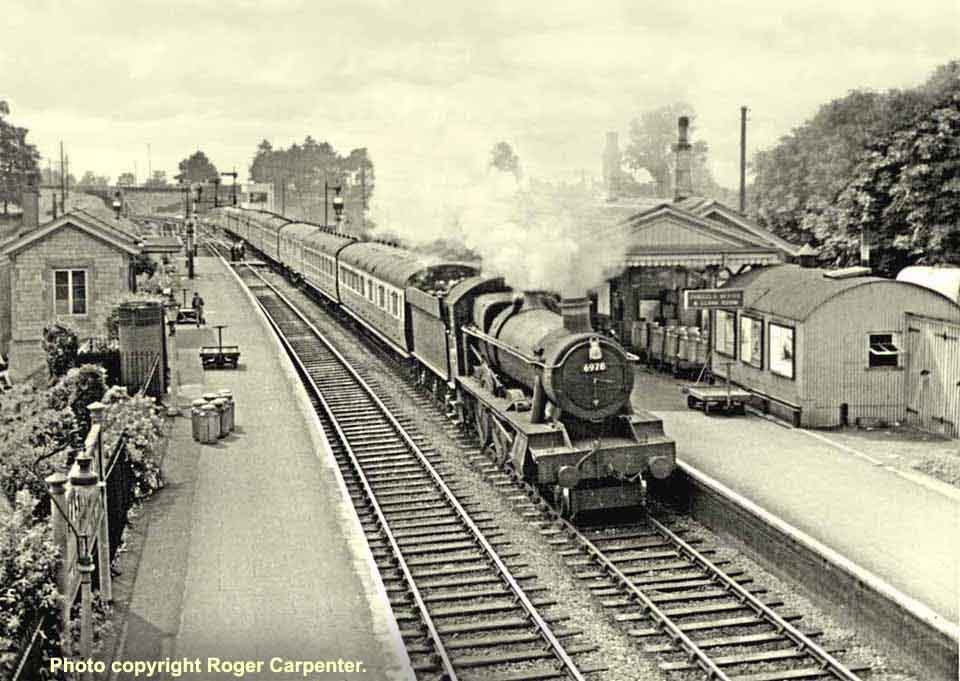
(Above) Castle Cary station originates from September 1856 as part of the line from Swindon to Weymouth via Westbury. With the opening of the new Stert & Westbury line in 1900, Castle Cary could now be reached in less than four hours from Paddington, which, at best, led to almost an hour being cut from some express train schedules to a journey time of just 3 hours and 10 minutes. When the link from Castle Cary to Cogload via Long Sutton & Pitney was opened in 1906, the status of the station was  significantly elevated with some expresses to and from Devon and Cornwall stopping here in addition to those serving Weymouth. Here 'Modified Hall' No 6978 Haroldstone Hall brings an eastbound train into Castle Cary station in the early 50's; this 8-car semi-fast is possibly the 1.40pm SX Weymouth-Westbury, due here at 3pm. A Westbury engine from new in November 1947, No 6978 was transferred to Laira (83D) in December 1953 and later assigned to Old Oak Common (81A) for close on seven years before completing its service in South Wales. Just visible beyond the station is the divergence of the line to Yeovil and Weymouth which curves left whilst the cut-off line to Cogload and Taunton continues straight ahead beneath the A371 road bridge. Photo Joe Moss collection, distributed by Roger Carpenter.
significantly elevated with some expresses to and from Devon and Cornwall stopping here in addition to those serving Weymouth. Here 'Modified Hall' No 6978 Haroldstone Hall brings an eastbound train into Castle Cary station in the early 50's; this 8-car semi-fast is possibly the 1.40pm SX Weymouth-Westbury, due here at 3pm. A Westbury engine from new in November 1947, No 6978 was transferred to Laira (83D) in December 1953 and later assigned to Old Oak Common (81A) for close on seven years before completing its service in South Wales. Just visible beyond the station is the divergence of the line to Yeovil and Weymouth which curves left whilst the cut-off line to Cogload and Taunton continues straight ahead beneath the A371 road bridge. Photo Joe Moss collection, distributed by Roger Carpenter.
At 9.15am on the morning of Thursday 3 September 1942, a squad of Luftwaffe Junkers 88 bombers raided the junction at Castle Cary as part of Germany's attempt to disrupt Britain's vital railway network. Several buildings and business premises were badly damaged but the railway was up and running again by 11pm that same evening.
During a six week period, four separate bombing raids were carried out on Templecombe, Somerton and Chard Junction; the signal box at Castle Cary was totally destroyed and a temporary box was hastily assembled at the GWR's signal works at Reading and installed at the junction two days later; this was later replaced by a brick-built box on 27 October, by which time repairs to the track had been completed and the GWR's train services fully restored.
During World War 2 Castle Cary was considered by the military to be a strategic railway junction serving the large naval base at Weymouth, however fast-forward to the present day, and Castle Cary station has come under siege in a quite different way.
Once a year this normally quiet country junction is besieged by thousands of passengers visiting the world-famous Glastonbury Festival just eight miles away at Worthy Farm between the small villages of Pilton and Pylle, six miles east of Glastonbury.
Regarded as a major event in British culture, the five-day festival has grown into the largest annual open air event of its kind in the world, attracting headline acts, large crowds and extensive media coverage. During the five-day festival, additional trains are provided and a fleet of special buses run from Castle Carey station to the festival site, all requiring extra attention by staff at South West Trains and the Great Western Railway.
Beyond Castle Cary, the opening of the 15½ mile-long cut-off line to Cogload Junction was the final missing link in creating the Great Way West. The line passes through attractive Somerset countryside and the stations of Alford Halt 117½ miles, Keinton Mandeville 120 miles, Charlton Mackrell 122 miles, Somerton 125¾, miles, Long Sutton & Pitney 128 miles and finally Langport East 130 miles. During its construction in 1906, the most notable engineering features were the high viaduct across the River Cary and the 1,053 yard-long Somerton Tunnel.
The original level junction at Cogload was where the lines from Bristol and Castle Carey converged, therefore careful control was required to avoid the conflicting movement of up trains to Paddington from Taunton, and down trains from Bristol. This was remedied in 1932 by yet another cut-off line, just 3 miles long, involving the construction of a flyover that carried the down Bristol track across both the up and down Paddington lines.
Beyond Cogload the line was quadrupled for almost six miles and included the installation of water troughs serving all four tracks just before reaching Creech St. Michael station.
Five miles from Cogload we eventually arrive at Taunton (143 miles from Paddington) a major station dating from July 1842, where most of the through trains from the Midlands and Paddington changed engines and crew. The Chard branch also joined here, therefore each day there was a mixture of express passenger locomotives and smaller engines including SR locos for the Barnstaple branch. Taunton consisted of nine platforms: two down platforms, numbers 1 and 5, and two up platforms, numbers 6 and 7. The other five were bay platforms for the branch trains.
(Below) This view of the Castle Carey Junction from the A371 road bridge shows 'Hall' class No 5974 Wallsworth Hall of Westbury (82D) departing on the line to Weymouth with a semi-fast train for Yeovil on Saturday 10 September 1955. No 5974 was almost exclusively assigned to Westbury depot right up to late 1964 before it moved to Severn Tunnel Junction, its final resting place. Photo RK Blencowe Ref EFG374.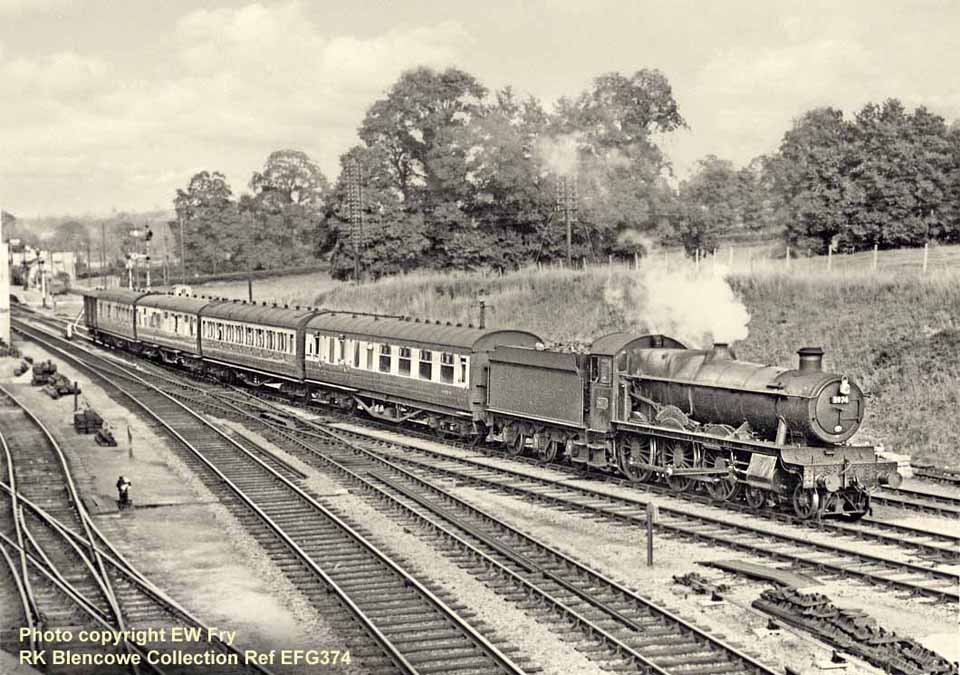

(Above) One of Laira's indomitable 'King' class locomotives, No 6017 King Edward IV, heads the 6.25am Penzance - Paddington through Keinton Mandeville station; the train is due to pass here about 12.55pm with a scheduled 2.50pm arrival at Paddington. This was the first express of the day from Penzance to London, having extra coaches added at Plymouth including a restaurant car. Many stretches of the route from Savernake (70 miles out from London) to Taunton (142¾ miles) enabled the 'King' and 'Castle' Class locos to show their speed capabilities. OS Nock tabulated many such runs over the years and they are detailed in his fine book 'Locomotive Practice and Performance' published by Patrick Stephens Ltd.
(Below) A fitting testimony to the very fast running on the GWW through Somerset can be found in this shot of 'King' class No 6008 King James II of Laira speeding through Keinton Mandeville station on Monday 9 September 1957 with train 130, the down Cornish Riviera Limited, due to pass here about 12.27pm. Closed on 10th September 1962, Keinton Mandeville station was situated 120 miles from Paddington, 22¾ miles before Taunton on the GWR's newly-built line from Castle Cary to Curry Rivel. Opened on 21 July 1906, this 15¾ mile stretch enabled the GWR to cut as much as 20 minutes off the journey time between Paddington and Taunton. With this final section known as the Langport cut-off, and with Keinton Mandeville 5 miles west of Castle Cary, the Great Western Railway was finally able to rebut the jibe that the company's initials GWR stood for the Great Way Round!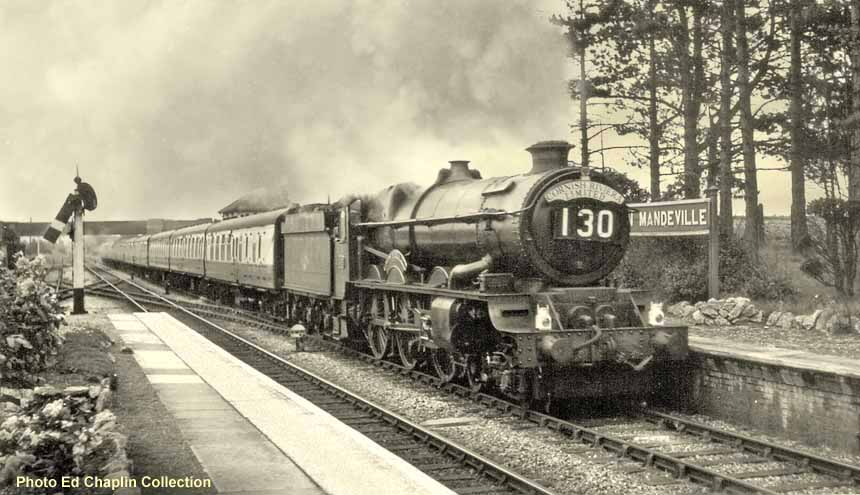
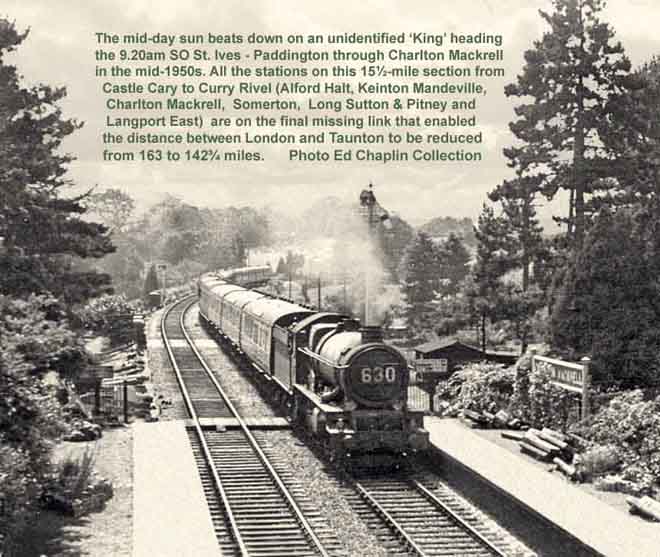
(Above) 'King' class No 6016 King Edward V speeds through Charlton Mackrell at the head of train 630, the 9.20am SO St Ives - Paddington, due to pass here about 12.55pm, however the engine crew still have another 122 miles still to go before their estimated 4.40pm arrival at Paddington. After closure on 10th September 1962, there is very little evidence remaining of the six railway stations (Alford Halt, Keinton Mandeville, Charlton Mackrell, Somerton, Long Sutton & Pitney, and Langport East) built on this 15½ mile section from Castle Cary to Curry Rivel. This section of track was the final link that reduced the distance between Paddington and Taunton section by over 20 miles from just over 163 to 142¾. (Editor's note: recognition of the engine was difficult, but perceived under close scrutiny. Dated from 1950).
(Below) Speeding through Long Sutton & Pitney station, the crew of 'Hall' class No 6954 Lotherton Hall of 82B St. Philips Marsh still have 127¾ miles to go before arrival in London with train 540, the 1.45pm SO Paignton - Paddington, due to arrive there at 6.15pm. Often this train was made up of 13 coaches but it looks a little less on this unknown Saturday in the mid-50s. No 6954 was based all of its life in Bristol with either 82A Bath Road or 82B being its home shed. Withdrawal took place in May 1965. Long Sutton & Pitney station (closed 10th September 1962) was situated midway along a 4 mile section of straight track with eastbound gradients of 1 in 264 and 1 in 330, allowing fast running in both directions. Photo RHG Simpson. 
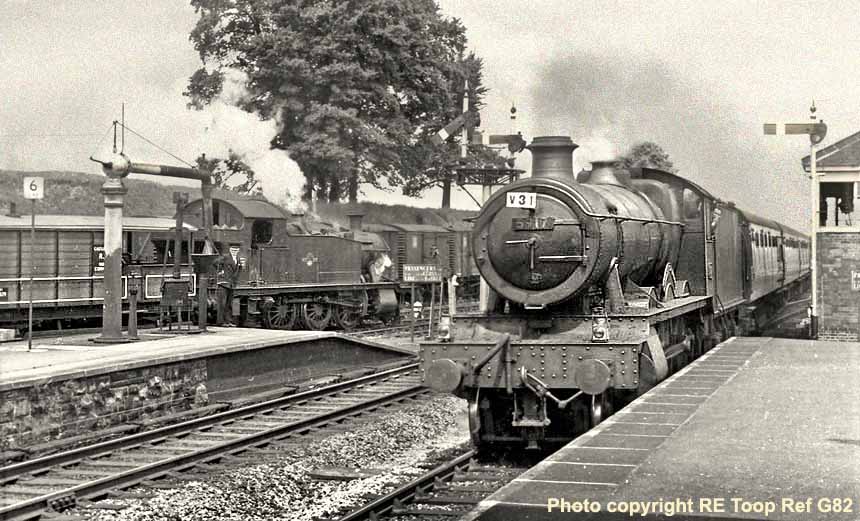
(Above-Below) Durston was where the single track line from Yeovil, Langport, Curry Rivel and Athelney, met the original West of England main line via Bristol. This branch dates from 1853, being part of the very early line built between Taunton and Weymouth. Here are two shots taken on Saturday 2 June 1962, the first showing Laira's 'Hall' class No 5917 Westminster Hall entering Durston station from the Bristol direction at the head of train V31, the 7.43am SO Nottingham - Plymouth; in the background 2-6-2T No 5563 of 72C Yeovil Town awaits clear signals to cross the main line for the line to Yeovil. (Below) South of the station, 4932 Hatherton Hall of Taunton hauls a down fitted freight towards the Cogload flyover. Photos RE Toop Ref G82 and G87.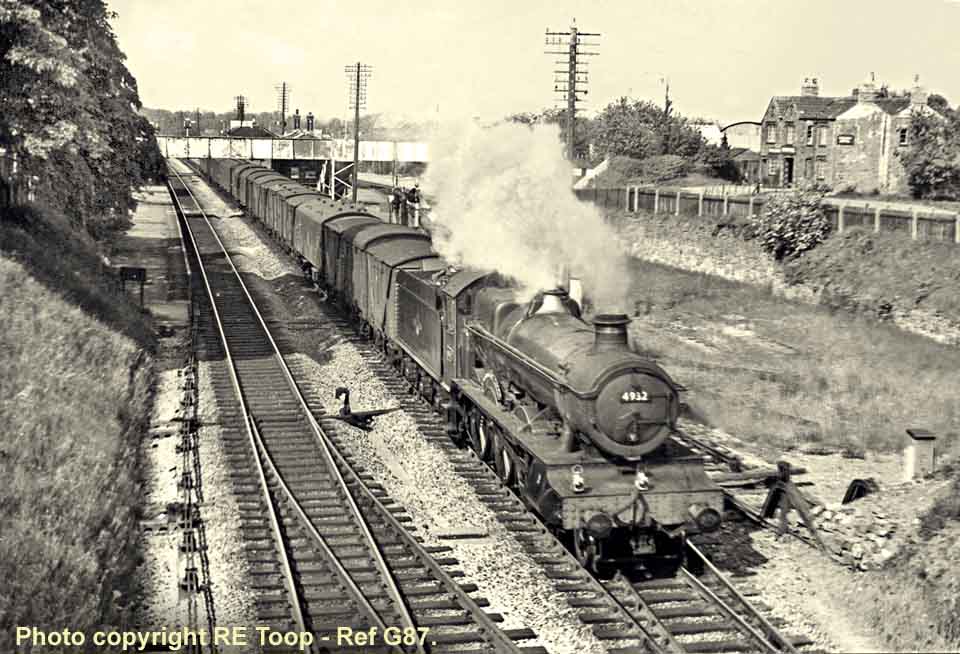
(Below) Cogload is where the line from Bristol is joined by the line from Castle Cary and the start of a 4-track section for 6¾ miles to Norton Fitzwarren. At Cogload the original 2-track layout was rearranged, so that the Down Bristol line uses a flyover that crosses the line from Castle Cary and then runs alongside towards Creech St. Michael and Taunton. The distance to Cogload Signal Box from London Paddington on the original GWR route via Bristol was 158 miles, whereas the shorter Berks & Hants line is 138 miles and 11 chains. In the Up direction, the line to Bristol bears left towards Durston and Bristol. So at Cogload, from top to bottom, the 4 lines are Up Bristol main, Up London main, Down London main, Down Bristol main. There are water troughs on all lines at Creech St Michael, 2 miles west of Cogload, 2½ miles before Taunton. 
(Below) Displaying an abundance of steam, 'Hall' class No 6900 Abney Hall of 82A Bristol Bath Road depot, approaches Durston from the west with train 558, the 10.35am SO Paignton-Wolverhampton on Saturday 28 June 1952; note the down line climbing to the flyover in the foreground.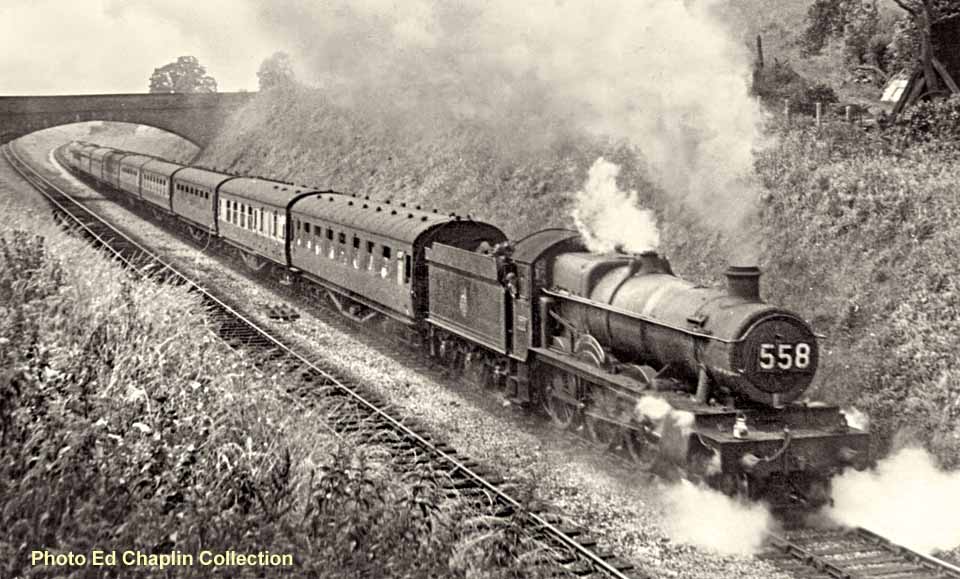
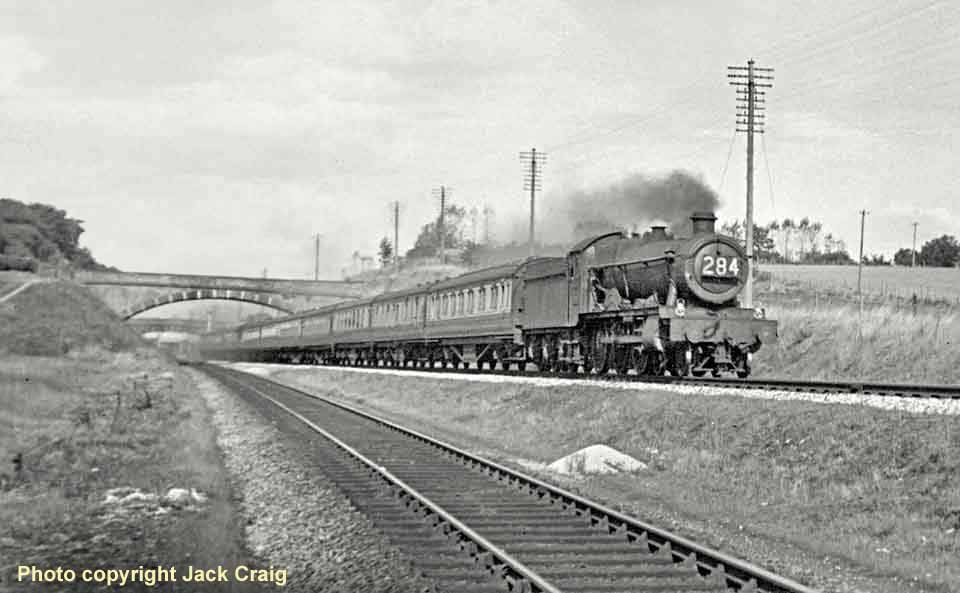
(Above) Another classic Jack Craig shot of trains passing through Somerset on Saturday 10 September 1955. Here 'Hall' class No 4923 Evenley Hall of Old Oak Common (81A) sprints towards the flyover at Cogload Junction with train 284, the 8.45am SO Liverpool - Penzance. Completion of the skewed Warren Truss girder bridge in 1931 gave rise to the name 'flying junction' being applied and allowed the speed limit to be raised to 90mph. Photo JM Craig.
(Below) 'Grange' class No 6848 Toddington Grange of 83B Taunton heads the front 5-car portion of the 11.15 ex-Paddington Merchant Venturer just yards before the flyover junction on Saturday 10 September 1955. The engine is carrying the correct train reporting number 142, which it took on from an Old Oak Common 'Castle' or 'King' class at Bristol Temple Meads. On Mondays to Fridays this train was made up of nine carriages and terminated at Weston-super-Mare, whereas on holiday Saturdays an additional five coaches were attached at Paddington to establish an onward portion extended to Taunton. (Editor' note: with the extra coaching stock on the drawbar (making up a trainload of 14 on a Saturday) the power resources of one of the 30-strong 'King' class 8Ps was required between London and Bristol). Photo JM Craig.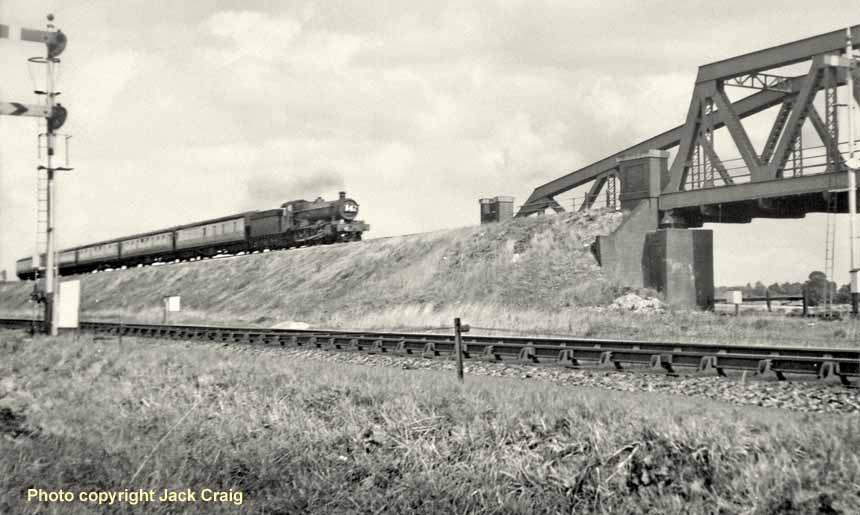
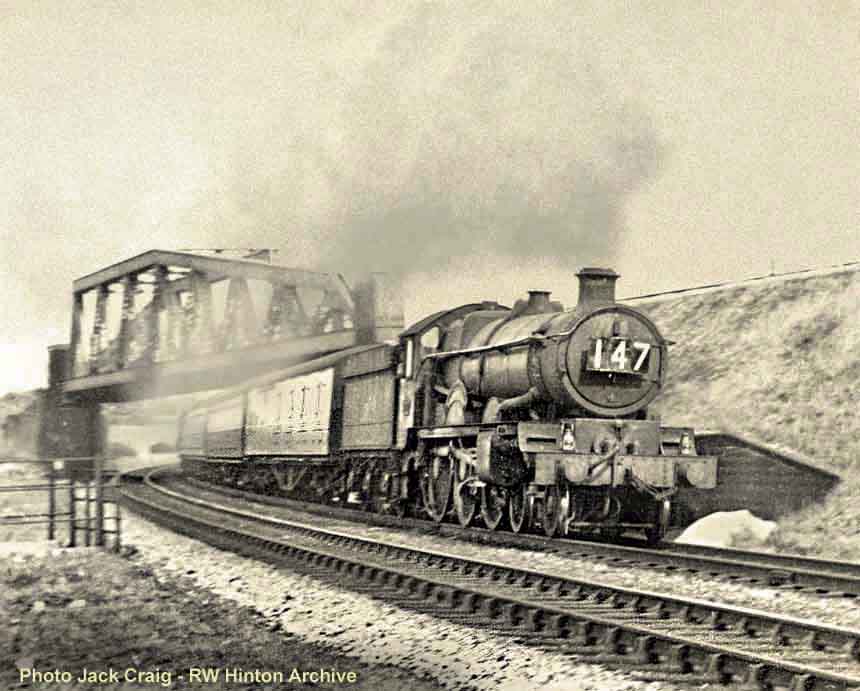
(Above) Old Oak Common's 'Castle' class No 5044 Earl of Dunraven passes beneath the flyover with train 147, the 12.05pm SO Paddington - Plymouth, on Saturday 10 September 1955; this service was scheduled to stop only at Newbury to pick up before here. Photo JM Craig, RW Hinton archive.
(Below) 'Hall' class No 5999 Wollaton Hall of 83B Taunton heads train 537, the 10.35am SO Paignton - Wolverhampton on the up Bristol line on Saturday 10 September 1955. Controlling this vital junction is Cogload Signal Box, just visible above the rear of the train. As they say, 'never a dull moment' for the men working in the box, particularly on a busy Saturday. Photo JM Craig, RW Hinton archive.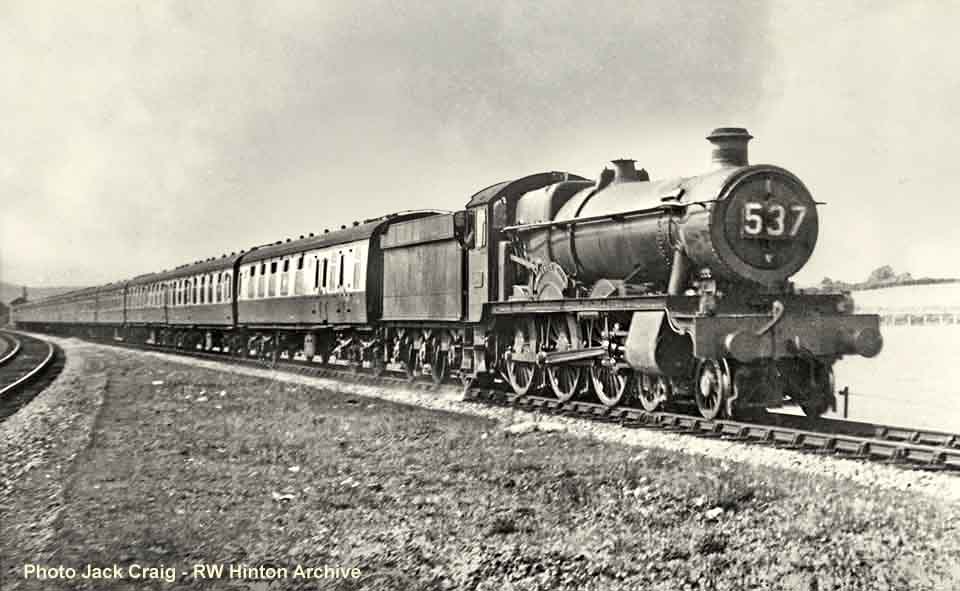
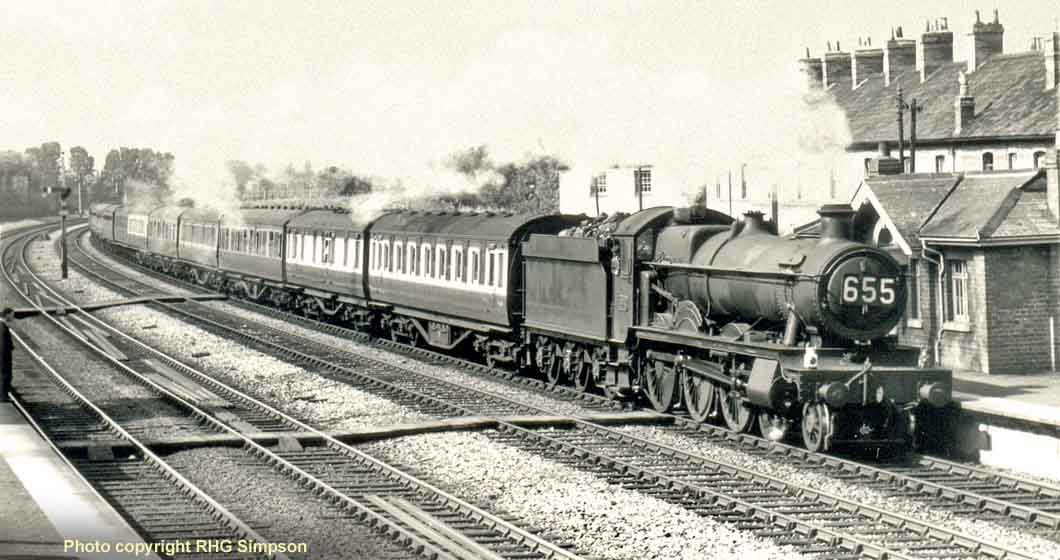
(Above-Below) On Saturday 13 September 1952, 'Hall' class No 5973 Rolleston Hall of 81D Reading shed, hurries through Creech St Michael Halt with train 655, the 7.50am SO Newquay-Manchester (London Road), due to pass here about 12.35pm; this train was routed via the Severn Tunnel to Shrewsbury. Photo RHG Simpson. (Below) Due thirty minutes behind the 'Hall' on train 655 is the final member of the 'Castle' class, No 7037 Swindon of 82C Swindon shed heading the 7.30am SO Penzance-Wolverhampton. The engine displays the Arms of the Borough of Swindon on the centre splasher plus a commemorative plate adorns the cabside in respect of HRH Queen Elizabeth who carried out the naming ceremony. This is a good example of the mixed rake of carriages that holiday extras used. Photo RHG Simpson. 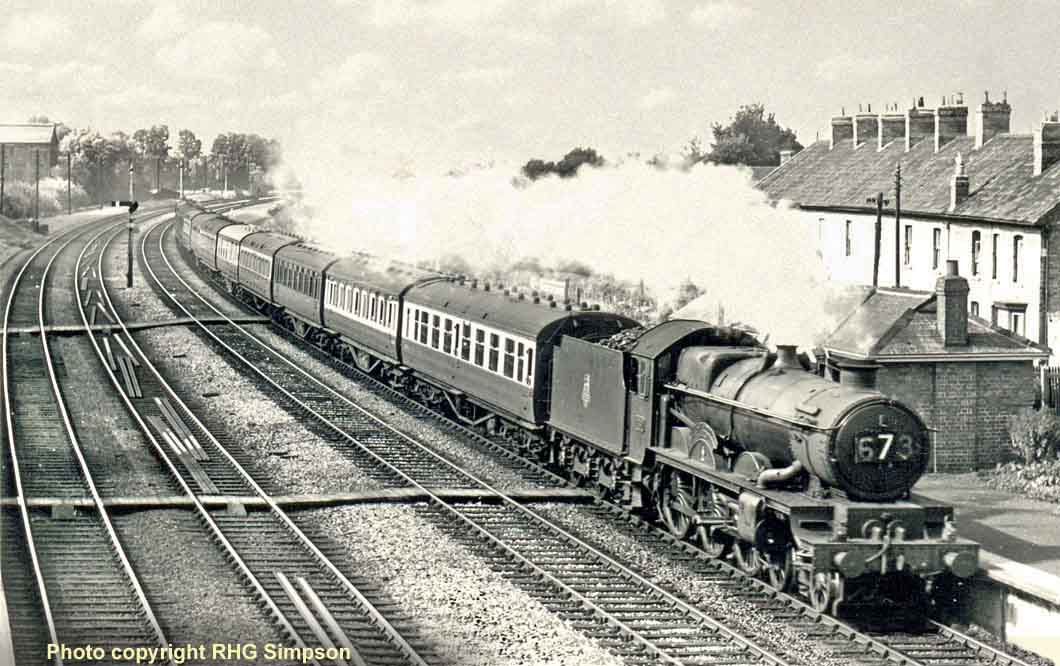
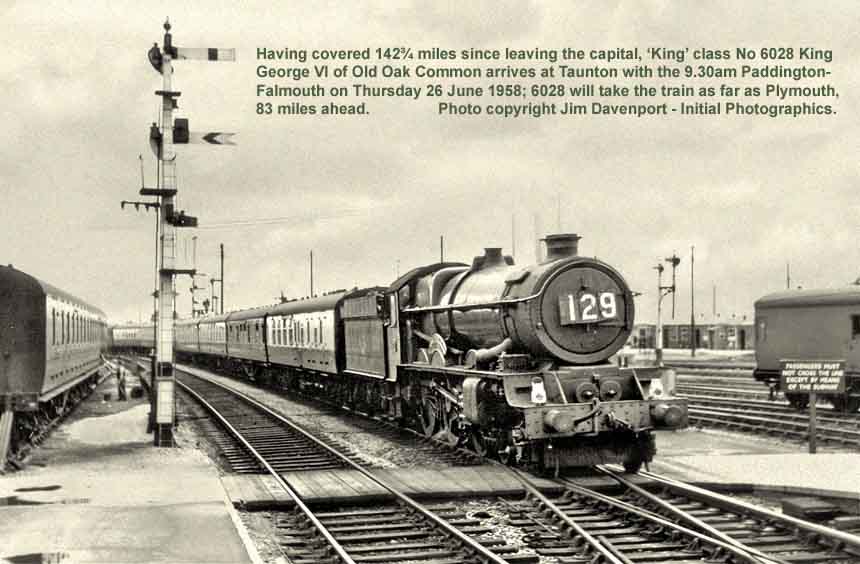
(Above) 'King' class 6018 King Henry VI of Old Oak Common approaches platform 1 at Taunton with the 9.30am Paddington-Falmouth on Thursday 26 June 1958. (Editor's note: the detail on the reverse of this photo wrongly identifies the locomotive as being No 6028 King George VI, hence the caption in the sky. But this is incorrect, as the inside valve covers have not been extended. A full history of the BR modifications on the 'King' class locomotives, including 6028, can be found on Page 24 HERE). Photo Jim Davenport, Initial Photographics.
(Below) On Saturday 22 August 1953, 'Hall' class No 5932 Haydon Hall of Old Oak Common slows for its obligatory stop at Taunton's platform 5 at the head of the 12.05pm SO Paddington-Plymouth, due to arrive here about 2.45pm. The rather scruffy appearance of the locomotive is not aided by the poor state of the reporting number, doubtless from the bottom of the pile thus rarely used. Photo JM Craig.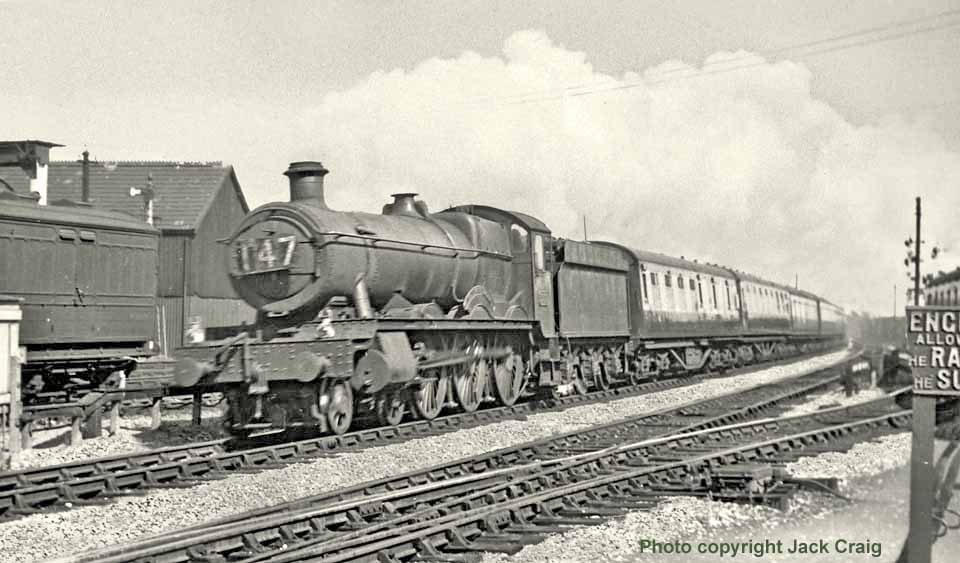
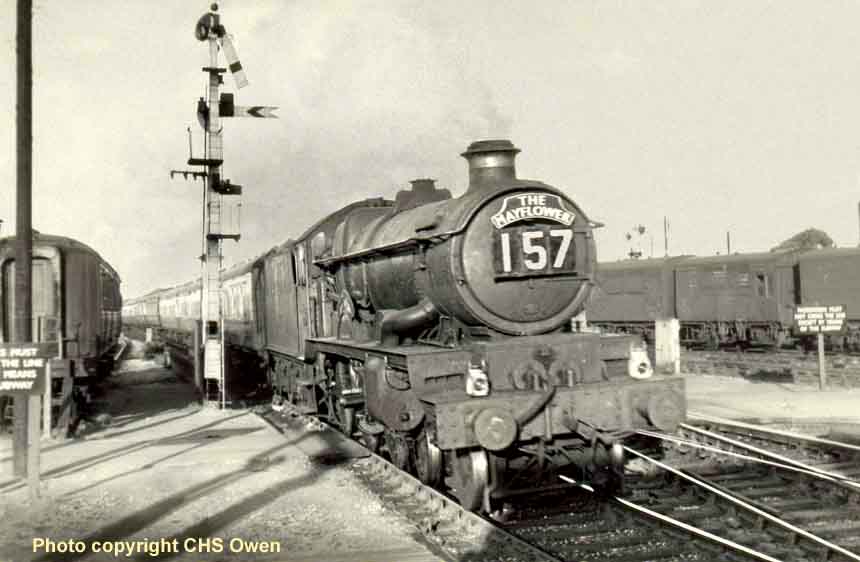
(Above) Having spent many years based at Cardiff Canton, the arrival of the first of twelve non-Canton 'Britannias' in December 1956 led to 'Castle' class No 5099 Compton Castle being transferred to Old Oak Common. Here No 5099 enters Taunton with the down 'Mayflower' on Friday, 21 June 1957; the 'Mayflower' made its debut earlier in the week at the start of the WR's 1957 Summer Timetable on Monday 17 June, departing Paddington at 5.30pm with its first scheduled stop here at Taunton at 7.57pm. After four minutes it will resume its journey with only one other stop at Exeter St. David's before arrival at Plymouth by 10pm. At Exeter (8.37-8.42pm if on time) a rear portion will be detached to call at key stations in South Devon before its 10.15pm arrival at Kingswear. The Plymouth portion covered 225½ miles, the Kingswear one 208½. Photo CHS Owen.
(Below) 'Hall' class No 5936 Oakley Hall, new in July 1933, awaits departure from Taunton with train 520, the 12 noon SO Ilfracombe-Paddington in the late 1930s. The seaside resort of Ilfracombe on the north Devon coast was situated in Southern Region territory at the end of the branch from Norton Fitzwarren to Barnstaple and beyond. No 5936 has taken over from whatever SR loco brought the train in, and is scheduled to cover the 142¾ remaining miles of the journey to Paddington in five hours. Photo RK Blencowe Ref 21922.
(Below-Inset) 'Castle' class No 7007 Ogmore Castle pauses at Taunton's platform 7 with train 565, the 3.05pm SO Paignton-Wolverhampton during the summer of 1947. No 7007 has the distinction of being the last 'Castle' built by 'The Company' in July 1946. To the pleasure of many, in January 1948 - the same month the 'Big Four' railway companies were nationalised - the engine was renamed 'Great Western' to 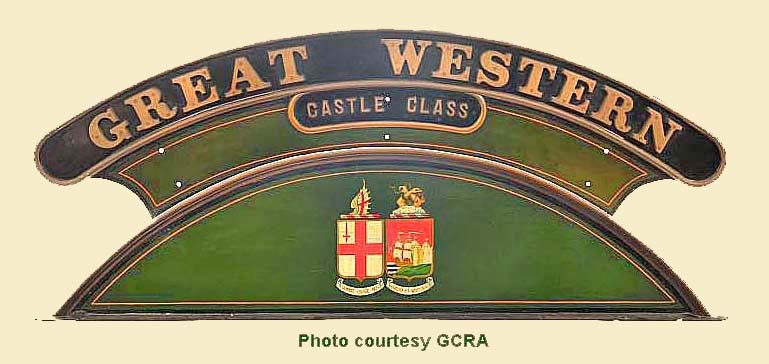 commemorate the passing of the old GWR and the splasher beneath the nameplate was embellished with a crest depicting the coats of arms of the cities of London and Bristol as a reminder of the committees in both cities responsible for founding the company.
commemorate the passing of the old GWR and the splasher beneath the nameplate was embellished with a crest depicting the coats of arms of the cities of London and Bristol as a reminder of the committees in both cities responsible for founding the company.
The engine was first based at Wolverhampton Stafford Road (SRD) then PDN (Old Oak Common) in September 1948. Finally, from February 1950 it was based at Worcester until withdrawal in February 1963. Sadly 7007 was not preserved. This photo clearly shows the unusual box fitted to just five 'Castles' 7003-7 in their earliest years; it was used to measure the degree of superheat within the new three-row elements. The GCRA image (inset) shows the nameplate displayed on an original Castle Class splasher, with the GWR coat of arms added. This Lot was accompanied by a considerable volume of correspondence between the late owner and Swindon Works regarding the purchase of the nameplate and the splasher. 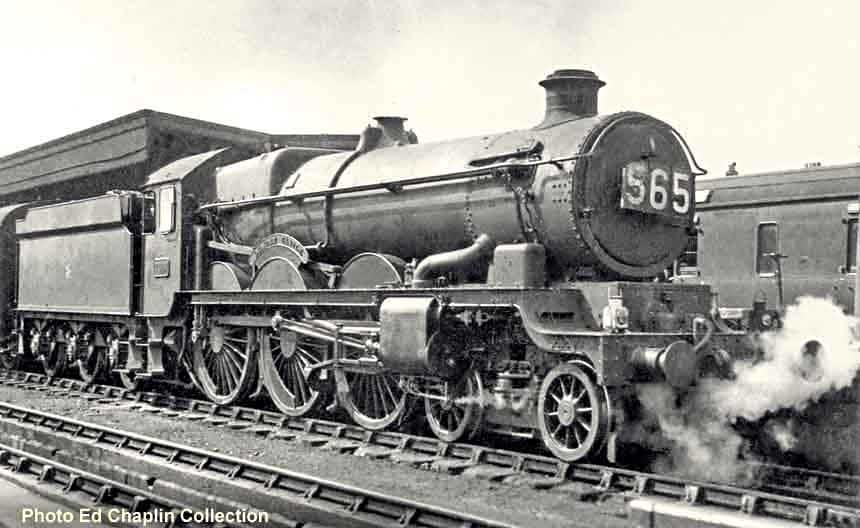
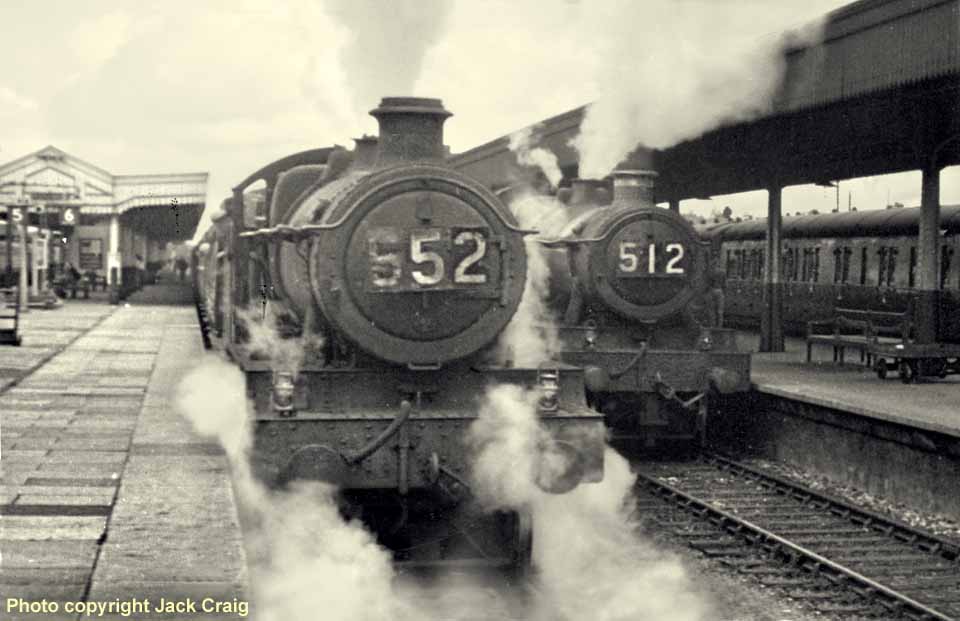
(Above) On Saturday 3 September 1955, a scruffy pair of locomotives are keen to leave Taunton, but with different paths ahead. On the left, 'Grange' class No 6863 Dolhywel Grange of 82B St. Philips Marsh shed is awaiting departure from platform 6 with train 552, the 10.15am SO Teignmouth-Bradford, due to leave here at 11.28am its next stop Bristol. On the right, 'Hall' class No 4932 Hatherton Hall, a long-term resident of 83B Taunton, rests at platform 7 having just replaced the branch loco on train 512, the 10.40am SO Minehead-Paddington, due to leave here at 11.46am for Castle Cary and the direct route to Paddington. Photo JM Craig.
(Below) On Saturday 4 September 1954, one of Churchward's mighty 2-8-0s, No 4703 of 82B St. Philips Marsh shed, is seen to be helping out the operating department, which was often the case on a busy Summer Saturday. At weekends the Western Region frequently struggled to find a sufficient number of engines to deal with the huge increase in holiday passenger trains, and No 4703 has been called upon to supplement the shortfall. Positioned at platform 6, train 573 is the 10.58am SO Paignton-Nottingham, which No 4703 will haul the 45 mile-run to Bristol, where a London Miidland Region loco will take the train forward. Photo JM Craig, RW Hinton archive. 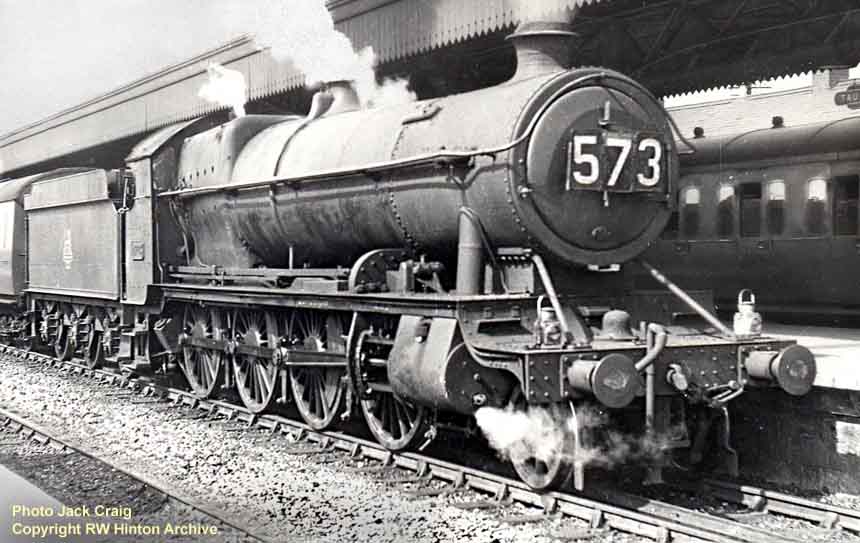

(Above) It is nearly 4pm on Monday 25 April 1960, one week after Easter Monday, and a superbly turned out 'Castle' No 5050 Earl of St. Germans of (84G) Shrewsbury shed calls at Taunton's platform 5 with train 436, the 9.05am Liverpool-Plymouth. Built in May 1936, No 5050 was first named Devizes Castle, but renamed fifteen months later to Earl of St Germans - a title in the United Kingdom peerage created in 1815, which takes its name from the village of St Germans in Cornwall. The engine spent 12 years as a Shrewsbury-based engine from September 1948 to September 1960, and this particular train 436 was one of the shed's regular duties - a Newton Abbot double home turn. For a time No 5050 ran with one of the coal-weighing tenders but today it is coupled with a Hawksworth straight sided tender. No 5050 was withdrawn from traffic in September 1963 after a mileage of 1,135,797. Photo Ben Brooksbank.
(Below) On Saturday 4 September 1954, 'Hall' class No 4970 Sketty Hall of 83B Taunton and BR 'Britannia' 7MT No 70016 Ariel of 83D Laira have just arrived at Taunton's platform 5 with train 153, the 3.30pm Paddington-Penzance, due here at 6.02pm. The Class 7MT Pacific will most probably continue alone and face the climb of Wellington bank unaided, since No 4970 will be detached here; the engine is now back at its home base having taken the 9.05am ex-Minehead up from Taunton that morning, due Paddington at about 1.10pm. Photo JM Craig. 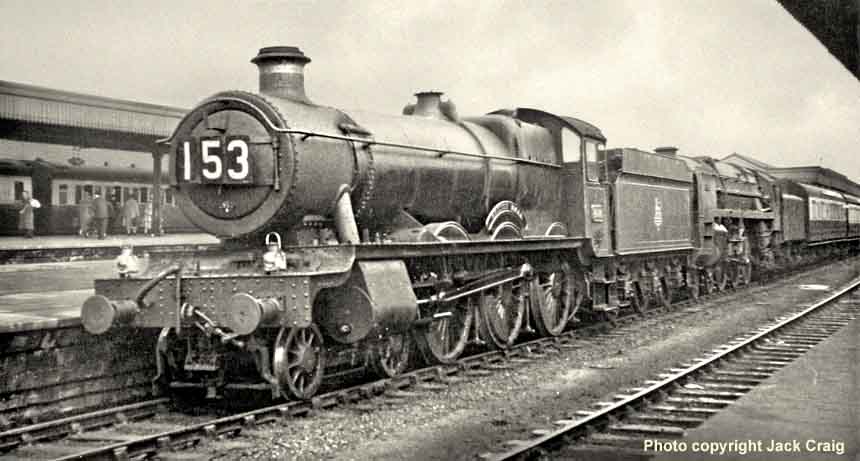
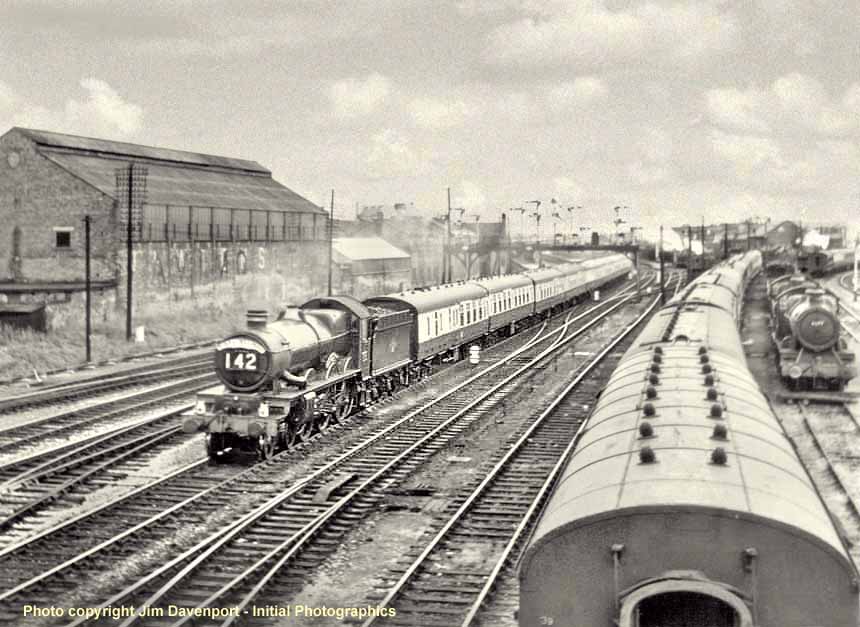
Above) On Thursday 26 June 1958, the 12noon Paddington-Kingswear Torbay Express heads non-stop through Taunton, due to pass here just before 2.30pm with its first stop at Exeter St. David's timed at 2.52pm, and arrival at Kingswear at 4.10pm. Today it is headed by 'Castle' class No 5078 Beaufort of Newton Abbot (NA and 83A), which was its home shed since 1942. However, within a month from now it will be transferred to Landore (87E). In December 1961, No 5078 was the very last Castle to be fitted with a double chimney, yet no sooner had this been done and it was put into storage! Amazingly it then went back into traffic to help out with the Summer service in May 1962, but by mid-November 1962 it was withdrawn and stored again. The photo was taken from the 'forty-steps' footbridge by Jim Davenport.
The increase in holiday traffic heading for Devon and Cornwall led to congestion on a huge scale on the 30¾-mile section west from Taunton to Exeter; this was particularly bad during a Bank Holiday weekend or on a Summer Saturday when the volume of traffic doubled. The operating department had to find ways of accommodating the increase in extra trains from Paddington along with the influx of summer holiday traffic from  the North and Midlands via Bristol.
the North and Midlands via Bristol.
This was manageable on the 1931-built section of quadrupled track from Cogload Junction to Taunton, but two miles beyond Taunton the four-tracks were reduced to just two at Norton Fitzwarren, a little after MP165. The tracks were paired by direction, with 'up' trains using the two northernmost lines and 'down' trains the southernmost pair, thus allowing express trains to overtake a slower goods or local passenger train using the outer lines; the semi-fast trains for Minehead and Ilfracombe used the outer relief lines, each having their own junction with the main line.
After passing Norton Fitzwarren engine crews now face the steepest gradient since leaving Paddington; a nine-mile climb to the summit of Wellington Bank where they will cross the Somerset-Devon border inside Whiteball Tunnel.
Wellington Bank is perhaps best known for the quite remarkable 102.3mph world speed record attained by Churchward's GWR 3700 Class 4-4-0 No 3440 City of Truro during its fast downhill run on May 9th 1904. It happened a little over a year after the engine rolled off the production line at Swindon in April 1903; No 3440 picked up a mail train comprised of five eight-wheeled postal vans at Plymouth for delivery to London and during its descent of Wellington bank it reached a top speed of 102.3mph. Not surprisingly, No 3440 became something of a celebrity in its lifetime and a natural choice for preservation after withdrawal from service in March 1931.
Westbound trains pass Wellington station at speed, with the MP170¼ post on the up platform, and the climb now stiffens noticeably with sections of 1 in 90, 1 in 86 and 1 in 80 before it eases off on a stretch of 1 in 127 for the final three-quarters of a mile through Whiteball Tunnel and the first glimpse of Devon.
All the heavily-loaded Saturday trains were assisted by either a banker at the rear or a pilot engine at the front. The assisting engines were attached either at Taunton or Wellington and came off after reaching Whiteball Siding Signal Box at MP174, then awaited a clear road to cross to the up line for the run down the bank in readiness for their next duty.
After topping the summit there is a downhill run of 20 miles to Exeter, passing stations at Burlescombe, Sampford Peverell and Tiverton Junction where there is a one-mile stretch of uphill gradient with 1 in 207 at its steepest. Tiverton Junction station was widened to four tracks in 1932 and two new platforms built for the loop lines allowing non-stop running on the centre tracks. The divergence of two branches either side of the station are to Tiverton town to the west and the 7½ mile Culm Valley branch to Hemyock to the east. Milk tanks from these branches were brought here on local trains headed by 0-4-2T engines. The up milk trains such as the 12.20pm from Penzance called here at 7pm to collect tank wagons and at least two other milk trains followed during the night and attached milk tank wagons for delivery to the London area depots. Of course, a reverse operation with the empties took place here daily too.
The Tiverton branch closed to passengers in 1964 and freight in June 1967, and the Culm Valley line closed to passengers on 7 September 1963, although the line remained in use for goods trains until 31 October 1975. The Junction station was closed on 11 May 1986.
Heading west from Cullompton to Exeter St. David's there is a gentle downhill run for the next twelve miles where we pass country stations at Hele & Bradninch (MP185½) and Silverton (MP186¼) followed by Stoke Canon (MP190½); a junction station for the Exe Valley branch. As with most stations between Taunton and Exeter, the platforms at Stoke Canon were moved apart in 1932 to accommodate new 'up' and 'down' loops, and the branch was given its own 'up' platform so that trains did not intrude on traffic using the loop. The station closed to passengers on 13 June 1960 and 5 years later goods traffic discontinued in May 1965.
At Cowley Bridge Junction (MP192½) the SR line from Ilfracombe and Okehampton joins the GWW from the north, and the 1¼ miles between here and Exeter St David's station is something of a bottleneck since holiday and local trains of both the Southern and Western Regions using the same double-track line. It is also of interest that SR trains going to London (Waterloo) pass here going south on the WR 'down' line, while the WR trains going to London (Paddington) pass here going north on the 'up' line; indeed unsuspecting passengers arriving for a train at Exeter St. David's station need to listen out carefully for announcements or read the signs to ensure they get on the right platform for their journey. 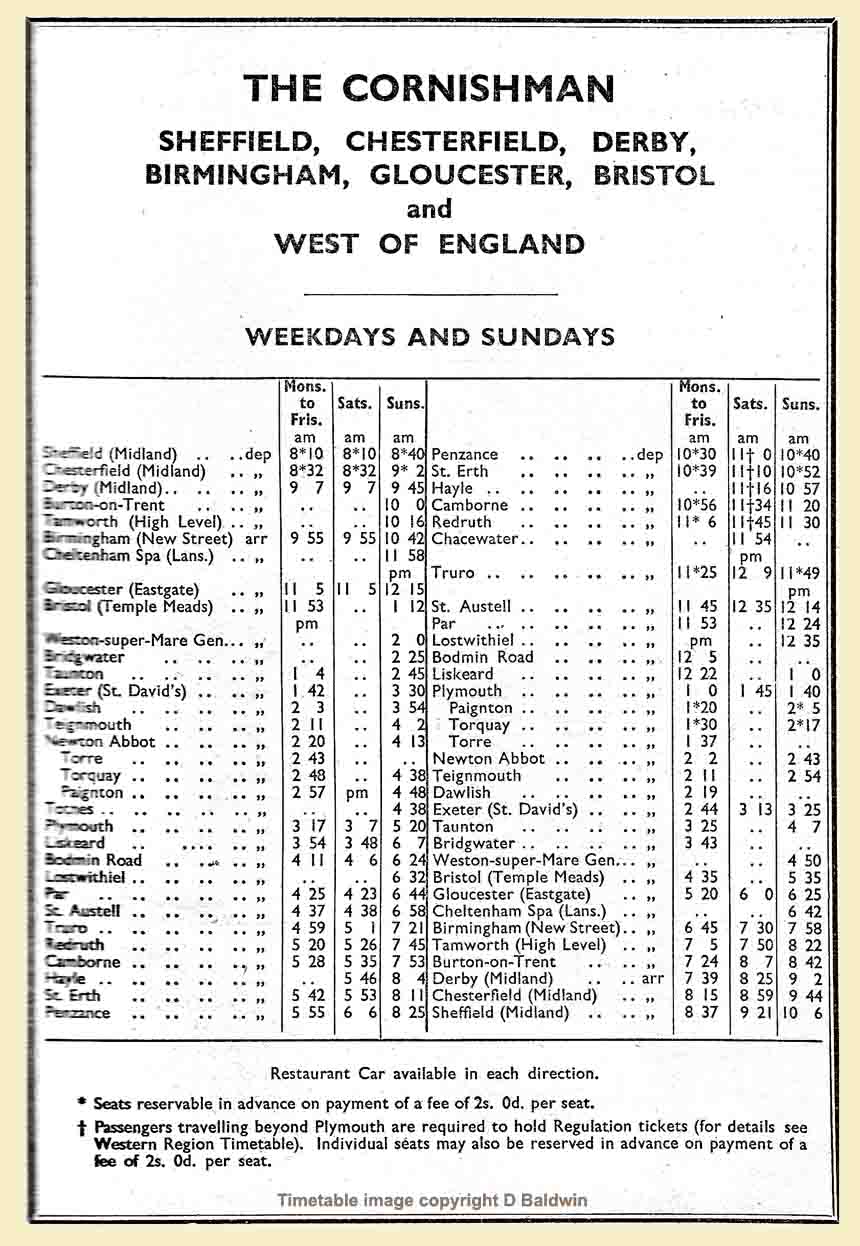
(Above-Below) The timetable is reproduced from the London Midland Region's book of 1963 Summer Timetables - 17th June to 8th September 1963. (Below) On Thursday 26 June 1958, 'Hall' class No 6926 Holkham Hall of 84A Stafford Road, approaches Taunton with the northbound 'Cornishman'. After its brief 3.01-3.05pm stopover at platform 6, No 6926 will have a brisk 45-mile non-stop run to Bristol where it is timed to arrive in 58 minutes, however the train will not hand over to an LMR locomotive at Temple Meads, it will be using the LMR tracks via Staple Hill and Mangotsfield through to Gloucester (Eastgate) due there at 5.03pm. It will then return to WR tracks and call at Cheltenham Spa, Stratford-on-Avon, Birmingham (Snow Hill) before terminating at 6926's home town of Wolverhampton at 7.25pm. Photo Jim Davenport Initial Photographics.
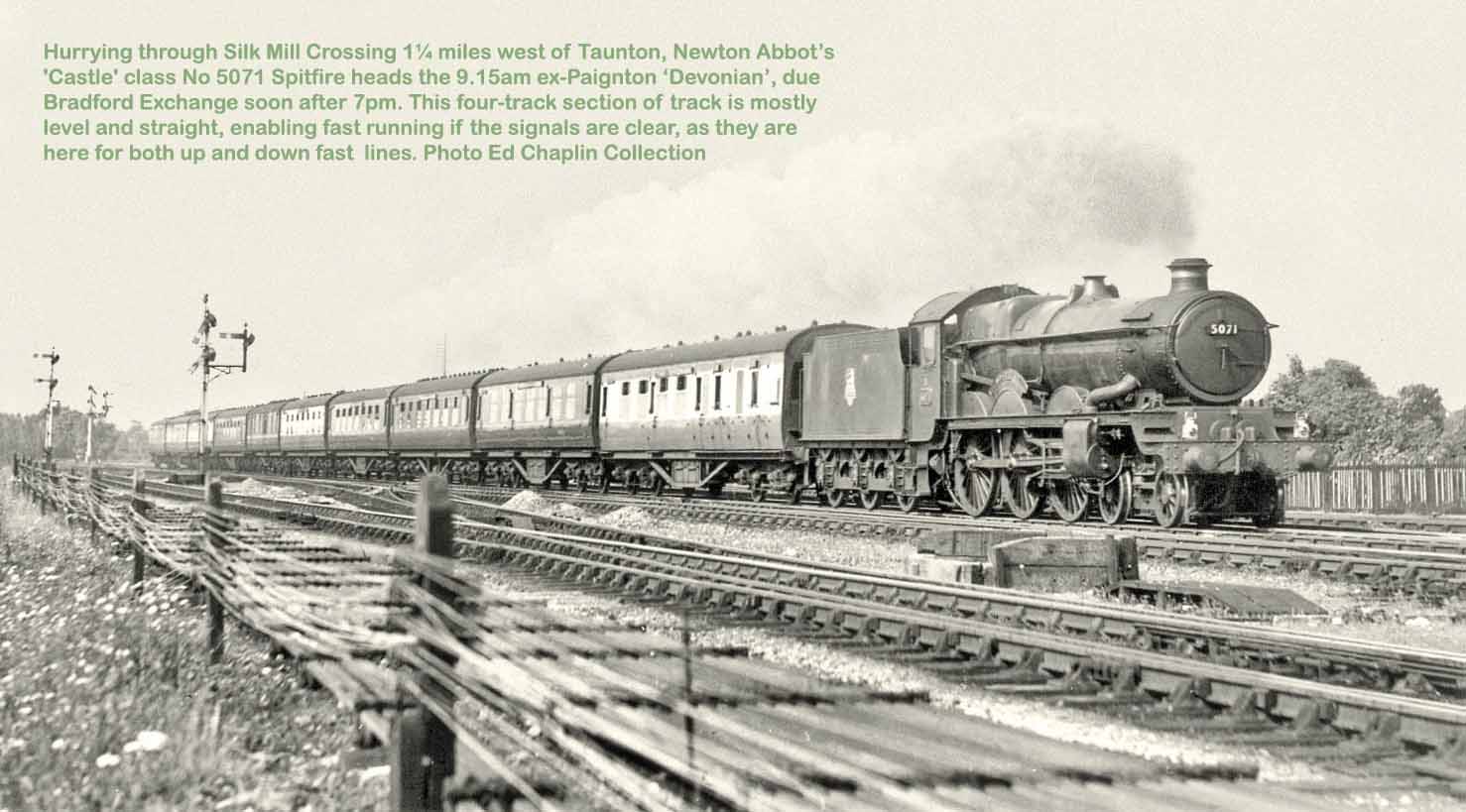
(Above-Below) At Silk Mill Crossing, 1¼ miles west of Taunton, 'Castle' class No 5071 of Newton Abbot (83A) heads the northbound 'Devonian', 9.15am ex-Paignton, due Bradford Exchange soon after 7pm. This quadrupled stretch of track was mostly level and straight which enabled fast running if the signals were clear, as they are here for both up and down fast lines. Built in June 1938, No 5071 was originally named Clifford Castle but this was changed to Spitfire in September 1940. The renaming of twelve 'Castles' (Nos 5071-5082) after famous RAF and RNAS aircraft was a sound move by the GWR since it gave the engines more affinity with the paying public and enthusiasts alike. Many people had an emotional connection with such names as 'Wellington' and 'Spitfire'; just two amongst those named after the warplanes that served during WWII. The timetable is reproduced from the London Midland Region's book of 1963 Summer Timetables - 17th June to 8th September 1963.. 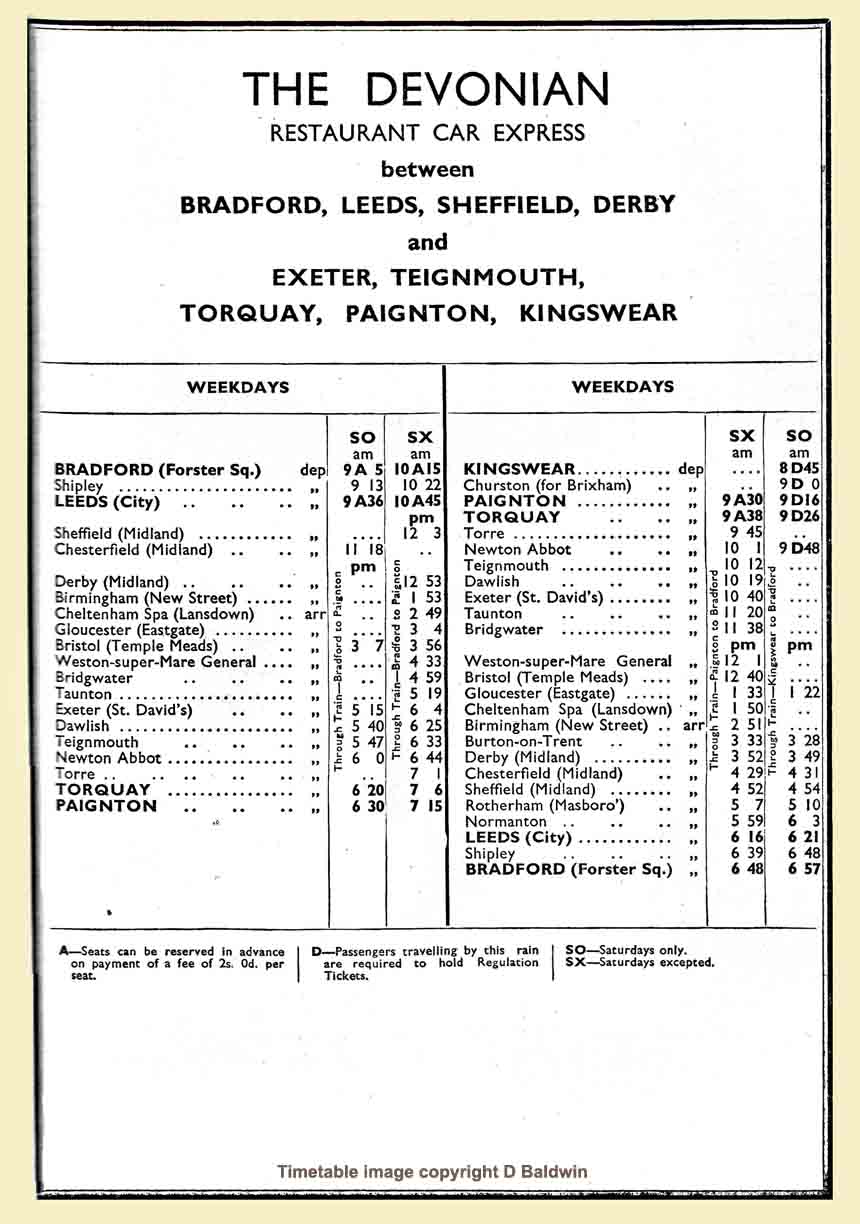
(Below) Also near Silk Mill Crossing, Hawksworth-designed 'County' class No 1014 County of Glamorgan, brings a lengthy up express containing a very scratch collection of coaching stock. This relatively new engine entered traffic in February 1946 but it is already showing signs of hard graft; whilst the tender displays British Railways lettering it still carries a GWR-style number on the buffer beam and no BR smokebox numberplate, denoting the year to be 1948. No 1014 was withdrawn from traffic in April 1964 and by November of that year the GWR 'County' class became extinct. However a replica is being built at the Didcot Railway Centre, home of the Great Western Society. The praiseworthy aim of the 1014 County Project is to create a new locomotive using major component parts from two donor locomotives: the underframe from a 'Modified' Hall class locomotive No 7927 Willington Hall and the boiler from a Stanier 8F locomotive No 48518. To catch up with the full story of this commendable project click here to visit the excellent website. 

(Above) This picture shows a 51XX or 55XX 2-6-2T and inspection saloon heading east from Norton Fitzwarren to Taunton in the late 1940s. The 50ft inspection saloon is a relic from the nineteenth century that saw service in the Bristol area before its conversion to its present form. The low roof was the norm for such a vintage carriage and many were adapted for use as auto-trailers. This particular example displays extended steps beneath each door and just visible are the outboard brake chamber units fitted to each of the 8 wheels.
(Below) This interesting 1960's view looking west from Norton Fitzwarren station shows a Churchward 43XX class Mogul No 7337 slowing for its final stop before arrival at Taunton with the Saturday 2.24pm semi-fast from Barnstaple on 30 May 1960. The lines curving away to the right serve the Minehead branch and the divergence of the Barnstaple branch can be seen in the middle distance. The scene today has changed beyond recognition; the Devon and Somerset line to Barnstable became an early casualty of BR's 1963 Reshaping of British Railways report with closure coming on 3 October 1966; this was followed five years later with closure of the West Somerset line to Minehead on 4th January 1971; the last train left Minehead on Saturday 2 January 1971. However the branch was to find a new lease of life under the auspices of the West Somerset Railway Company, which was formed in 1971 with the intention of operating a year-round commuter service alongside a limited summer steam service. A deal was agreed with British Rail to purchase the line with the support of Somerset County Council, but the council decided to purchase the line for itself in 1973 and lease back the operational land to the West Somerset Railway (WSR). At 22¾-miles, the WSR is the longest standard gauge heritage railway in Britain, and with the recent construction of a new station at Norton Fitzwarren a connection via the former 'up' relief line to Network rail now allows occasional through trains to operate on the national network. Click HERE to visit the WSR's website.
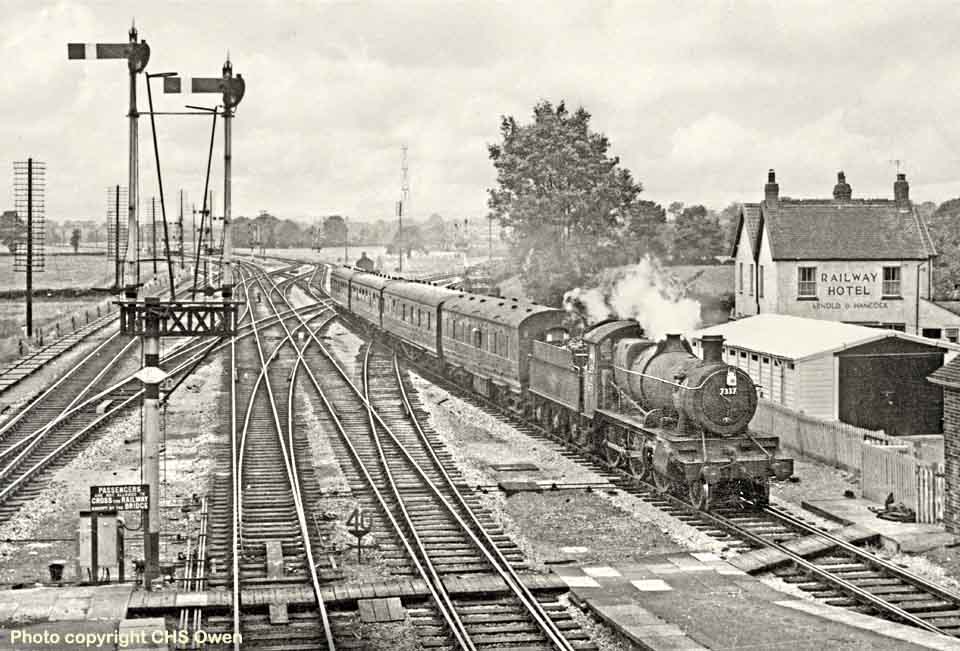

(Above-Below) An 82B St Philips Marsh-allocated 'Hall' class No 4907 Broughton Hall, formerly an oil burner, now reverted to burning coal, heads an up express through Norton Fitzwarren station circa 1953. This 'gem' was among the hundreds of railway photographs I have purchased from 'the 'WR Postcards for sale' box at Lens of Sutton. Note the Arnold & Hancock Brewery's Railway Hotel on the right. Following closure of the two branches and removal of the junction, the now empty public house is all that remains of this scene. Norton Fitzwarren station closed on 30 October 1961. (Below) In the normal way a change of engine and crew would take place at Taunton station when working the 09.15 Wolverhampton-Penzance 'Cornishman', but on this occasion the Midlands-based 'Modified Hall' No 7915 Mere Hall - a long time favourite of Wolverhampton Oxley shed (84B) - has extra mileage to cover as it accelerates through Norton Fitzwarren, due to pass here at 13.15pm. 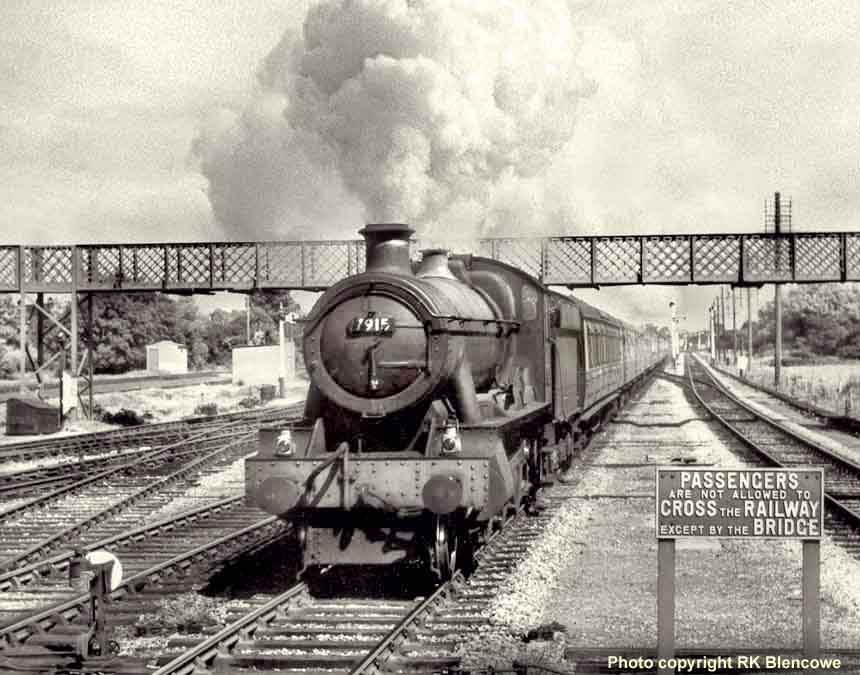
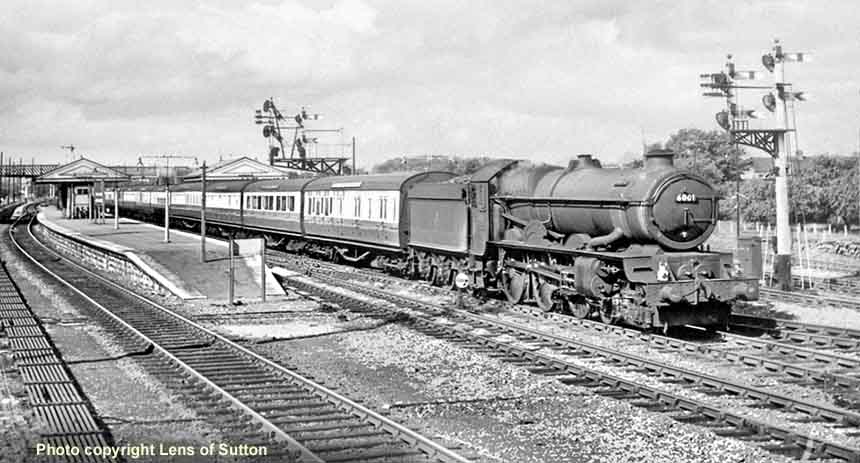
(Above) A bedraggled-looking 'King' class No 6001 King Edward VII coasts through Norton Fitzwarren with a Paddington-Plymouth express on the first Tuesday of September 1950. Note the copious signal rodding in the left foreground. Norton Fitzwarren was the scene of a fatal crash in 1940 when classmate No 6028 King George VI was involved in a derailment at the west end of the station and 26 people lost their lives.
(Below) At the east end of Norton Fitzwarren station, repairs are underway on both the 'down' relief and 'main, as a Class H goods train gingerly passes on the 'up' relief line. This defrocked 'Grange' class No 6869 Resolven Grange is coupled to one of Churchward's smaller-sized tenders which suited the slightly lower frames of these engines. The shed code disc shows 82B Bristol St. Philips Marsh. 
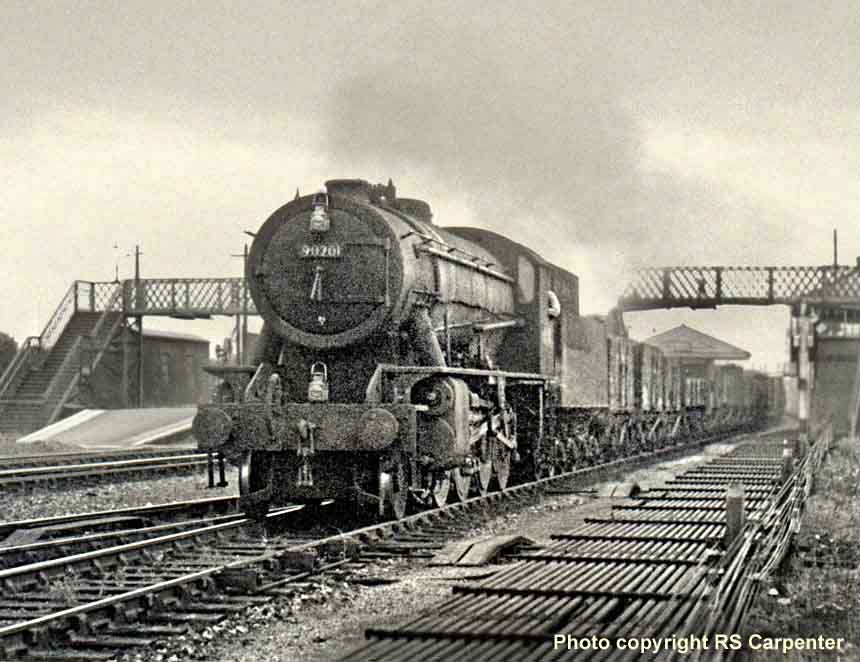
(Above) At the west end of Norton Fitzwarren station, a Riddles-designed WD 'Austerity' 2-8-0 No 90201 of 86E Severn Tunnel Junction heads a down freight on the relief line. Not elegant but functional, the WR had about forty WD 'Austerity' 2-8-0s for use throughout much of the Region. (Editor's note: No 90201 was completed in 1943, but did not become BR property until March 1949; it was originally numbered 7243, then 77243 from 1945 until BR's acquisition). Photo RS Carpenter.
(Below) BR-built 'Castle' class No 7035 Ogmore Castle heads an 'up' a Summer holiday extra through Norton Fitzwarren. This photograph is undated but the Hawksworth tender gives a clue. Looking at the data in 'The Book of the Castles' published by Irwell Press it is either 1954 or 1956, however since the tender carries the 'Lion and Wheel' emblem, I will go for 1954. This is another example of a locomotive operating in an area where it was not usually to be seen; No 7035 was a Gloucester-based loco from September 1953 to May 1956. On the left is a 2-6-0 Mogul on a semi-fast, either waiting to continue down to Exeter, or waiting to cross the main lines to one of the North Devon branches. 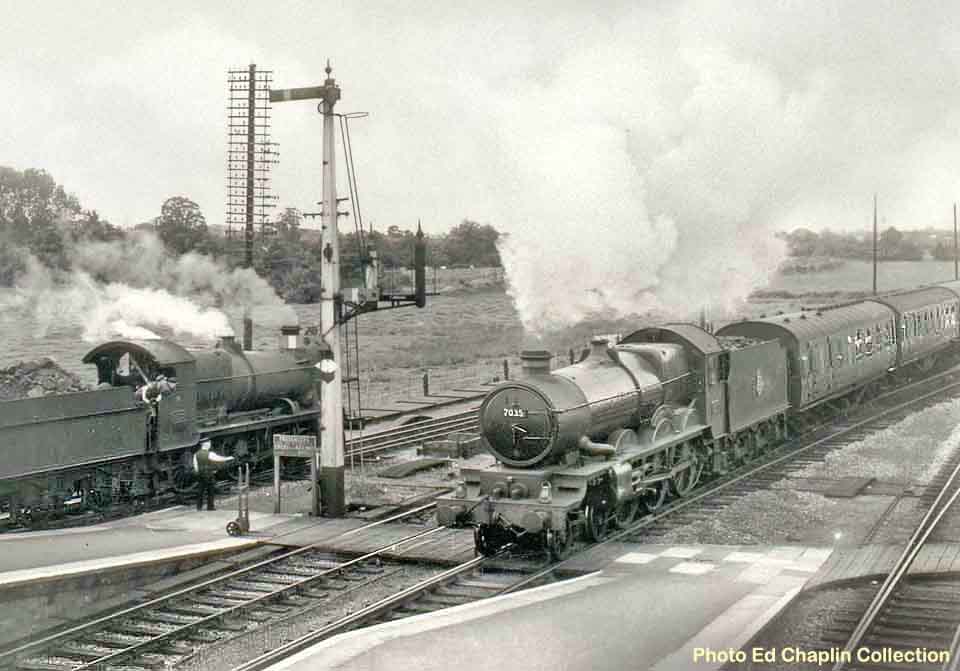
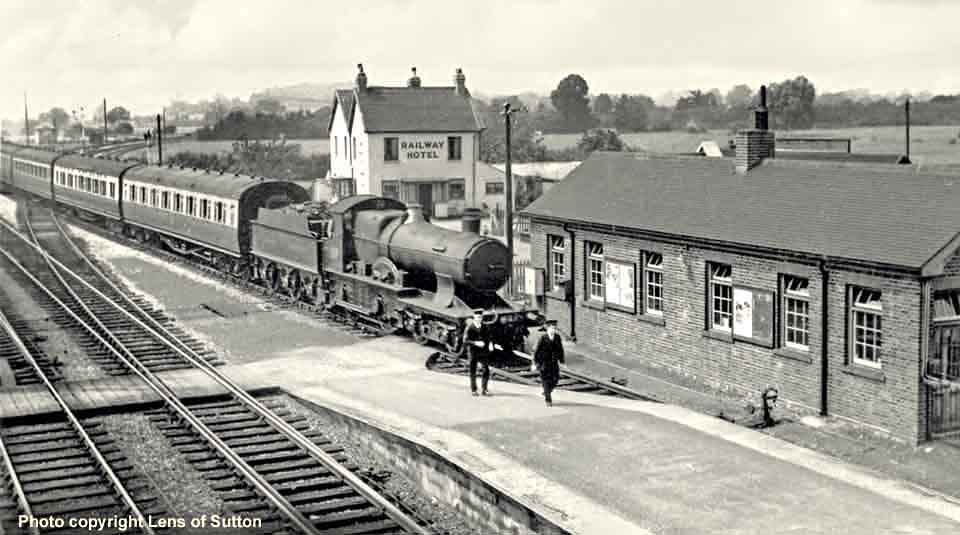
(Above) Yet another remarkable old photograph I acquired from Lens of Sutton is this one showing William Dean's 4-4-0 No 3712 entering Norton Fitzwarren with a local train. Built new in June 1906, the locomotive's number was later changed to 3422 Aberystwyth in the 'Bulldog' class, of which 156 were built between 1898 and 1910. No fewer than forty five of the class survived into Nationalisation, the last two being withdrawn in November 1951. Not this one though, it was withdrawn much earlier in March 1936.
(Above-Below) A nameplate from 'County' class No 1019 'County of Merioneth' went under the hammer at a GWRA auction in July 2016. Built in April 1946, 1019's first shed allocation was Newton Abbot, then Penzance in 1951, followed by a move to Shrewsbury, then Stafford Road 1953, Swindon 1954-1962 and lastly Shrewsbury from where it was withdrawn in February 1963 and scrapped at Cashmore's, Great Bridge. The plate was accompanied by an original British Railways Swindon receipt. (Below) In the Summer of 1959, Hawksworth's 'County' class No 1019 County of Merioneth brings train 339, the 9.05 SO Bradford-Paignton, the Saturday equivalent of the down Monday-Friday 'Devonian' through Norton Fitzwarren. (Editor's note: this was the first of class to appear with nameplates already attached and spent most of its early service life in the southwest). 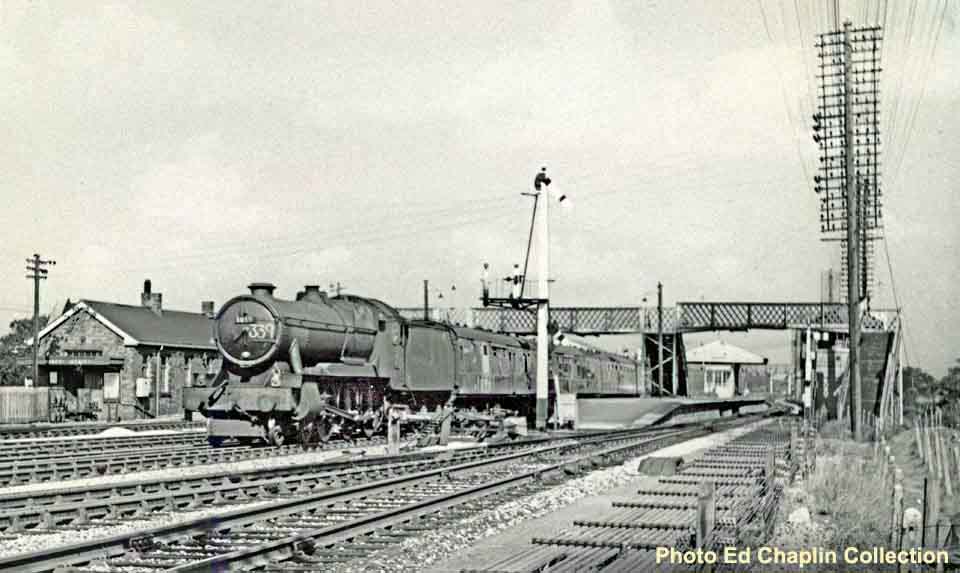

(Above-Below) Both photos capture the Monday-Friday 7.30am Paddington-Plymouth express heading non-stop through Norton Fitzwarren. This train required a loco change at Bristol, hence both locos - each displaying the train reporting number in a lower position - were provided by 82A Bristol Bath Road shed. The locos here are Hawksworth 'County' class No 1011 County of Chester and Collett 'Castle' class No 4093 Dunster Castle, both in original condition, still with a single chimney. No 1011 was always a Bristol division engine and duly received its double chimney at the end of 1958, whereas the 'Castle' was modified late in 1957; at the same time it was fitted with an extended smokebox. During Western Region steam days, the reporting number '130' was nominated for the down 'Cornish Riviera Express' for much of the time, but in 1950 the number changed to '160' and then reverted to '130' soon afterwards. 
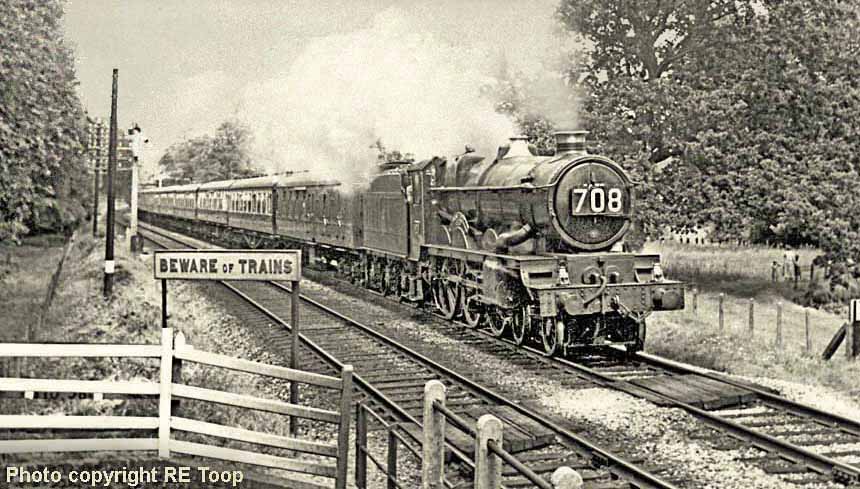
(Above) This well-prepared 'Castle' class No 5078 Beaufort is going well at the head of train 708, the 8.17am SO Carmarthen-Penzance on Saturday 29 June 1957; the hard-working engine crew are facing a laborious climb to the summit of Wellington Bank before they can take a breather on the more leisurely 20-mile downhill run to Exeter beyond. Built in May 1939, No 5078 was originally named Lamphey Castle and allocated to Newton Abbot shed (NA and 83A) until it went to Cardiff Canton (86C) a year after this photo was taken. (Editor's note: the engine was renamed 'Beaufort' after the twin-engined Bristol Beaufort torpedo bomber which served with the Royal Air Force Coastal Command and Royal Navy Fleet Air Arm during WWII).
(Below) On Saturday 28 August 1954, this barely three year-old BR Standard Pacific No 70016 Ariel of (83D) Laira heads train 149, the 1.25pm SO Paddington-Kingswear express on the down through line at Wellington station, due to pass here at 4.06pm. The station is situated seven miles west of Taunton and marks the start of the climb of Whiteball bank, with stretches of 1 in 90, 1 in 86 and 1 in 80 still to overcome. However with a good head of steam and a clear road ahead, the train might reach its due 4.50pm arrival time at Exeter. Wellington station closed on 5 October 1964, and all that remains is the goods shed (just visible on the right). Photo Ben Brooksbank, Initial Photographics. (Editor's note: although the engine had only been in service on the Western Region for twelve months, its unkempt appearance seems to reflect the disdain shown by WR staff towards these locomotives). 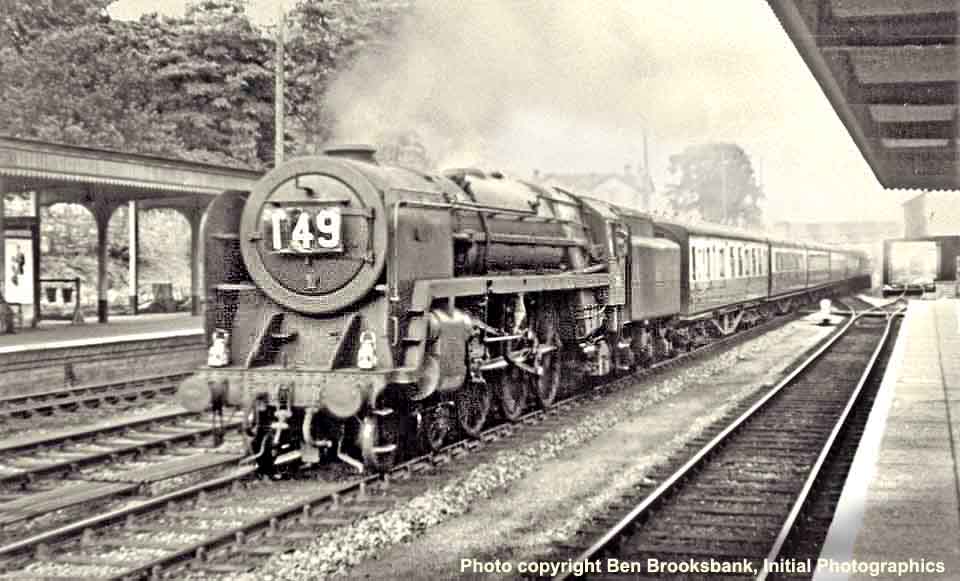

(Above-Below) When opened in May 1834, banking engines were kept on standby duty at Wellington station to assist the heavy westbound traffic on the climb to the summit at Whiteball Tunnel. In 1932 the original Brunel-style station was rebuilt to accommodate additional up and down loops to help increase the flow of traffic. The widening to four tracks required new platforms, which are clearly visible in this beautiful picture of a down Devon and Cornwall express passing on the down main in a rather stately manner behind 'King' class leader No 6000 King George V. The date on the reverse of the photo states 1932 and is credited to H Gordon Tidey. I cannot add anything more as the picture speaks so strongly for itself. (Below) This is the only near-decent photo I have of an up express at Wellington station; this one headed by 'Hall' class No 4905 Barton Hall. The photo was published by REAL (Ref T5739, and dated 1933) but since it is credited to H Gordon Tidey, I suspect it may have been taken on the same day as No 6000. 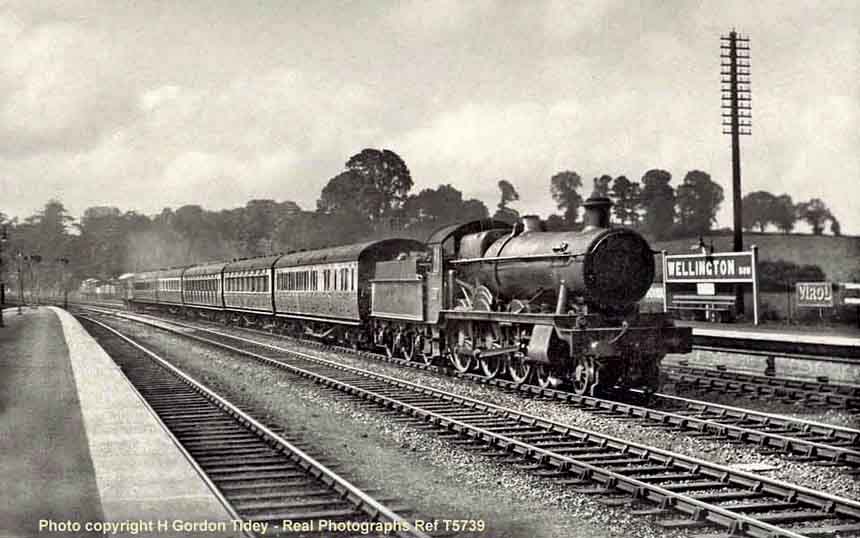
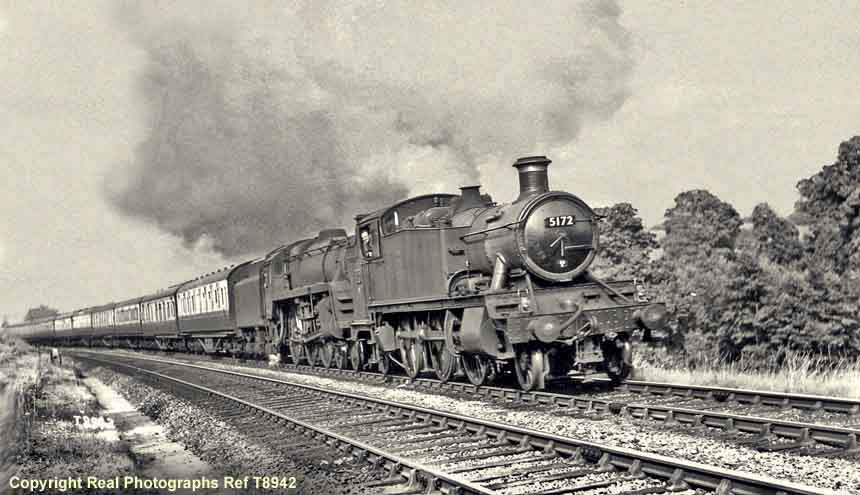
(Above) BR Standard Class 5MT No 73026 of 86C Cardiff Canton shed, is assisted on the climb of Wellington bank by Taunton's Class '5100' 2-6-2T No 5172 on Saturday 16 July 1955. No 5172 will come off at Whiteball Siding Signal Box and seek refuge in a siding until the opportunity arises to cross to the up line and return to Taunton. The train is 208, the 9.15am Liverpool-Kingswear, due there at 7.10pm. Photo REAL Ref T8942.
(Below) County' class No 1016 County of Hants is captured at speed descending Wellington bank past Poole Siding brickworks on Saturday 13 September 1952. Being a Wolverhamptom-based engine, it is apt to be heading the northbound 'Cornishman' back to its home city, due there at 7.25pm. The shed allocation at Wolverhamptom (Stafford Road) 84A consisted of many of the 'County' class. Photo RHG Simpson. 
(Below) On Saturday 2 July 1955, the crew of five year-old 'Modified Hall' No 7912 Little Linford Hall of 84E Tyseley shed are about to pass Whiteball Siding signal box after the climb from Wellington, and will no doubt be looking forward to the next 20 miles of downhill running to Exeter St Davids. Train 152 is the 3.20pm SO Paddington-Kingswear, comprised of the usual load of nine carriages. Photo RC Riley, Transport Treasury Archive, No 6198. 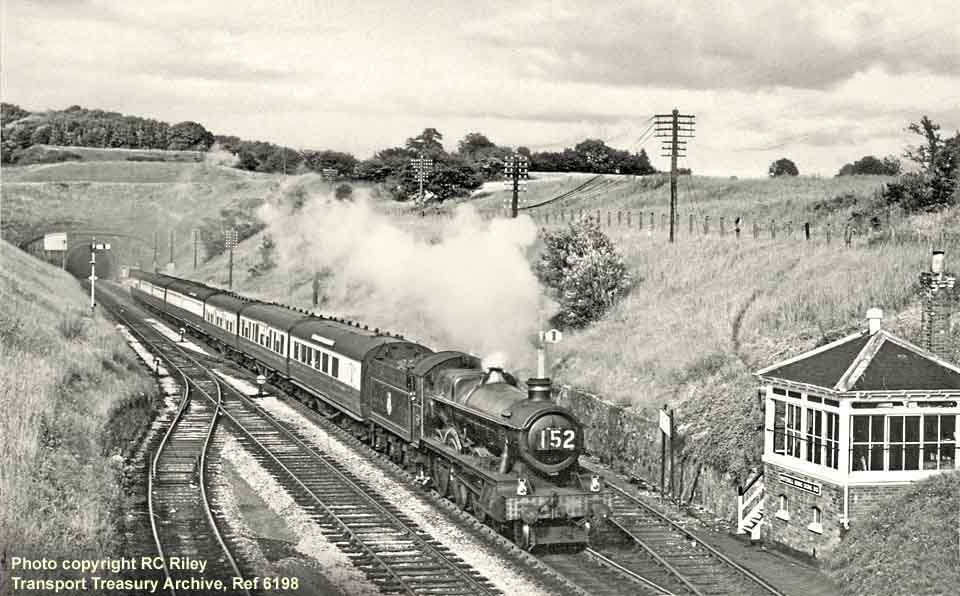
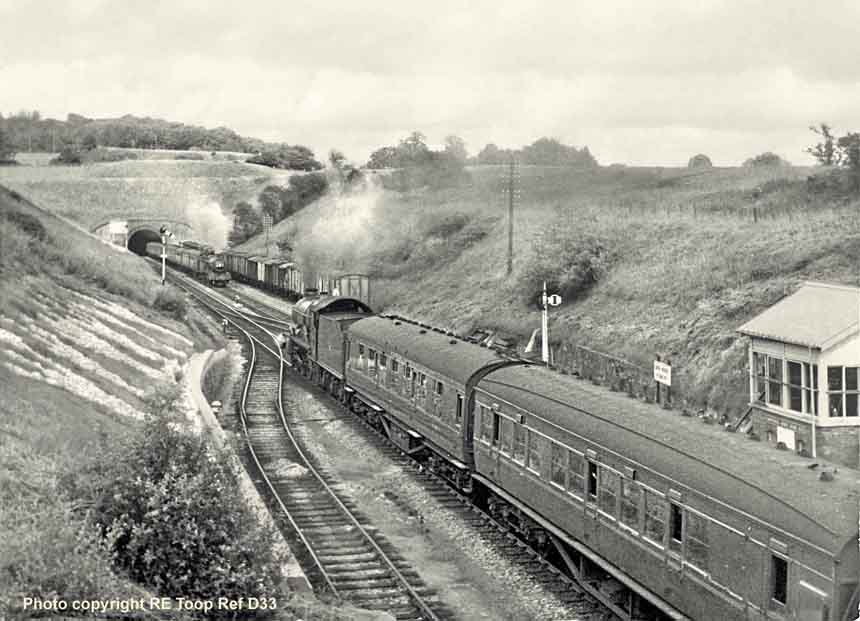
(Above) In this view, the old Whiteball Sidings Signal Box has been replaced by a new box following an unfortunate incident with a Tilley lamp which burned the old box down on 28 November 1956. This is Saturday 28 June 1958 and Train 284, the 8.45am SO Liverpool-Penzance, is exiting Whiteball tunnel, with 'Hall' class No 6936 Breccles Hall of 82B St. Philips Marsh in charge. In the foreground, 'Castle' class No 5097 Sarum Castle of Shrewsbury shed is working the 2.25pm SO Paignton-Sheffield. No 5097 will hand over to an MR loco at Bristol, with a 9.45pm arrival expected at Sheffield Midland station. Photo RE Toop.
(Below) Emerging from a relatively smoke-free Whiteball Tunnel, Taunton shed's 1930-built 'Hall' class No 4971 Stanway Hall passes Whiteball Sidings with train 213, the 09.05am SO Birkenhead-Plymouth express on Saturday 28 June 1958. The train's path from Birkenhead included the North and West line via Hereford and the Severn tunnel; it usually ran from Birkenhead with a portion for Cardiff, which was detached at Pontypool Road and continued its journey to Wales behind the train engine, while a new engine came on to haul the Devon portion, as seen here comprised of only six coaches. I believe this engine came on at Bristol Temple Meads, rather than Pontypool Road, making it the fourth engine to haul this portion since it began. Photo RE Toop Ref D50. 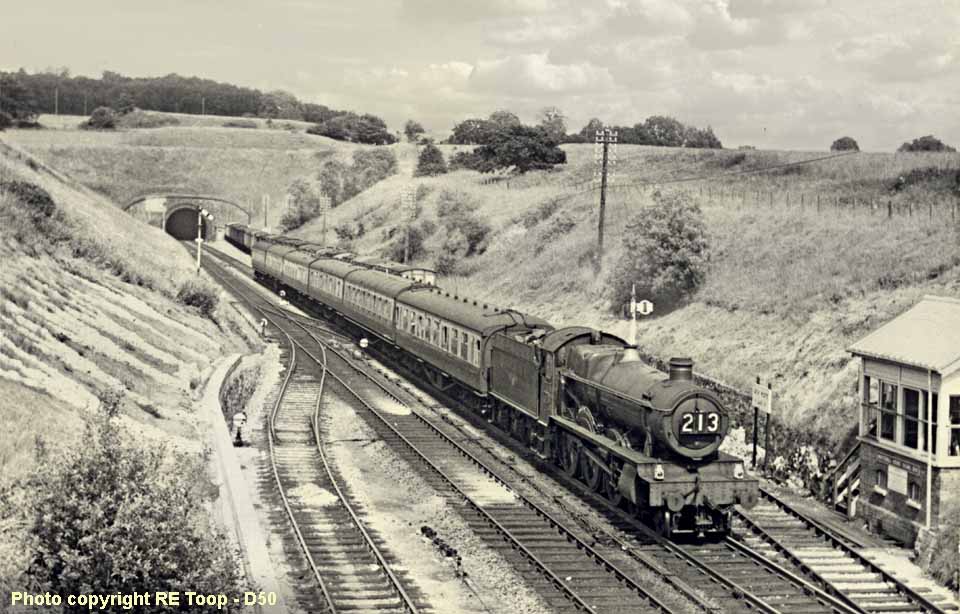
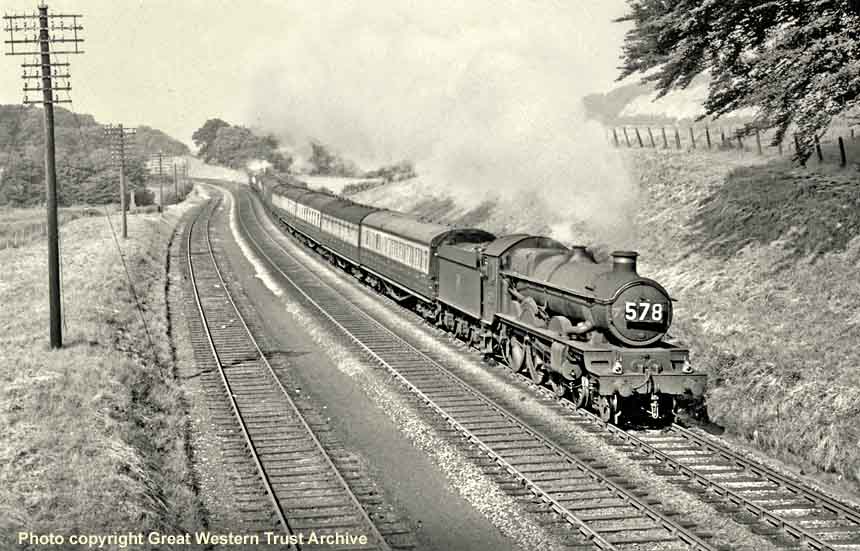
(Above) Approaching Whiteball summit from the west is Gloucester's 'Castle' class No 5017 St Donat's Castle* on Saturday 27 June 1953. A year later, No 5017 was renamed 'The Gloucestershire Regiment 28th 61st' in recognition of the heroic stand by the Regiment's 1st Battalion at the Imjin River during the Korean  War in April 1951; the naming ceremony took place on 26 April 1954. It was rare to find this loco not on a duty from 85B Gloucester shed, but bearing in mind the huge number of extra trains squeezed into the Western Region's busy summer timetable many locos were drawn away from their usual territory. Train 578 is the 8.05am SO Paignton-Manchester (Victoria), due there at 4.55pm. Photo Great Western Trust archive. (*Editor's note: The use of the apostrophe in 5017's original nameplate was apparently frowned upon by Chief Engineer CB Collett and the plates were changed to St Donats Castle, but after Collet's retirement in 1941 the apostrophe was subsequently restored).
War in April 1951; the naming ceremony took place on 26 April 1954. It was rare to find this loco not on a duty from 85B Gloucester shed, but bearing in mind the huge number of extra trains squeezed into the Western Region's busy summer timetable many locos were drawn away from their usual territory. Train 578 is the 8.05am SO Paignton-Manchester (Victoria), due there at 4.55pm. Photo Great Western Trust archive. (*Editor's note: The use of the apostrophe in 5017's original nameplate was apparently frowned upon by Chief Engineer CB Collett and the plates were changed to St Donats Castle, but after Collet's retirement in 1941 the apostrophe was subsequently restored).
(Below) 'Castle' class No 5078 Beaufort of (83A) Newton Abbot depot, begins the descent from Whiteball summit, almost all of it downhill for the next 20 miles to Exeter. This is Saturday 27 June 1953, and train number 430 is the 6.35am SO Walsall to Kingswear that was taken over by No 5078 at Bristol Temple Meads. The train is due at Kingswear at 2pm and hopes will be high for keeping on time since this is early on in the 1953 summer timetable (8 June 1953 to 20 September) and the huge influx of extra trains have yet to begin. In the middle distance can be seen a pannier tank resting from banking duty in the down loop; this runs for ¾ mile all the way down to the next station at Burlescombe. Photo Great Western Trust Archive. 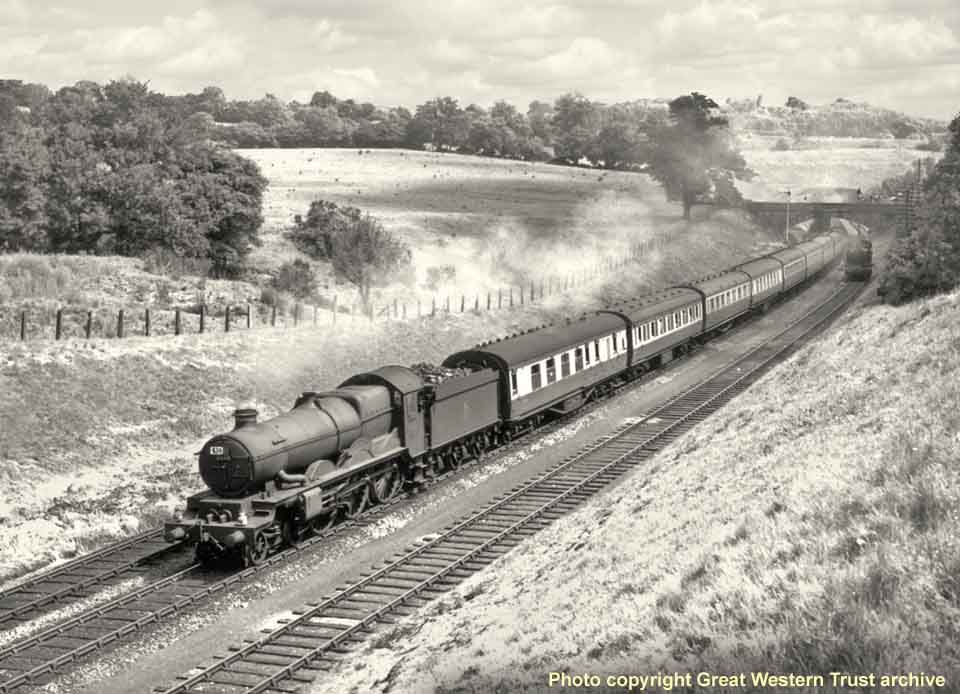
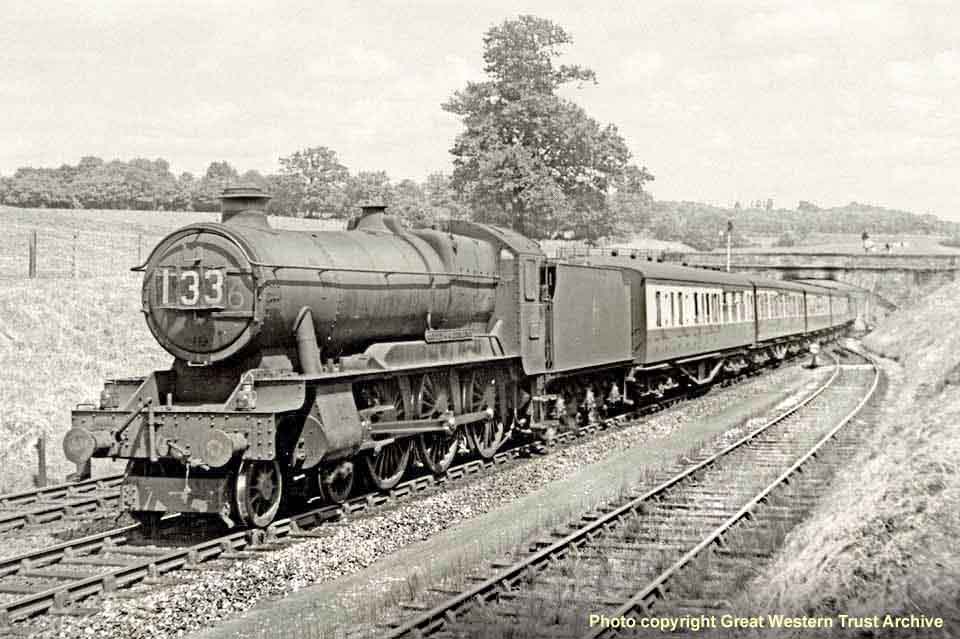
(Above) FW Hawksworth's 'County' No 1010 County of Caernarvon of Laira makes a fine sight as it begins the descent from Whiteball summit to Exeter with train 133, the 10.35am SO Paddington-Penzance on Saturday 27 June 1953. Derek Frost notes that on this day, the train ran ahead of the Cornish Riviera (train 130) headed by 'King' class No 6021 King Richard II - highly unusual. (Editor's note: this particular engine suffered the ignominy of having its name misspelt 'Carnarvon', but this was very quickly spotted and corrected). Photo Great Western Trust.
(Below) A well-presented 'Castle' class No 5024 Carew Castle of (83A) Newton Abbot is heading north against a grade of 1 in 115 with the northbound 'Cornishman' in 1957; the ensemble is captured passing Burlescombe signal box one mile before Whiteball tunnel - note the large Catch Points 1156 yards notice. Built in April 1934, No 5024 was a long time resident of Newton Abbot shed 83A from November 1949 until withdrawal in May 1962; during its career the locomotive logged 1,351,161 miles on the clock. (Editor's note: prior to 1904 this train was the forerunner to the 'Cornish Riviera Express' from London. In 1952 BR reinstated the train terminating at Wolverhampton (Low Level), with no fewer than 23 scheduled stops including Wednesbury and Bilston Central). 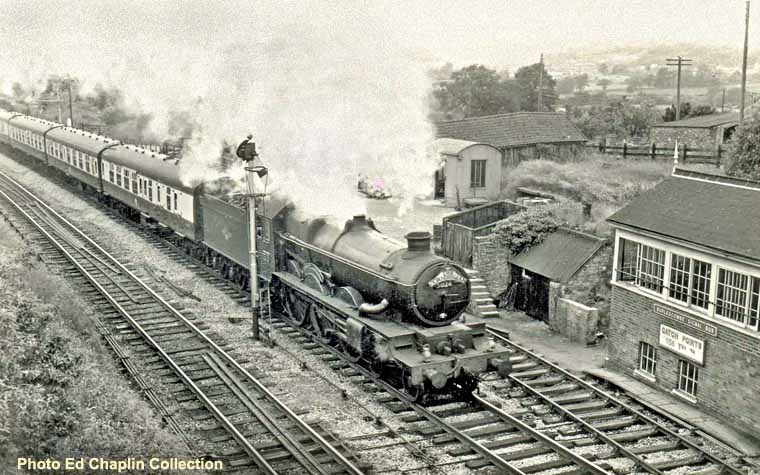

(Above) On Saturday 3 September 1960, Newton Abbot's 'Castle' class No 4037 The South Wales Borderers heads towards Sampford Peverell Halt station, almost 157 miles from Paddington. The halt closed on 5 October 1964 and the site is now occupied by a new station at Tiverton Parkway near Junction 27 on the M5. Train C36 is the 8.17am SO Carmarthen-Penzance, with No 4037 coming on at Bristol. [Editor's note: this old-stager was originally built in 1910, but kept the same number throughout its long career). Photo RE Toop, Ref C71.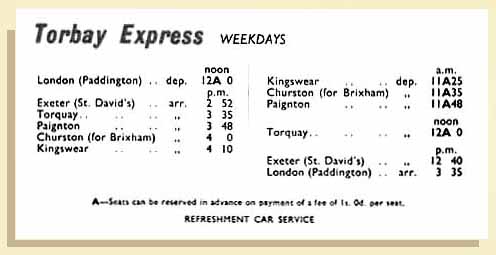 (Below) Taking advantage of the downhill run from the summit of Wellington bank, Castle' class No 5078 Beaufort of Newton Abbot might be speeding through Tiverton Junction at 70mph with train 142, the down 'Torbay Express' on Saturday 28 June 1958. The track layout at Tiverton Junction, just after MP179, was quadrupled in 1932 with the installation of new up and down loops allowing non-stop running on the centre tracks. The divergence of the single-lie branches either side of the station are to Tiverton town to the west and the 7½ mile Culm Valley branch to Hemyock in the east; both branches had a constant flow of dairy traffic which was attached to local trains headed by 14XX 0-4-2T engines. The up milk trains such as the 12.20pm from Penzance to London called here at 7pm to collect tank wagons and at least two other milk trains followed during the night to attach milk tanks for delivery to the London area depots. The milk traffic also involved a reverse operation with the empties being detached and collected on a daily basis. The Tiverton branch closed to passengers in 1964 and freight in June 1967. The Culm Valley line closed to passengers on 7 September 1963 and goods trains ended on 31 October 1975.
(Below) Taking advantage of the downhill run from the summit of Wellington bank, Castle' class No 5078 Beaufort of Newton Abbot might be speeding through Tiverton Junction at 70mph with train 142, the down 'Torbay Express' on Saturday 28 June 1958. The track layout at Tiverton Junction, just after MP179, was quadrupled in 1932 with the installation of new up and down loops allowing non-stop running on the centre tracks. The divergence of the single-lie branches either side of the station are to Tiverton town to the west and the 7½ mile Culm Valley branch to Hemyock in the east; both branches had a constant flow of dairy traffic which was attached to local trains headed by 14XX 0-4-2T engines. The up milk trains such as the 12.20pm from Penzance to London called here at 7pm to collect tank wagons and at least two other milk trains followed during the night to attach milk tanks for delivery to the London area depots. The milk traffic also involved a reverse operation with the empties being detached and collected on a daily basis. The Tiverton branch closed to passengers in 1964 and freight in June 1967. The Culm Valley line closed to passengers on 7 September 1963 and goods trains ended on 31 October 1975.

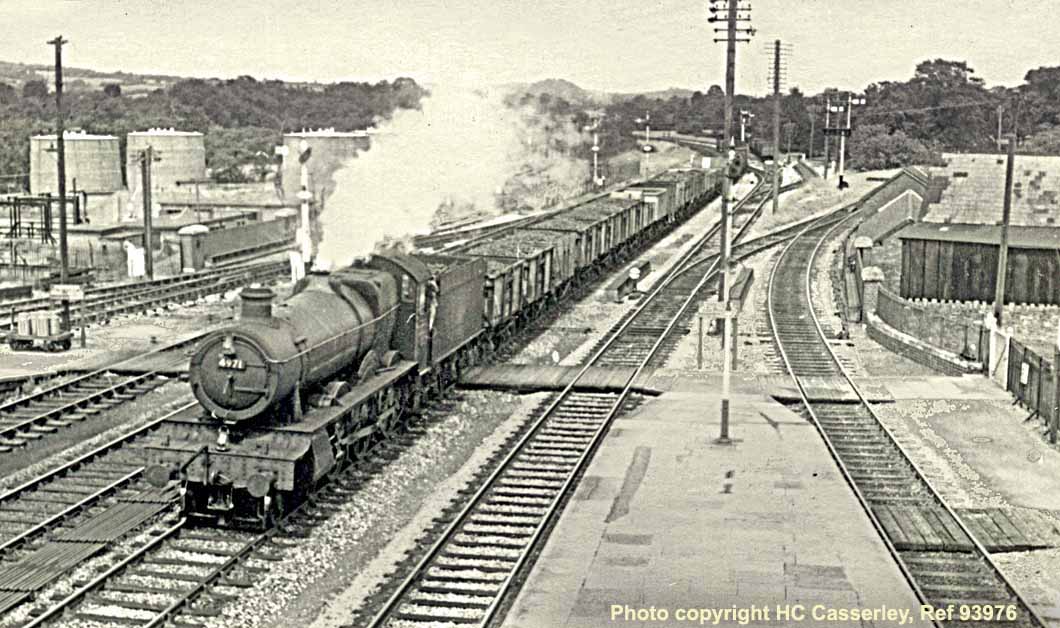
(Above) 'Hall' class No 4971 Stanway Hall of 83B Taunton is passing Tiverton Junction with a Class H freight on Tuesday 15 July 1958. On the far left are the Air Ministry Park Sidings and the lines from the 5 mile branch from Tiverton Town; curving to the right is the start of the 7½ mile-long Culm Valley branch to Hemyock. Photograph is by HC Casserley, Ref 93976. 
(Below) This photo of an up express passing Tiverton Junction came to me with no information except for the date: Friday 27 June 1958. However I think this is 'Modified' Hall No 6965 Thirlestaine Hall of Exeter shed on train 081 the Fridays Only 1.50pm Kingswear-Paddington; the provision of a loco for this train was Exeter shed's responsibility. The ancient luggage van behind the engine somewhat spoils the overall look of the train Photo BKB Green collection, Initial Photographics. 
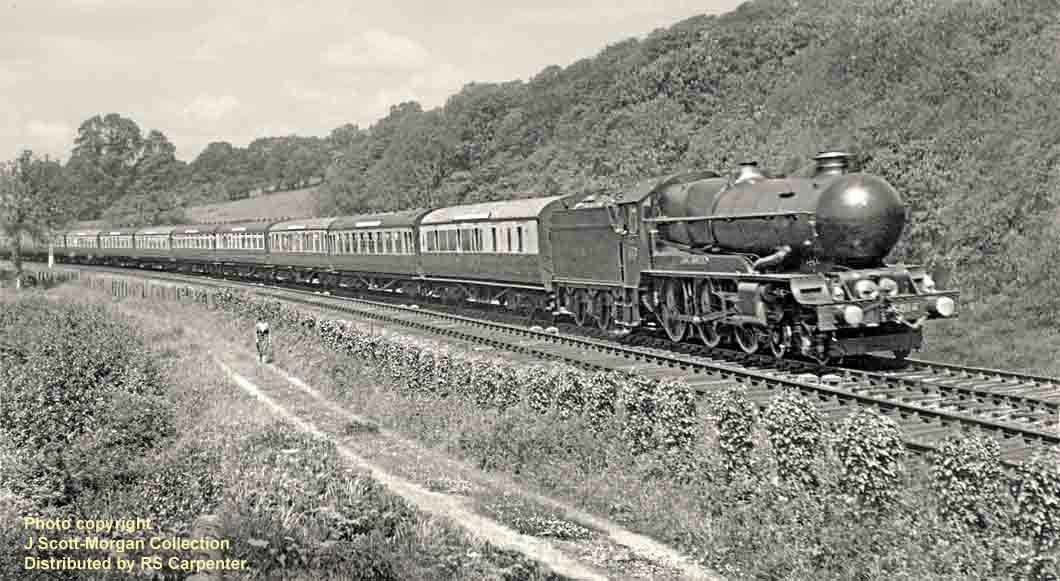
(Above) A very different looking 'King' class No 6014 King Henry VII is captured by the camera on a down express near Cullompton. No 6014 emerged from Swindon in this guise on 6 March 1935, going to Old Oak rather than Stafford Road as its home shed. The full streamlining lasted only till August 1935, when the fairings over and around the cylinders were removed, as such things hindered maintenance. So the date of this photo is probably in 1936 after the remedial work had been carried out. A full history of the BR modifications on the 'King' class locomotives can be found on Page 24 HERE. Photo is from the J Scott-Morgan Collection.
(Below) 'Hall' class No 5957 Hutton Hall of 81D Reading heads train 245, the 9.10am SO Manchester London Road to Paignton near Cullompton on an unknown date in 1953. This was the principal train of the day using the North and West route to the West Country, albeit very often loaded to 13 coaches which made it a tough task for a Hall. This train travelled south to Shrewsbury via Hereford and Bristol, and being later in the day than many other holiday trains bound for the Devon coast, instead of reaching Paignton for 5.46pm it could be up to two hours late on a peak Saturday. The eagle-eyed may have spotted the 8-wheel tender. Built in 1931, this GWR tender No 2586 was the only one of its kind, albeit its dimensions were identical in many ways to a standard GWR Collett 4000 gallon tender above the chassis, whilst the eight wheels were smaller than the standard six. The tender was used indiscriminately on 'Castles' and 'Hall' class locomotives, initially attached to 5919 Worsley Hall and in later years to 5904 Kelham Hall, but to what extent other locomotives used this tender can be gleaned from OPC's 'Power of the Castles' by RC Riley and Peter Waller. In a caption accompanying a photo of 5032 attached to tender No 2586 on 29th August 1936, it is said that a total of eleven locos were linked to the tender. The first three were 5919, 5001 and 5032. In total, seven 'Castles' were involved and they were 4093, 5001/17/32/49/68/71. That would presumably leave four 'Halls' including the two mentioned earlier. The tender is said to have been withdrawn in November 1963. Photo REAL, Ref T8935. 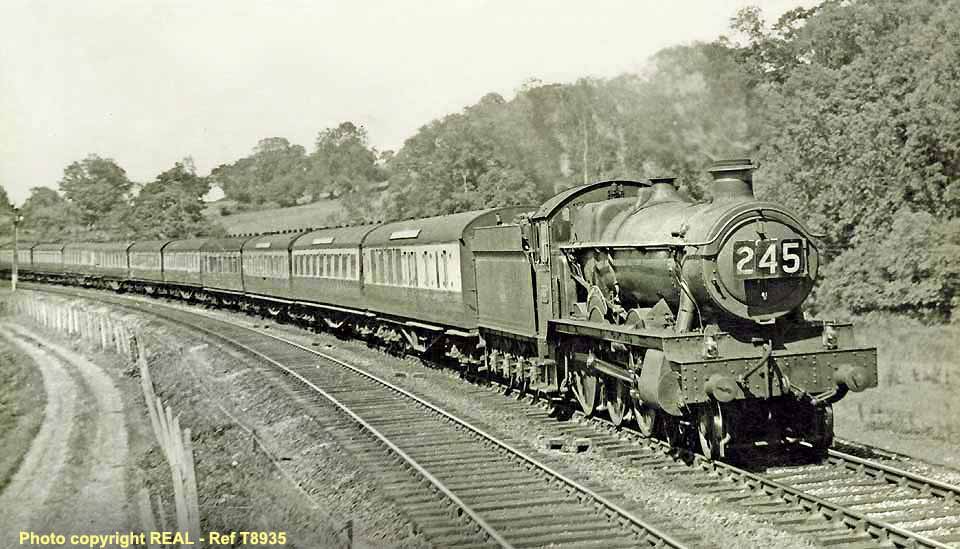
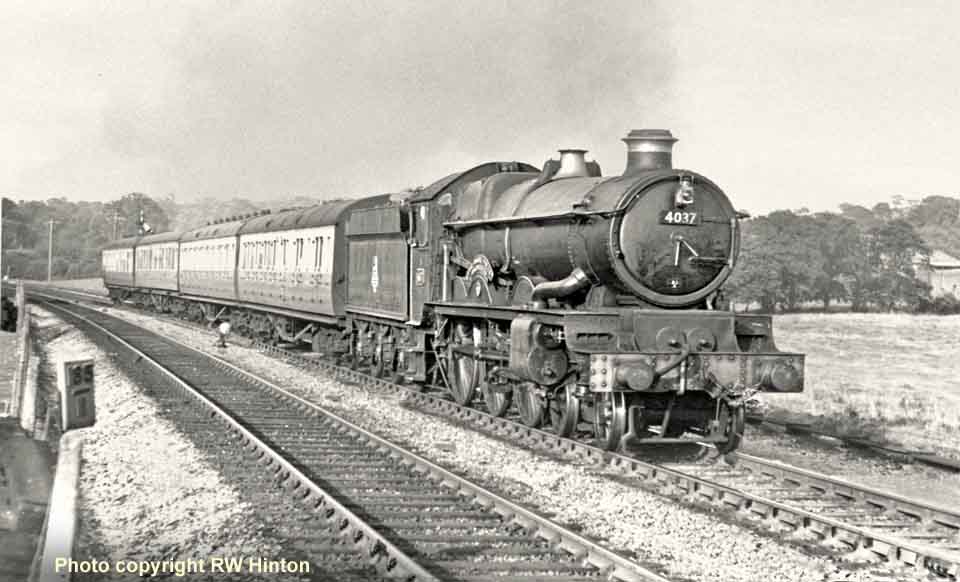
(Above) On Wednesday 31 July 1957, 'Castle' class No 4037 The South Wales Borderers heads a down semi-fast away from Hele and Bradninch station, 22¼ miles after Taunton, 8½ before Exeter St. David's. However, even though the Milepost in the foreground says 185½, it is actually twenty miles less via the direct route. No 4037 was originally built in December 1910 as a 'Star' class No 4037 Queen Philippa, then in June 1926 it was rebuilt as a 'Castle' with the fluted cylinder covers; later the front end was rebuilt and box-type cylinder casing fitted. No 4037 was renamed 'The South Wales Borderers' in March 1937, spending may years based at Old Oak Common, though it did have stints at several main line sheds, including Landore for three months before moving to Newton Abbot in July 1957, the same month this photo was taken. Withdrawn from traffic in September 1962, No 4037 has the distinction of achieving the highest mileage of any GWR or WR locomotive, a very creditable 2,429,722. Photo RW Hinton.
(Below) The now-closed Stoke Canon station was the junction station between the GWR main line and the Exe Valley branch to Tiverton and North Devon; the station closed to passengers on 13 June 1960 and goods traffic ended on 3 May 1965. We are now 190½ miles from Paddington on Brunel's original route west and 170¼ miles via the later direct route. Alternatively, it was 72¼ miles from Bristol Temple Meads, where so many southbound trains from Wales, the Midlands and the north had their incoming locomotive replaced by one from 82A Bristol Bath Road shed. Here a longtime Bristol Division engine, 'Modified' Hall No 6982 Melmerby Hall, currently at 82A Bath Road, heads through Stoke Canon on the down main with train 430, the 6.35am SO Walsall-Kingswear which it took over at Bristol Temple Meads from a London Midland Region locomotive, as evidenced by the coaching stock. It was due to pass here about 12.08pm and at least the sun has put in a welcome appearance on what was generally a cool, grey day. Photo BKB Green, Initial Photographics. 
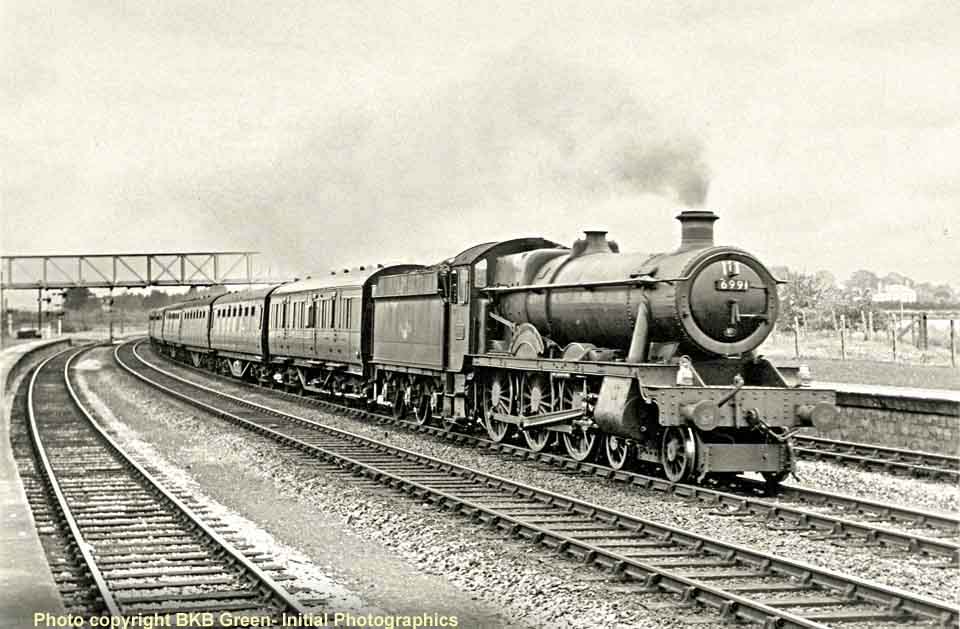
(Above) An acceptably clean 'Modified' Hall class No 6991 Acton Burnell Hall of (81C) Southall heads the 06.50am SO Paddington-Penzance through the long sweeping curve at Stoke Canon station on 28 June 1958. The Western Region's reliance on the numerous 'Hall' class locomotives was paramount to the smooth running (within reason) of a busy Summer Saturday Timetable when a large percentage of trains converged on the Devon coast. Photo by BKB Green, Initial Photographics. Ref 1535.
(Below) On Saturday 28 June 1958, a very scruffy 'Modified Hall' No 7902 Eaton Mascot Hall of (81A) Old Oak Common, passes Stoke Canon station with train 810, the 7.00am SO Birmingham Snow Hill-Penzance, which is timed to pass here about 11.03. The train is comprised of a mixed-bag of coaching stock from Handsworth carriage sidings in Birmingham which is hardly suitable for a marathon nine-hour journey to Cornwall; perhaps passengers will be pondering on their current whereabouts in the West Country and hoping to reach their destination soon, but there is still another five hours and 131½ miles to go before a 4.10pm arrival at Penzance. The line curving away to the left is the start of the Exe Valley branch to Tiverton and ultimately Barnstaple. Photo BKB Green, Initial Photographics Ref 1724.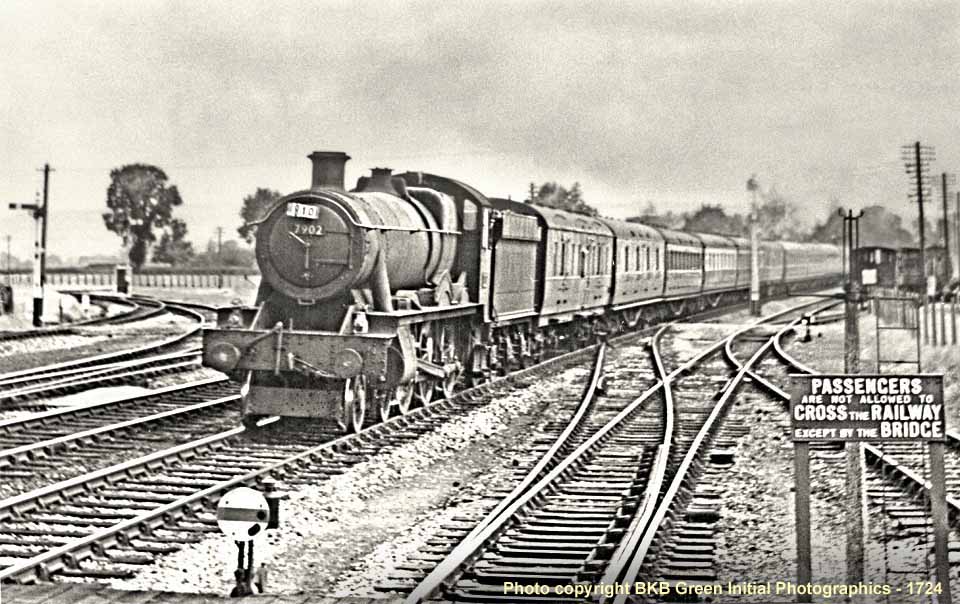
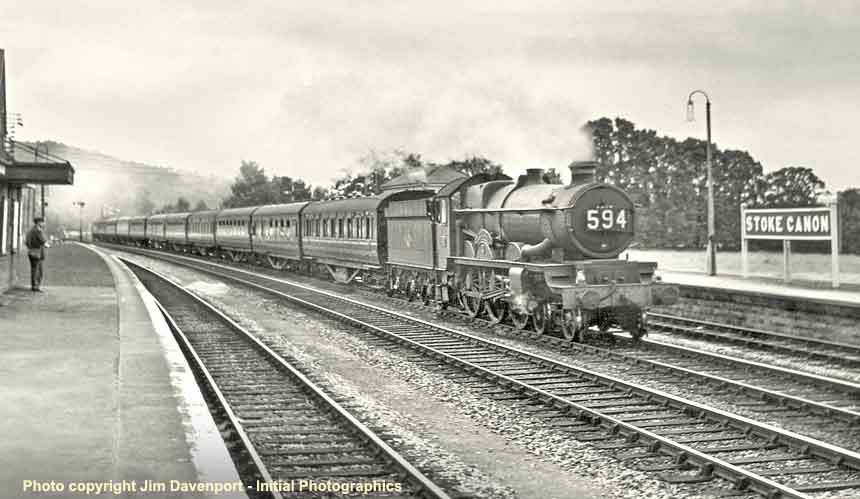
(Above) Another shot of 'Castle' class No 4037 The South Wales Borderers of 83A Newton Abbot, this time heading train 594, the 12.30pm SO Paignton-Manchester (London Road) through Stoke Canon, due to pass here about 2.08pm. This was one of those trains that left Devon with 10 coaches already full, but stopped en-route at Bridgwater and Weston-super-Mare where many more holidaymakers were trying to get home. A similar fate befell those waiting for the 10.20am SO Kingswear-Crewe that ran about 2 hours earlier, which also stopped at Weston. These crushes were the norm and hardly ever reported, but it must have ruined the return home for many. What was needed was a train to Bristol at least, starting empty from Taunton to collect passengers at stations in North Somerset. Photo Initial Photographics Ref 428.
(Below) Built in July 1925, a rather elderly 'Castle' class No 4089 Donnington Castle of 81A Old Oak Common is still going strong as it heads train 205, the 12 noon Mondays-Saturdays Penzance-Crewe 'West to North Mail' with the TPO coach ahead of the passenger carriages on Saturday 28 June 1958. The through carriages onward beyond Crewe were due at Manchester (London Road) at 2.02am Sunday morning and at Glasgow Central at 7.30am. (Editor's note: the engine moved shed allocation more than most, but spent a number of years at Old Oak and Bath Road depots; its last shed allocation was Reading, from where it was withdrawn in September 1964 after almost 40 years in service). Photo Jim Davenport, Initial Photographics Ref 474. 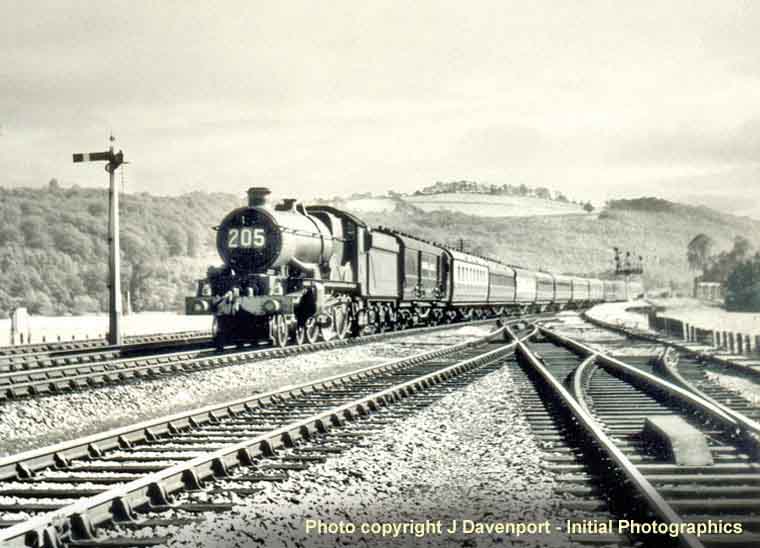

(Above) Work-stained 'Hall' class No 4963 Rignall Hall of 84B Oxley shed pilots a similarly grimy 'Grange' class No 6873 Caradoc Grange (a Plymouth Laira engine since 1950) at the head of the down 'Royal Duchy', which departed Paddington on Saturdays at 1.35pm. Doubtless No 4963's earlier duty that day had been train 830, the 10.50am SO Wolverhampton to Minehead, as far as Taunton where it handing over to a 2-6-0 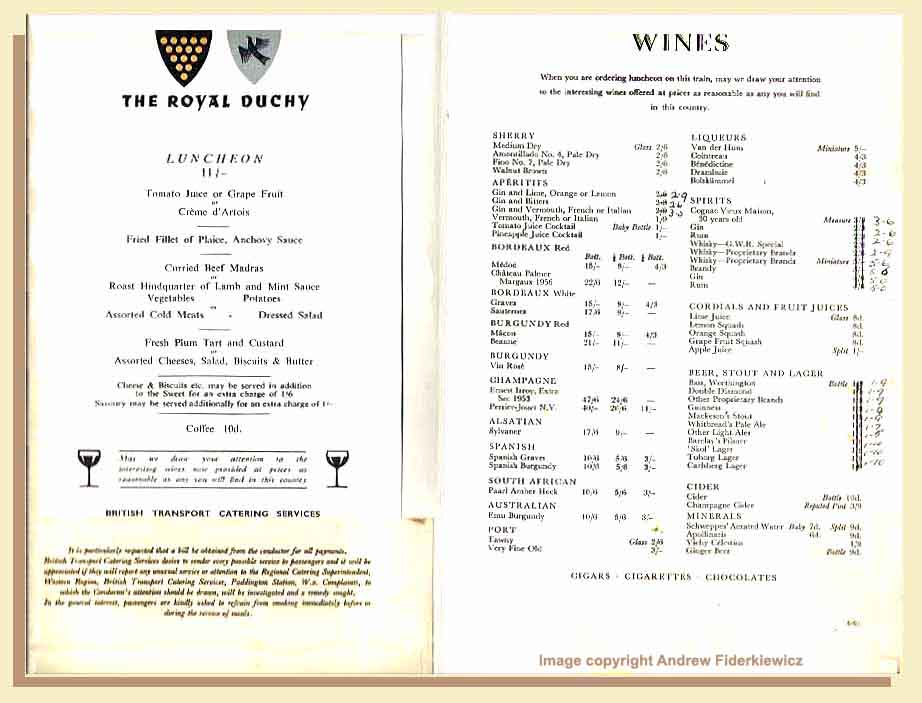 Mogul or a tank engine for the remaining journey to Minehead. The crew of No 4963 then waited for the arrival of No 6873 on the 'Royal Duchy', purloined the train headboard and coupled up to the front. The pair then departed Taunton for the 55½ mile journey over the Devon banks to Plymouth North Road, due there at 6.55pm. A further loco, or perhaps two, will then take over the train for the final 79½ miles to Penzance, a journey involving no fewer than twelve stops at Cornish stations, before an expected 9.55pm arrival. Note the smart rake of chocolate and cream Mk1 coaching stock which includes a restaurant car. Photo J Davenport, Initial Photographics Ref 699.
Mogul or a tank engine for the remaining journey to Minehead. The crew of No 4963 then waited for the arrival of No 6873 on the 'Royal Duchy', purloined the train headboard and coupled up to the front. The pair then departed Taunton for the 55½ mile journey over the Devon banks to Plymouth North Road, due there at 6.55pm. A further loco, or perhaps two, will then take over the train for the final 79½ miles to Penzance, a journey involving no fewer than twelve stops at Cornish stations, before an expected 9.55pm arrival. Note the smart rake of chocolate and cream Mk1 coaching stock which includes a restaurant car. Photo J Davenport, Initial Photographics Ref 699.
(Below) One of the most remarkable and overlooked trains was this one from Exmouth on the Devon coast. The WR timetable showed it as the 10.04am from Exeter (St. David's) to Manchester (London Road), but the train actually began on the Southern Region at Exmouth station at 9.18am, and was hauled the first ten miles by a SR Mogul or tank engine to Exeter Central. There a WR Hall from Exeter shed was waiting to take the train down the 1 in 37 incline to St David's station, then onwards via Bristol Temple Meads, the Severn Tunnel, Maindee Junction East, and the Hereford & Newport line to Shrewsbury. In this shot No 6951 Impney Hall of 82B St. Philips Marsh hauls the train through Stoke Canon on 28 June 1958; by this time the service is identified as train 223 (it was previously numbered 575 when its destination was Manchester Mayfield). Then from 13 June 1960 it became train M90 and could be hauled by a D8xx diesel-hydraulic one Saturday, a 'County' the next, a 'Modified Hall' the next; in fact anything available at Exeter shed! There was no equivalent southbound train. Photo BKB Green, Initial Photographics. Ref 1496.
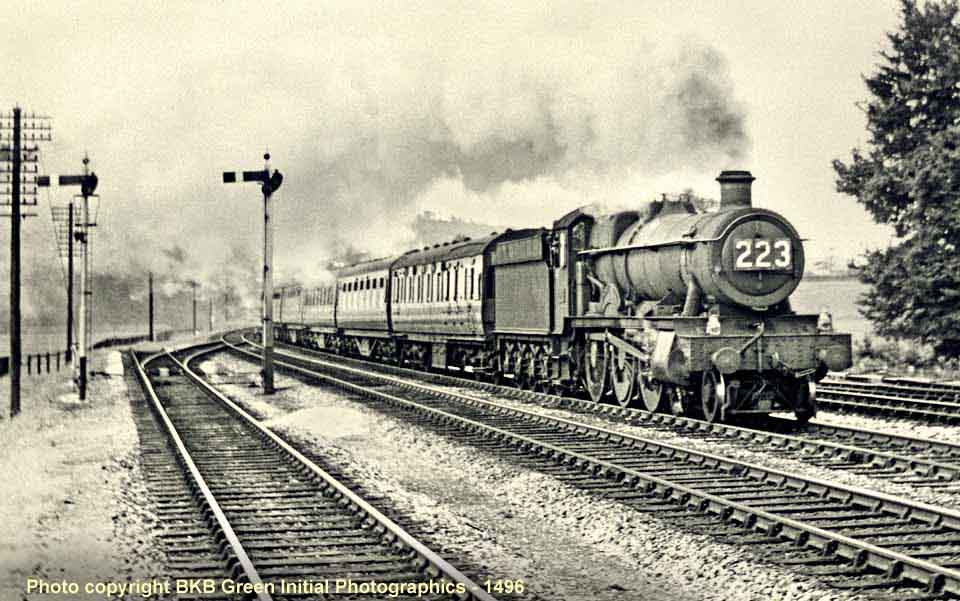

(Above-Below) Consecutive engine numbers on the same day, with both engines heading the same way to the same home destination. First we have 'Hall' class No 6925 Hackness Hall of 84B Wolverhampton (Oxley) which, if running to time, is passing Stoke Canon at the right side of 4.00pm. The 11.10am SO Penzance-Wolverhampton 'Cornishman' presented a stiff task for the engine and crew, but the reliable 'Halls' were the bedrock of the Great Western Operating Department. (Below) 'Hall' class No 6926 Holkham Hall of 84A Wolverhampton (Stafford Road) heads the heavily-loaded 12-coach train 678, the 11.15am SO Newquay-Wolverhampton, due to pass Stoke Canon about 3.06pm. No 6926 took the northbound 'Cornishman', train 675, on Thursday 26 June, and the southbound Cornishman, train 826, the next day on Friday 27 June as far as Plymouth. It was serviced overnight, and is now making a suitable return journey. Photos Jim Davenport, Initial Photographics Ref 1471-1472. 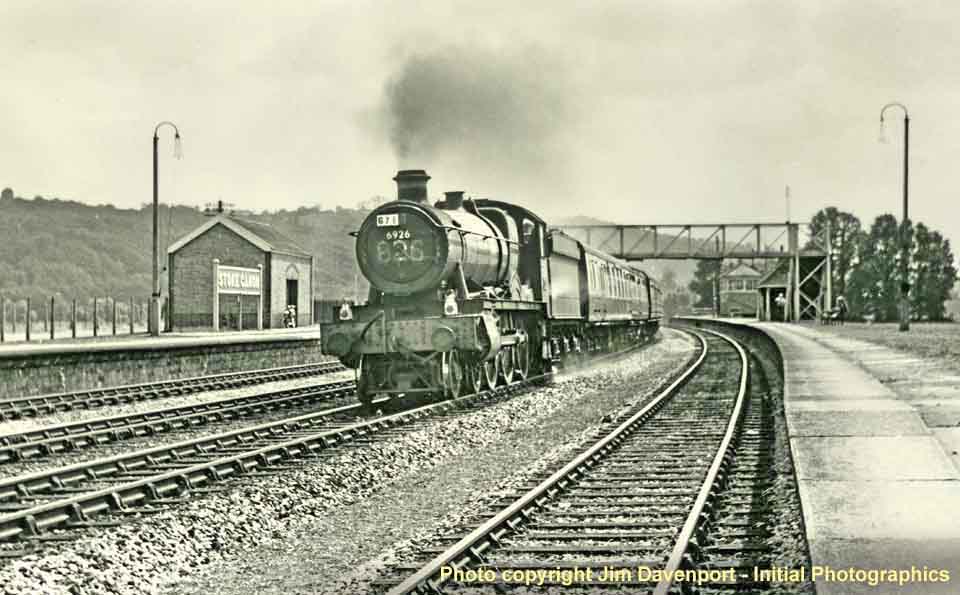

(Above) Once a longtime favourite of (NA) Newton Abbot, 'Castle' class No 5062 Earl of Shaftesbury is now allocated to 82A Bristol Bath Road as it heads train 703, the 8.10am SO Cardiff-Kingswear, due to pass here about 11.12am. Later in the day, it returned north heading train 595, the 3.20pm SO Kingswear-Cardiff. (Editor's note: the engine is little changed from new despite spending six years assigned to Swindon MPD). Photo BKB Green, Initial Photographics. Ref 829.
(Below) Commendably clean 'Hall' class No 4967 Shirenewton Hall is captured racing through Stoke Canon station at the head of an afternoon Torquay to Paddington service; this is the 1.45pm SO Paignton - Paddington, due to arrive in the capital at 6.15pm. Soke Canon is the start of the climb to Burlescombe and Whiteball summit, after which the crew can rest easy in the knowledge that the hardest part of the journey is over. Photo Jim Davenport, Initial Photographics. Ref 702. 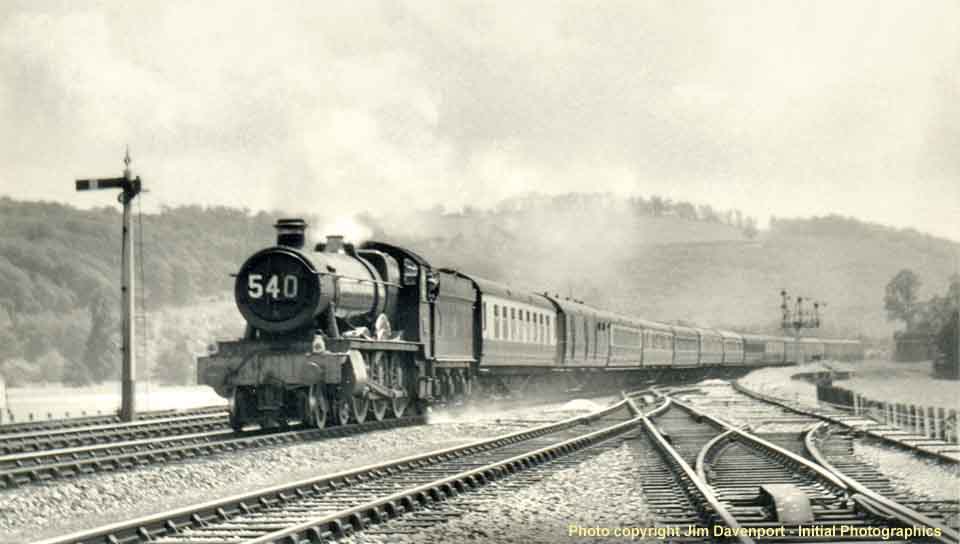

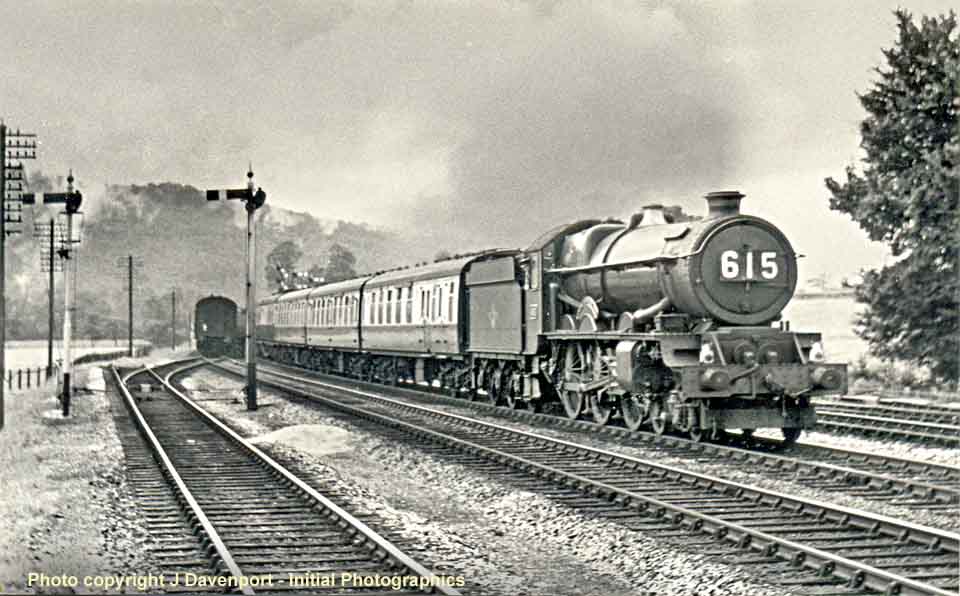
(Above) Old Oak Common's 'King' class No 6023 King Edward II approaches Stoke Canon station with train 615, the 8.35am SO Falmouth-Paddington, due to pass here at 12.38pm. Withdrawn from traffic in June 1962, No 6023 was towed to Swindon Works for breaking up, but good fortune intervened when BR civil engineers requested two engines for weight testing purposes on a new bridge west of Bristol; this led to No 6023 joining its twin, No 6024 King Edward I, in what was to become a quite remarkable story of survival. After the bridge tests rather than returning to Swindon for scrapping, both locomotives went to Woodham Bros scrapyard in Barry, where No 6024 became the first of the pair to be saved for preservation. No 6024's departure in 1974 left No 6023 with a nail-biting ten-year stay of execution before a decision was taken by Messrs Harveys of Bristol to purchase the engine for the 150th anniversary celebrations of the GWR's formation in 1985. Five years later No 6023 was released to the Great Western Society at Didcot, where a major 20 year-long engineering project began; the locomotive eventually entered traffic at an official launch ceremony at Didcot on April 2 2011. Click HERE to visit the Didcot Railway Centre. Photo Jim Davenport - Initial Photographics. Ref 1209.
(Below) Cowley Bridge Junction is situated 172 miles, 20 chains from Paddington by the direct route, or 192 miles, 52 chains by the original route; the SR line from Okehampton can be seen curving in from the left joining the Great Western main line for the 1¼ miles run into Exeter. On a rather dull, grey Saturday 18 May in 1957, 'King' class No 6029 King Edward VIII heads train 130, the down Cornish Riviera Express, due to pass here about 1.30pm. No 6029 had been a (83D) Laira engine since October 1939, and so it will have passed here almost daily in service. It was fitted with a fabricated double chimney at the end of the year and withdrawal came in October 1962, notching a final mileage of 1,859,278. (Editor's note: aside from its long residence at (83D), the engine only served (81A) Old Oak Common, thus most all of its mileage was accrued between London and Plymouth). Photo CHS Owen. 
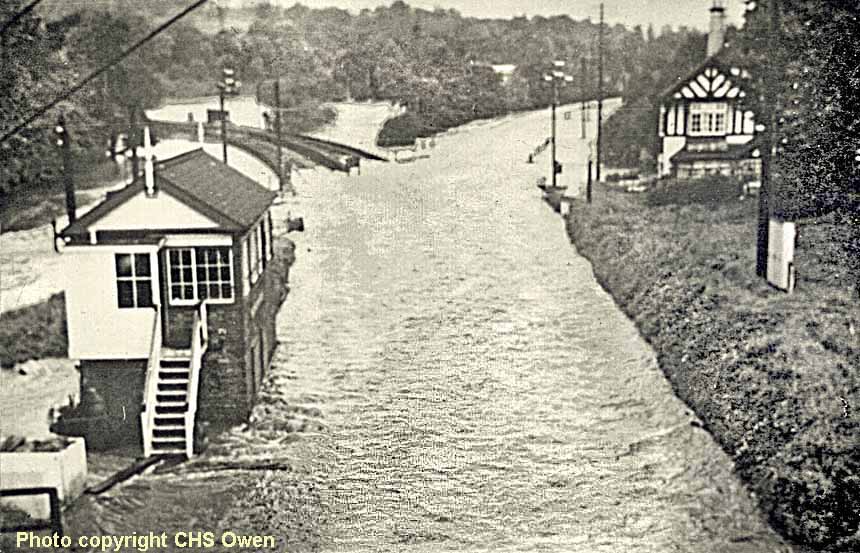
(Above) England's wettest year was recorded in 2012. The monsoon weather conditions created a major problem for railway engineers, particularly in the south west of England which had persistent heavy rain throughout much of the year. By November, the ground was saturated and the Met Office began issuing severe flood warnings. At Cowley Bridge junction, the seemingly innocuous River Exe passes under the bridge carrying the SR branch to Barnstable and then meanders downstream alongside the railway into Exeter. However in the event of a heavy rainfall the rising water in the river can flood the fields either side of the junction. In 2012 the volume of water was so great that a large culvert used for carrying away the excess water couldn't cope, and this led to the junction being completely submerged and the track ballast washed away. This was not the first time it had happened; Cedric Owen's photograph of Cowley Bridge Junction was taken at 2pm on Thursday 27 October 1960 following a monsoon downpour which forced BR to abandon train services on the WR main line at Hele & Bradninch, and on the Exe Valley, Barnstaple and Minehead branches. The most susceptible region in the south west is an area called the Somerset Levels, a coastal plain and wetland area running south from the Mendips to the Blackdown Hills; the area became daily news in 2014 when the Rivers Tone, Parrett and Cary were full to overflowing. Much criticism was levelled at the cessation of the dredging of rivers and culverts to remove debris and hasten the rising floodwater away. In 2014, the TV News showed surreal images of two-car diesel units picking their way gingerly through the floods inches above the waterline.
(Above) The rural setting at Cowley Bridge Junction was constantly disrupted by the steady procession of steam-hauled expresses en route to Exeter St. David's, possibly rattling the windows of the nearby Cowley Bridge Inn. On this occasion 'King' class No 6003 King George IV rumbles by with train 144, a late morning service from Paddington to Penzance in 1957. (Editor's note: unlike some 'King' class members, No 6003 did not have any BR modifications to frames or inside cylinders, and so the locomotive is seen here in its final condition). R K Blencowe EFG603
(Below) It can be hard to get a good picture of an up express passing Cowley Bridge Junction in the late morning, in this case 'County' class No 1022 County of Northampton of Shrewsbury shed heads the 8am Fridays Only Kingswear-Crewe on Friday 27 June 1958. Photo J Davenport, Initial Photographics.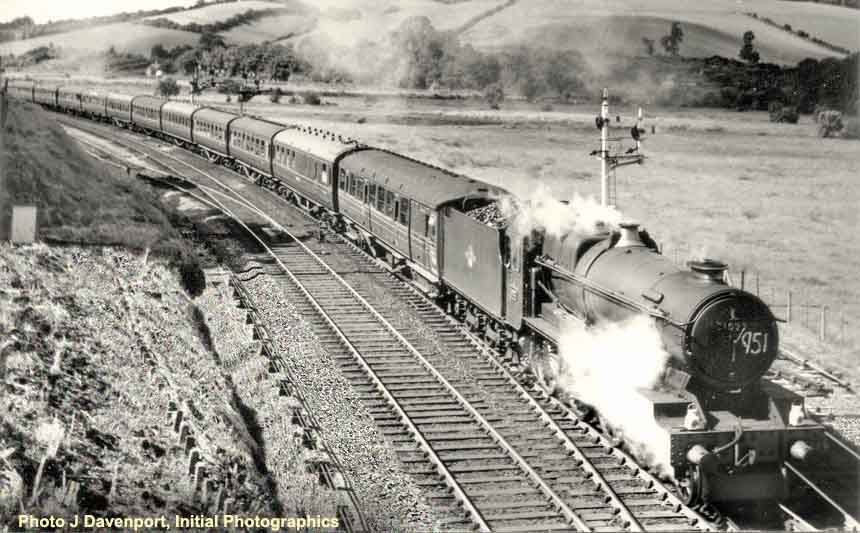
(Below) A locomotive nameplate, 'County of Northampton', from the GWR 'County' class 4-6-0 No 1022 went under the hammer at a Great Central Railwayana Auction on 13 April 2013. Built at Swindon in December 1946, No 1022 was allocated to Penzance in January 1948 and later Laira, Chester, Hereford and Shrewsbury from where it was withdrawn in September 1962 and despatched to TW Ward of Broughton Lane for scrapping on 12 December 1963. This is left-handplate, measuring 87ins long, without extended backplate as fitted directly to the loco splasher. 
(Below) On Saturday 1 August 1959, one of the excellent 'Grange' class members, No 6849 Walton Grange of Penzance shed approaches Cowley Bridge Junction with train 831, the 9.30am SO Kingswear to Birmingham (Snow Hill) due at its destination at 4.20pm. The pair of lines on the right run alongside the main line to Exeter goods yard, 1¼ miles ahead. (Editor's note: the engine starting off at (OXY) Wolverhampton Oxley shed, then (BAN) Banbury depot, before 'doing the rounds' including (86A) Newport Ebbw Junction, (83D) Plymouth Laira and (85C) Hereford).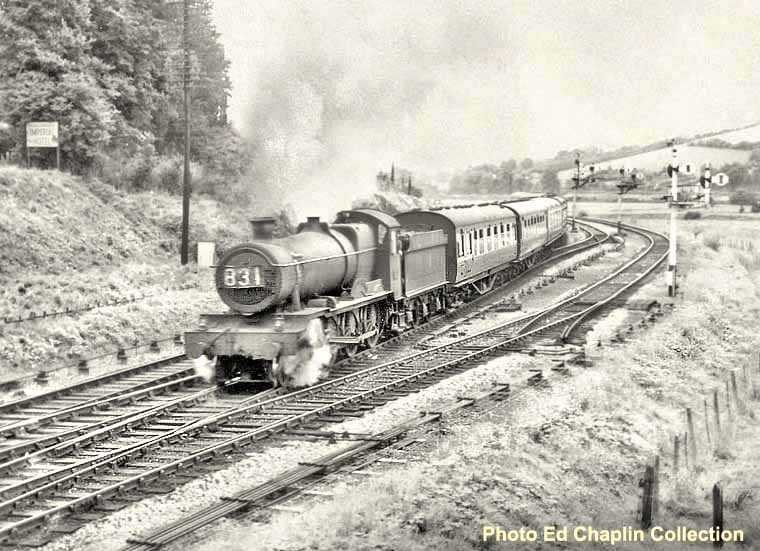
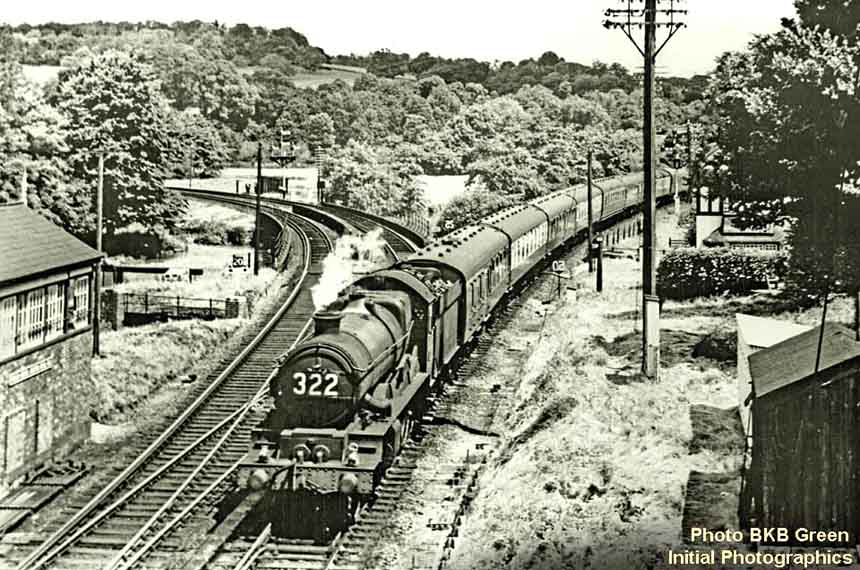
(Above) On Friday 26 June 1959, the 7.30am Paddington to Kingswear via Bristol express passes Cowley Bridge Junction behind 'Castle' class No 7014 Caerhays Castle, a Bristol Bath Road loco at this time. Built in July 1948, No 7014 had a double chimney fitted in February, and became one of five 'Castles' fitted with a Davies & Metcalfe mechanical lubricator on the front right hand side of the boiler, albeit not visible in this shot. No 7014 was withdrawn in February 1965. (Editor's note: the other four 'Castles' to be fitted with a Davies & Metcalfe mechanical lubricator were Nos 4087, 4088, 5084 and 7013). Photo BKB Green, Initial Photographics.
(Below) On Saturday 30 July 1955, 'Castle' class No 5027 Farleigh Castle of (82A) Bristol Bath Road approaches Cowley Bridge Junction with the 10.45am SO Penzance to Sheffield, a long distance inter-Regional train that will require haulage by at least three locomotives for its 365 mile run, including a hand-over at Bristol Temple Meads to a LMR engine for the remainder of the journey to Sheffield (Midland). Introduced to traffic in April 1934, No 5027 was first based at Old Oak Common (PDN) where it served for 16 years before moving to (82A) in the Bristol Division. A double chimney was fitted in April 1961, but the engine was withdrawn 18 months later in November 1962, having recorded 1½ million miles. Photo BKB Green collection. 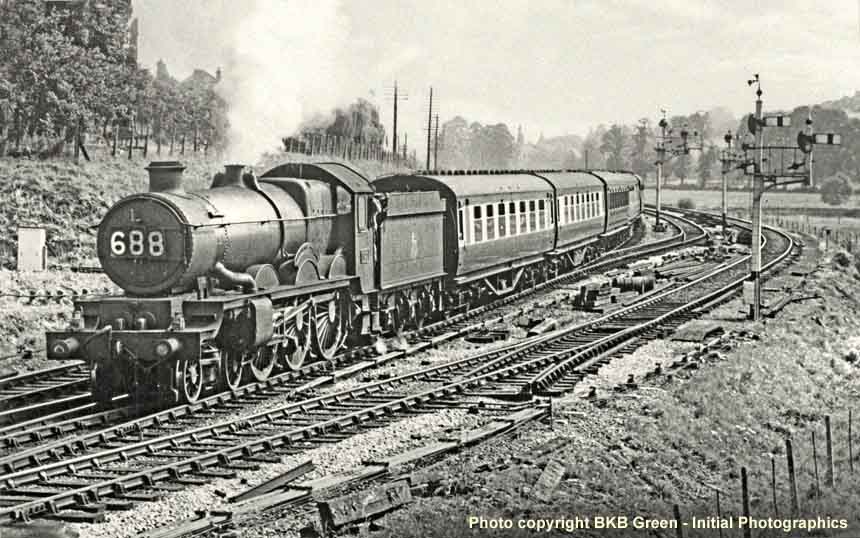
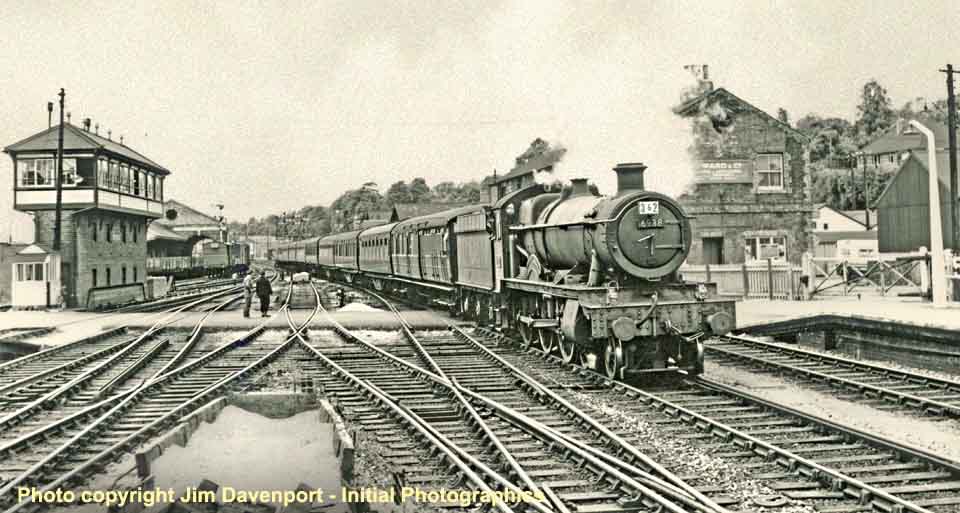
(Above) 'Hall' class No 6938 Corndean Hall of (83D) Laira enters Exeter St. David's on the down Main (centre through road) with relief train 352 on Saturday 11 June 1960, the last weekend before the start of the Western Region's Summer timetable. The coaching stock includes a mix of elderly Eastern Region and London Midland Region vehicles which suggests an East Midlands starting point and the train reporting number (paper characters pasted onto a panel mounted on the top lamp iron of the smokebox) indicates the destination is most likely Paignton. The ensemble is seen passing over Red Cow Crossing, which, given the frequency of extra holiday trains, must have kept the signalmen fully occupied with the constant opening and closing of gates; the delays were a real nuisance for local cars, buses, lorries and cyclists waiting to cross in between trains - plus, of course, pedestrians had a lengthy walk with no fewer than six mainline tracks to cross, and so for safety reasons the level crossing required the supervision of a man on the ground, seen standing in the centre…no high-viz vests or walkie-talkies in those days!
Continuing our journey west, we have arrived at Exeter St. David's station, 194 miles from Paddington via the original GWR route via Bristol, and just over 172 miles on the SR line from Waterloo via Salisbury. 
Established by the Bristol and Exeter Railway in May 1844, Exeter St David's established itself as an important interchange station for local and main line trains, plus it offered passengers the option of two rail routes to London: the Great Western Railway's main line to Paddington via Reading or the Southern Railway's West of England Main Line to Waterloo via Salisbury and Basingstoke.
However this gave rise to the odd situation where London-bound trains departed from both ends of the station in the opposite direction: trains to Paddington headed north on the 'up' main and those to Waterloo heading south on the 'down' line.
As we depart Exeter, the SR line immediately curves away to the left and trains face a stiff climb of 1 in 37 to Exeter Central station, the majority of which required assistance from a banker, however our journey is almost level to Newton Abbot much of it alongside the Exe River estuary with the eastern shore visible across the water.
There are stations at Exeter St. Thomas and Exminster, each with up and down loops, allowing a 65mph maximum speed limit and the chance for engine crews to pick up water at speed on the 560 yard-long Exminster water troughs, just one mile later.
Next we pass Powderham signal box, at 200 miles, 53 chains on the original route, but our speed is restricted to 45mph approaching Starcross station (with its ferry connection across the estuary to Exmouth on the east bank). This section, in good weather, affords passengers the most splendid views across the water. Starcross is 182 miles from Paddington by the direct route and almost 202½ on the original route, and unless you are in a procession of slow trains, it is good to feel a touch of speed,
After Starcross we pass Dawlish Warren (MP204½), with its platform loops both sides and a popular destination for camping coach holidaymakers. The line now sweeps west along the Devon coast with the famous footpath on the sea wall, where perhaps more photographs have been taken of trains than anywhere else 'on the open road'. The bulky outcrop of Langstone Rock is on the left just before MP205, followed by MP206 and Dawlish station just after, before the line enters Kennaway tunnel, the first of five short tunnels burrowing through the distinctive red, sandstone.
After Clerk's tunnel is MP207, then Parson's tunnel, the first consisting of a 200 yard-long artificial tunnel. This tunnel passes beneath beneath Hole Head next to Parson and Clerk Rock. Exiting the tunnel we pass Parson's Tunnel Signal Box, and the pedestrian access to the seawall resumes via steps leading down Smuggler's Lane. We pass MP208 a short way ahead before passing Sprey Point and curving inland at Teignmouth station a little before MP209.
After Teignmouth the line passes the sports ground and skirts the River Teign past Bishopsteignton Signal Box by MP211, then past large yards on the down side at Hackney into Newton Abbot station, a railway centre of major importance, where many locos and crews are changed on both Up and Down trains, and the comprehensive engine shed (83A) houses almost 80 locos, of which at least 25 are express engines.
(Below) One of the many delights of Exeter St. David's Station can be summed up by this image of 'Battle of Britain' class No 34057 Biggin Hill awaiting departure with a train for North Devon, standing alongside 'Hall' class No 4985 Allesley Hall of 83B Taunton depot, with a train bound in the opposite direction for Liverpool. The date is the Saturday after Whitsun, 11 June 1960, and many reliefs are running in addition to the trains shown in the timetable. This is a prelude to an increasing number of trains that will be shown in the Summer timetable starting two days later on Monday 13 June. In just over a mile of leaving Exeter, the 'Battle of Britain' will diverge onto the SR Barnstaple line at Cowley Bridge Junction, whilst the 'Hall' will continue straight ahead on the WR main line to Taunton and beyond. Photo Jim Davenport. 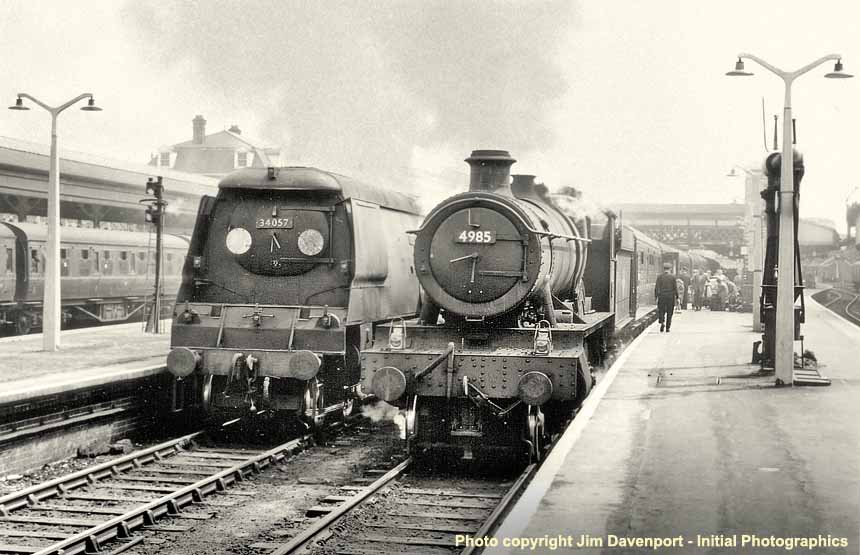
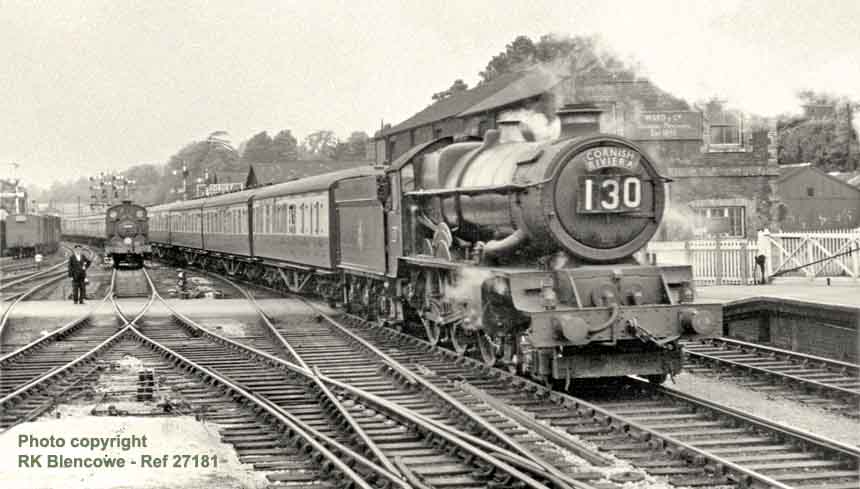
(Above--Inset-Below) What an enthusiast's delight it must have been to stand at the east end of Exeter St. David's station on a busy summer Saturday and watch the trains passing by. Here are three such examples on Saturday 7 August 1954, all hoping for a clear road on their non-stop journey. First is 'King' class No 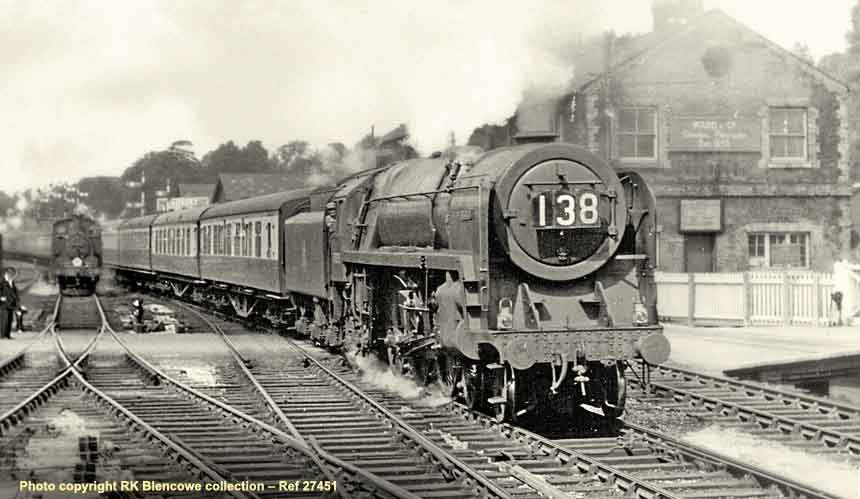 6025 King Henry III, a longtime favourite of (83D) Laira, on the 10.30am ex-Paddington 'Cornish Riviera' and highlight of the day. Next is 'Britannia' Class7MT No 70015 Apollo of (81A) Old Oak Common on the 11am SO Paddington-Penzance, due to pass about 40 minutes later, followed by 'Castle' class No 7000 Viscount Portal of (83A) Newton Abbot on the 12 noon Paddington-Kingswear 'Torbay Express', due to pass here about 3pm. I don't know the actual passing times, as without question, all trains were late as so many extras were running, and frankly, it was over-ambitious to put on so many trains. But then demand exceeded what could be done, and despite every effort to keep on time, and with many crewmen working overtime hours, it is pointless to guess such figures. Suffice to say…and there are many instances to prove it…the GWR and WR enginemen, guards, signalmen, station staff, and all others who made every effort to give a good service to their passengers. All three photographs are in the RK Blencowe Collection.
6025 King Henry III, a longtime favourite of (83D) Laira, on the 10.30am ex-Paddington 'Cornish Riviera' and highlight of the day. Next is 'Britannia' Class7MT No 70015 Apollo of (81A) Old Oak Common on the 11am SO Paddington-Penzance, due to pass about 40 minutes later, followed by 'Castle' class No 7000 Viscount Portal of (83A) Newton Abbot on the 12 noon Paddington-Kingswear 'Torbay Express', due to pass here about 3pm. I don't know the actual passing times, as without question, all trains were late as so many extras were running, and frankly, it was over-ambitious to put on so many trains. But then demand exceeded what could be done, and despite every effort to keep on time, and with many crewmen working overtime hours, it is pointless to guess such figures. Suffice to say…and there are many instances to prove it…the GWR and WR enginemen, guards, signalmen, station staff, and all others who made every effort to give a good service to their passengers. All three photographs are in the RK Blencowe Collection. 
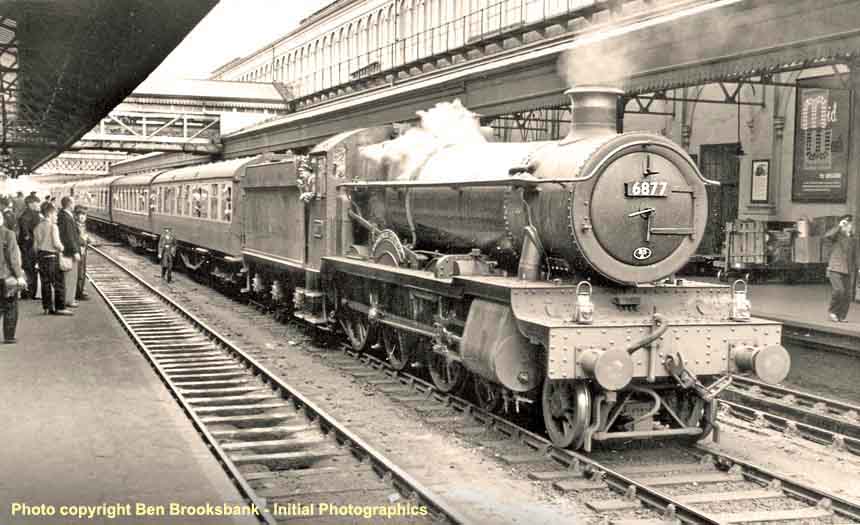
(Above) On Saturday 26 July 1958, Ben Brooksbank photographed 'Grange' class No 6877 Llanfair Grange of Worcester 85A, which has been brought to a stand on the down main centre road with train 705, the 8.50am SO Swansea-Paignton - reporting number not carried, rare. The time Ben noted was 2.43pm and the delayed train was sandwiched between train 134, the 10.35am Paddington-Penzance (headed by No 6013 King Henry VIII), due to arrive at 1.46pm, but running late at 2.37pm and train 135 the 10.40am Paddington-Paignton (headed by No 4960 Pyle Hall of 81D) due at 1.53pm, but also running late at 2.54pm. Then at 3pm another down relief, train 821, a Birmingham-Paignton relief arrived behind No 4909 Blakesley Hall of 82D 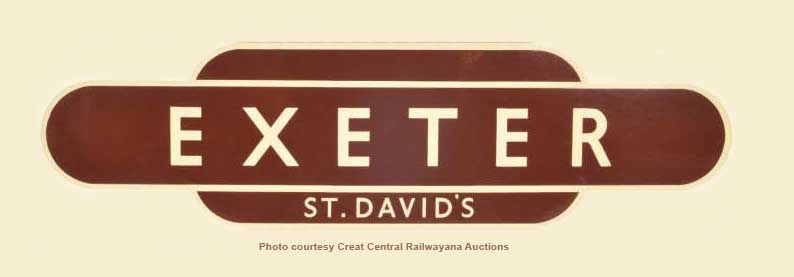 Westbury. Adding to the woeful congestion was a steady stream of SR holiday trains that shared tracks to Cowley Bridge Junction. Looking at a spotter's log at stations such as this on a holiday Saturday, one wonders how the railway staff managed to keep their sanity! Frankly, there were too many trains to keep to the published schedules. Photo Ben Brooksbank.
Westbury. Adding to the woeful congestion was a steady stream of SR holiday trains that shared tracks to Cowley Bridge Junction. Looking at a spotter's log at stations such as this on a holiday Saturday, one wonders how the railway staff managed to keep their sanity! Frankly, there were too many trains to keep to the published schedules. Photo Ben Brooksbank.
(Below) 1400 Class 0-4-2 tank No 1466 departs Exeter St David's with the 2.08pm to Bampton on September 9th 1957. Built at Swindon in February 1936 and originally numbered 4866 the engine was renumbered 1466 in 1948; following withdrawal from Taunton shed in December 1963, 1466 now survives in preservation and can be seen at the Didcot Railway Centre. Click HERE to visit the Society's website. Note also in the background the Z Class 6F 0-8-0 tank awaiting its next banking duty to Exeter Central. 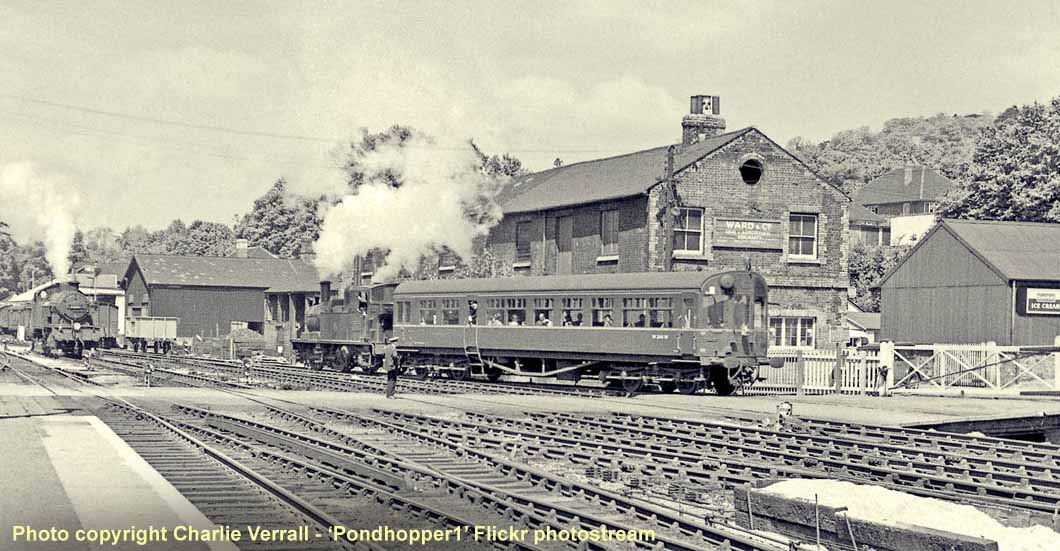

(Above-Below) Introduced in 1929 for heavy shunting duties, Maunsell's eight Class Z 0-8-0Ts were fitted with Walschaerts valve gear; this interesting rear view shot shows Nos 30955-56 on banking duties at Exeter St Davids in 1960. (Below) 5101 class 2-6-2T No 4174 departs Exeter St David's with the 2.15pm to Torquay on September 9th 1957. 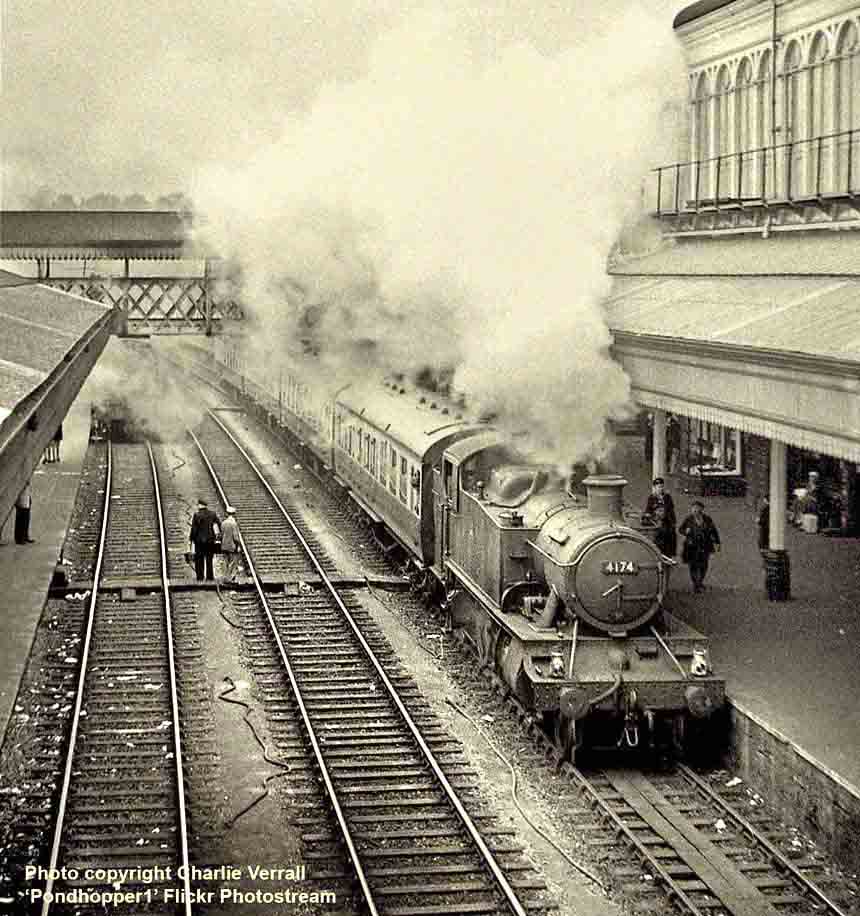
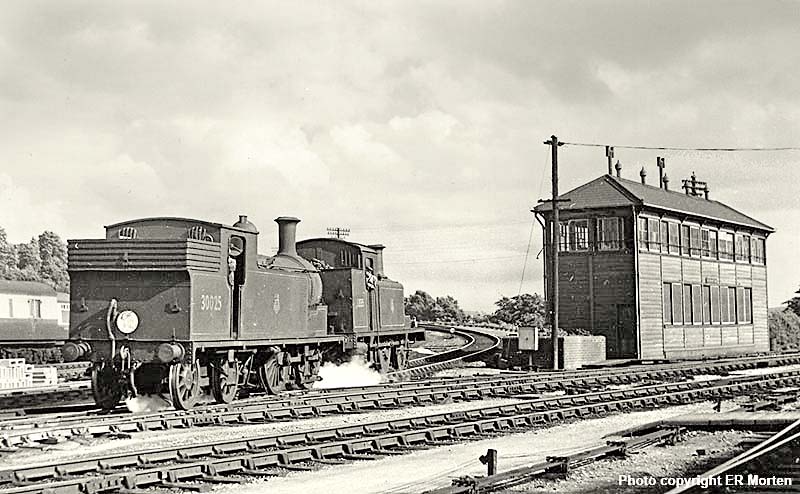
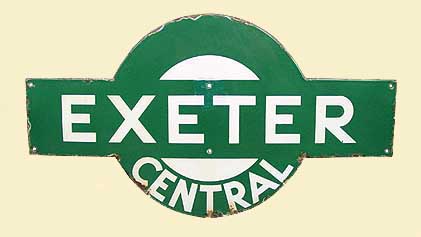 (Above) Having assisted a train up the 1 in 37 bank to Exeter Central on 14th July 1953, Class E1/R No 32135 (a Maunsell rebuild of Stroudley's E1) and one of Drummond's LSW Class M7 No 30025 run down the steep gradient past the imposing Exeter West Box in readiness for their next banking duty. With the installation of more modern multiple aspect signalling (MAS) in the mid-1980s, the WR's old-fashioned manual boxes and lower-quadrant semaphore signals, many dating back to pre-grouping days, have vanished from the scene entirely. The opening of a new panel box at Exeter St David's on 1st April 1985 led to the end of semaphore signalling on the main line via Taunton to Cogload Junction, and westwards to Totnes and Torquay including the branches to Exmouth Junction and Crediton. However, not all of our railway heritage has been lost…after the end of semaphore signalling in 1985, the redundant Exeter West signal box was to find a new lease of life when a group of dedicated individuals formed the Exeter West Group with the praiseworthy aim of saving the box from demolition. After careful dismantling it piece by piece, the box has been assembled as a working museum at the Crewe Heritage Centre, where members are present most weekends to demonstrate signalling days of the past. To find out more click HERE to visit the Group's excellent site. .
(Above) Having assisted a train up the 1 in 37 bank to Exeter Central on 14th July 1953, Class E1/R No 32135 (a Maunsell rebuild of Stroudley's E1) and one of Drummond's LSW Class M7 No 30025 run down the steep gradient past the imposing Exeter West Box in readiness for their next banking duty. With the installation of more modern multiple aspect signalling (MAS) in the mid-1980s, the WR's old-fashioned manual boxes and lower-quadrant semaphore signals, many dating back to pre-grouping days, have vanished from the scene entirely. The opening of a new panel box at Exeter St David's on 1st April 1985 led to the end of semaphore signalling on the main line via Taunton to Cogload Junction, and westwards to Totnes and Torquay including the branches to Exmouth Junction and Crediton. However, not all of our railway heritage has been lost…after the end of semaphore signalling in 1985, the redundant Exeter West signal box was to find a new lease of life when a group of dedicated individuals formed the Exeter West Group with the praiseworthy aim of saving the box from demolition. After careful dismantling it piece by piece, the box has been assembled as a working museum at the Crewe Heritage Centre, where members are present most weekends to demonstrate signalling days of the past. To find out more click HERE to visit the Group's excellent site. .
(Below) The 'Cornish Riviera Express' called at Exeter St David's only on Sundays during the Winter timetable. On Sunday 11 May 1958, 'King' class No 6017 King Edward IV seems to dwarf the carriages as it makes its call at 2.03pm. The next station stops are at Newton Abbot (2.31pm) and Plymouth North Road (3.35pm) where the locomotive will be replaced by another 4-6-0 for the final 79½ miles to Penzance. On a Sunday the train made a further eight station stops as against four on weekdays therefore its arrival at Pemzance was timed at 6.25pm compared to a weekday arrival of 4.55pm. Photo RK Blencowe collection, Ref 19412. 
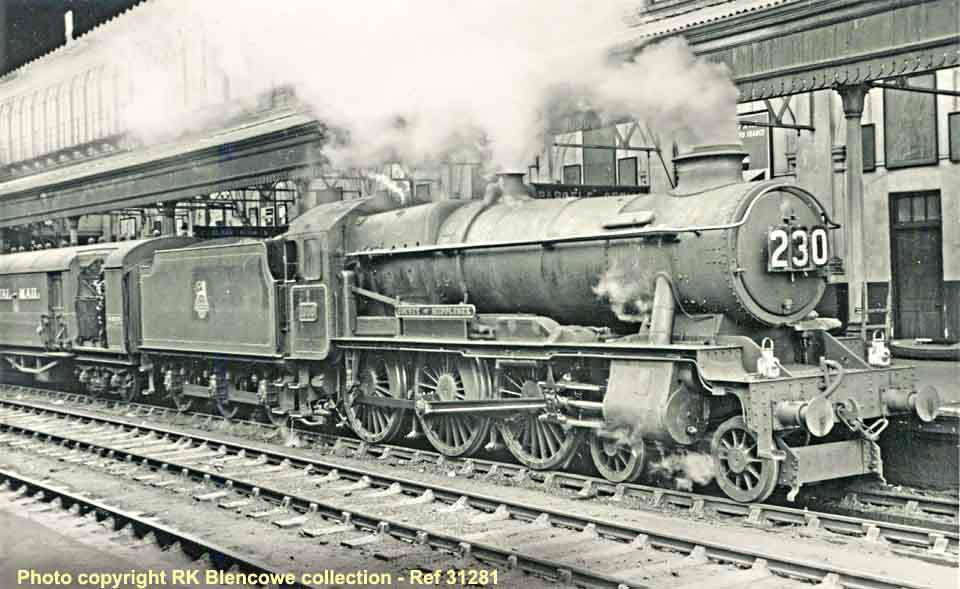
(Above) Built in August 1945, FW Hawksworth's 4-6-0 'County' class No 1000 County of Middlesex, a Bristol Bath Road engine since March 1954, and the only member of the class to have a double chimney from new, has brought train 230 into Exeter St. David's platform 1 on Saturday 7 August 1954. This is the overnight 12.15am Manchester (London Road)-Paignton train which included a Travelling Post Office coach. (Editor's note: the rather scruffy engine is still showing its lined black livery and also a half-lip on the front of the double chimney, which was unique). Photo RK Blencowe Collection, Ref 31281.
(Below) 'Grange' class 4-6-0 No 6874 Haughton Grange shunts empty passenger stock on September 9th 1957. One of the last of the class to be built, No 6874 entered service in April 1939 and was withdrawn in September 1965. Obscured from view in the background is the engine shed at Exeter; established in 1844 by the Bristol and Exeter Railway, and later to be absorbed by the Great Western Railway in 1876, the shed was given the code 'EXE'. Following nationalisation it was re-coded '83C' in from 1950 to 1963; the shed had an allocation of some 35 locos in the 1950s, but during its final eighteen months the number was reduced to single figures up to closure to steam on 14th October 1963 and the code was transferred to Westbury. However the Exeter site continued to be used as a fueling and stabling point for diesel locos and DMUs working in the area. In December 1976 Exeter was reinstated as a depot and given a new code 'EX' and in 1980 a new maintenance area was built. 

(Above) BR's headlong rush to get rid of steam! In January 1955, the British Transport Commission (BTC) announced its Modernisation Plan for Britain's railways, the basis of which was to replace BR's aged collection of steam locos with a fleet of brand-new diesel and electric locomotives. In January 1956 the Western Region negotiated a licence with German manufacturers to build three pilot-scheme Type 4 diesel-hydraulic B-B 'Warship' class locomotives Nos D800-2 at Swindon. However, due to BR's haste to eliminate steam, even before the first had been built, a rash decision was taken to build a further thirty 'Warships' Nos D803-D832 (later Class 42) powered by Maybach engines; this was followed in July 1958 by an order for an additional 33 'Warships' D833-D865 (later Class 43) equipped with MAN L12V18/21B engines, which were built by the North British Locomotive Company (NBL). Here, the third of NBL batch No D835 Pegasus - introduced to traffic August 1960, scrapped October 1971 - awaits departure from Exeter with a train for Plymouth.
(Below) Adding to the locomotive variety at Exeter, Class 9F 2-10-0 No 92239 of 81C Southall shed awaits departure from platform 1 with the 9.05am Liverpool-Plymouth on Saturday 10 June 1961, just two days before the Summer 1961 timetable started on Monday 12 June. Derek Frost notes - 'Today the 9.05am Liverpool-Plymouth was divided: the 1st part V91 started from Manchester and the 2nd part from Liverpool ran as train V93. No 92239 on the 1st part, 4098 on the 2nd part, both locos came on at Shrewsbury.' I believe the arrival time of this train is about 5.30pm. Photo RK Blencowe Archive, Ref 52211.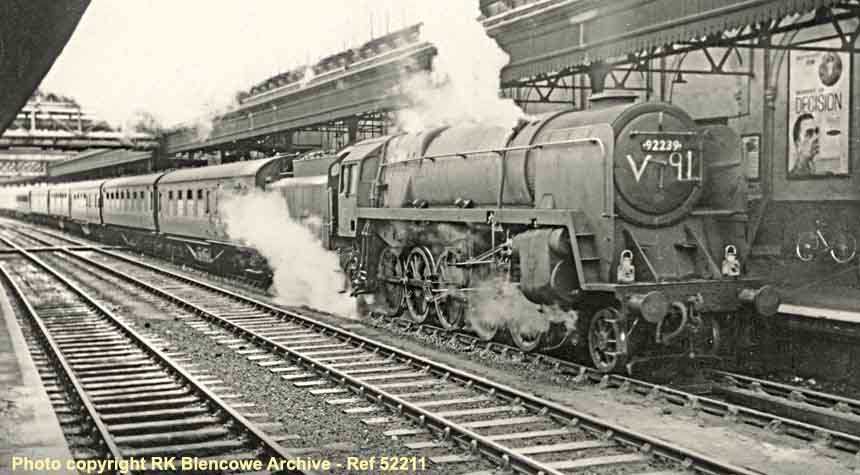
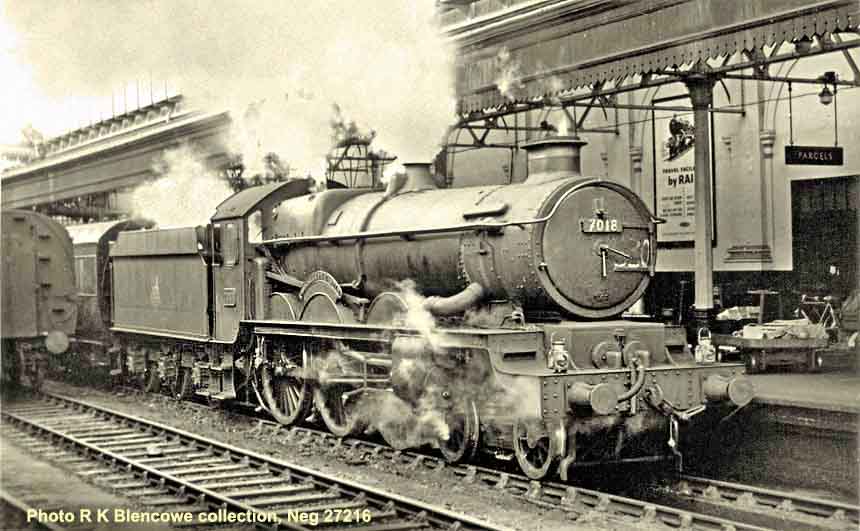
(Below) Exeter St. David's station epitomised the spirit of the Great Western Railway; even for those rail travellers 'just passing through' it was a wondrous sight and a tribute to its renowned designer Isambard Kingdom Brunel. Here the once infamous poor-steaming 'Castle' class No 7018 Drysllwyn Castle is ready for the off from platform 1 in 1956; in May that year the engine became the grateful recipient of thorough testing at Swindon, after which many declared it to be one of the best in the class, producing a much improved performance that exceeded Swindon's expectations. The fitting of a fabricated straight-sided double chimney, as first seen on the 'King' class, together with draughting modifications transformed this poor-performing miscreant into a 'thoroughbred racehorse' which led to similar conversions been carried out on another 65 'Castle' class members, albeit rather late in the day. Photo RK Blencowe Archive, Neg. 27216. 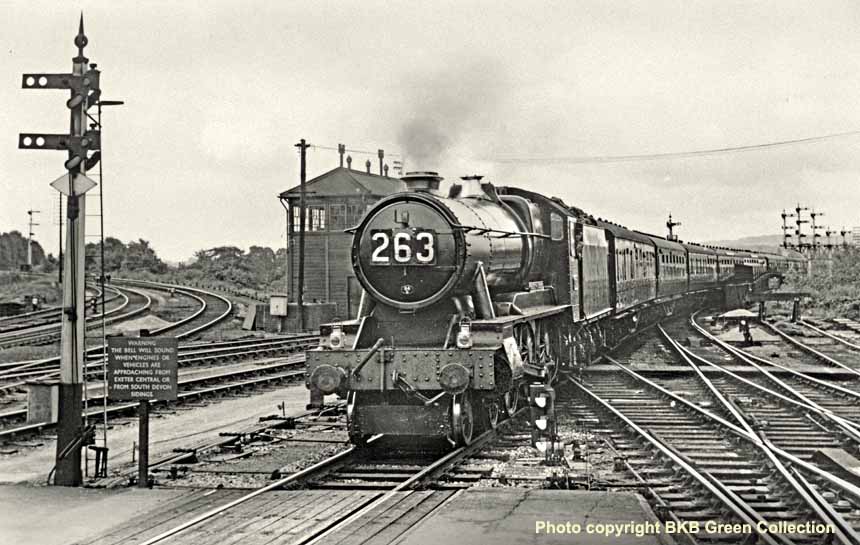
(Above) Entering Exeter St David's from the West is 'County' class No 1013 County of Dorset of Shrewsbury shed with the lengthy 8.00am SX Plymouth-Crewe in 1958; No 1013 was fitted with a double chimney during a Heavy General repair in February that year. The start of the 1 in 37 climb to Exeter Central can be seen curving away to the left, while Exeter West Signal Box is partly obscured by the loco. (Editor's note: No 1013 spent its first five years working in Cornwall and Devon before relocating to Shrewsbury at the end of 1951, thus the engine was a regular performer on the North to West route). Photo BKB Green collection.
(Below) Heading west from Exeter St. David's, 'Castle' class No 5028 Llantilio Castle crosses the River Exe Bridge with the 13.45 SO Bristol-Penzance in August 1953. No 5028 was a long-time resident of Newton Abbot depot, therefore it was very likely to have been a regular choice for this duty up to 1956 when it was transferred to Plymouth Laira. Whilst records indicate that its last visit to Swindon Works was just four months prior, credit must be given to the staff at Newton Abbot for the resplendent condition of the locomotive. Note the marvelous GWR bracket signal for up traffic entering St David's station. (Editor's note: reading from left to right the lower quadrant semaphores are stop signal for the shed yard; stop signal for goods and carriage sidings; stop & distant signals for up relief (platform 6); stop & distant signals for up main (platform 5); stop & distant signals up middle (platform 4). The three smaller signals were for 'calling on' if the line was occupied. In all there were six running lines through St David's station which consisted of Down Main (Platform 1), Down Main (Centre Road), Down Middle (Platform 3), Up Middle (Platform 4), Up Main (Platform 5) and Up Relief (Platform 6). The only other platform at Exeter St. David's was Platform 2, which was a bay situated at the east end of platform 1.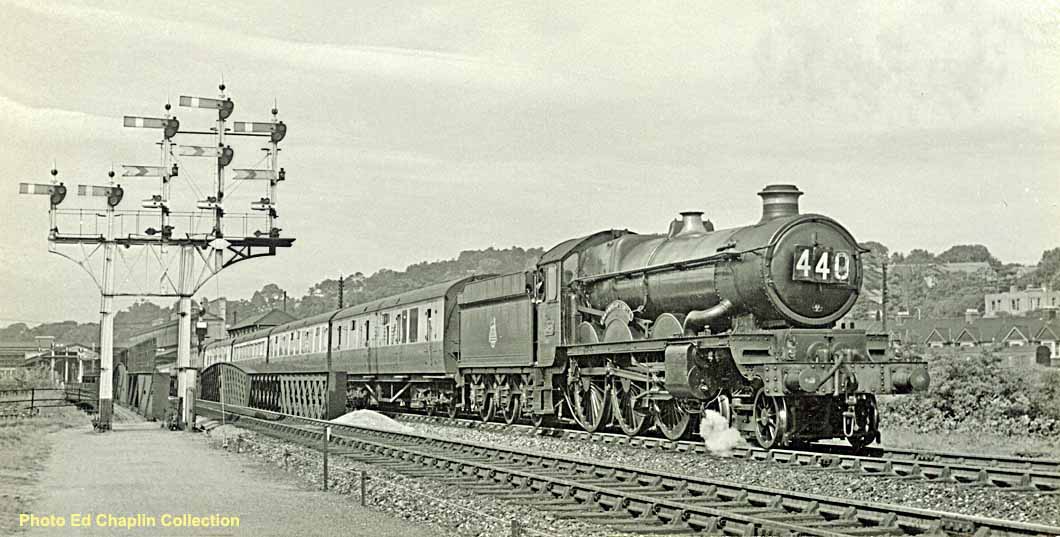
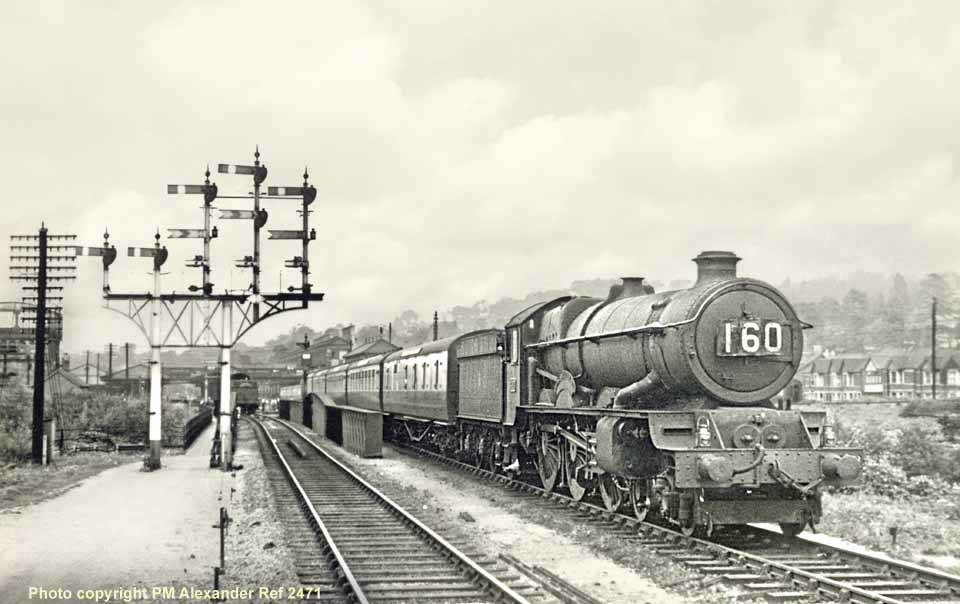
(Above) 'King' class No 6007 King William III of Old Oak Common heads the down 'Cornish Riviera Express' away from Exeter St David's on Wednesday 31 August 1949. To all intents and purposes No 6007 was the second 'King' class member to bear this name and number; the first being written off on 15 January 1936 following an incident at Shrivenham when the loco was hauling the overnight 9pm Penzance-Paddington sleeper at 50-60 mph and ran into five full coal wagons and a brake van that had broken away due to a coupling failure on a South Wales to Old Oak coal train. Swindon made a start on building a 'new' engine using the boiler and many component parts from the crashed locomotive, so it wasn't entirely a new build from scratch - consequently for accounting purposes No 6007 officially remained a 1928-built engine, and not built in March 1936. (Editor's note: the train reporting number for the 'Cornish Riviera Express' was later changed to the more often seen '130' until 1959, then amended to '133' and also '416' and '426' were used in the latter years of the steam-hauled service). Photo PM Alexander Ref 2471.
(Below) 'Castle' class No 5050 Earl of St. Germans (renamed from Devizes Castle in 1937) heads through Exminster with train 247, the Monday-Friday 9.15am Liverpool-Plymouth on Wednesday 15 September 1954. Exminster is barely five miles south of Exeter St. David's and one mile north of the 560 yard-long water troughs. The loops at the station allowed fast trains to overtake slower traffic plus a number of sidings in the vicinity provided storage for a large number of extra coaching stock used on a Summer Friday night and Saturday only, hence they remained inactive during the week and idle for most of the Winter months. Photo SV Blencowe Archive, Ref G258. 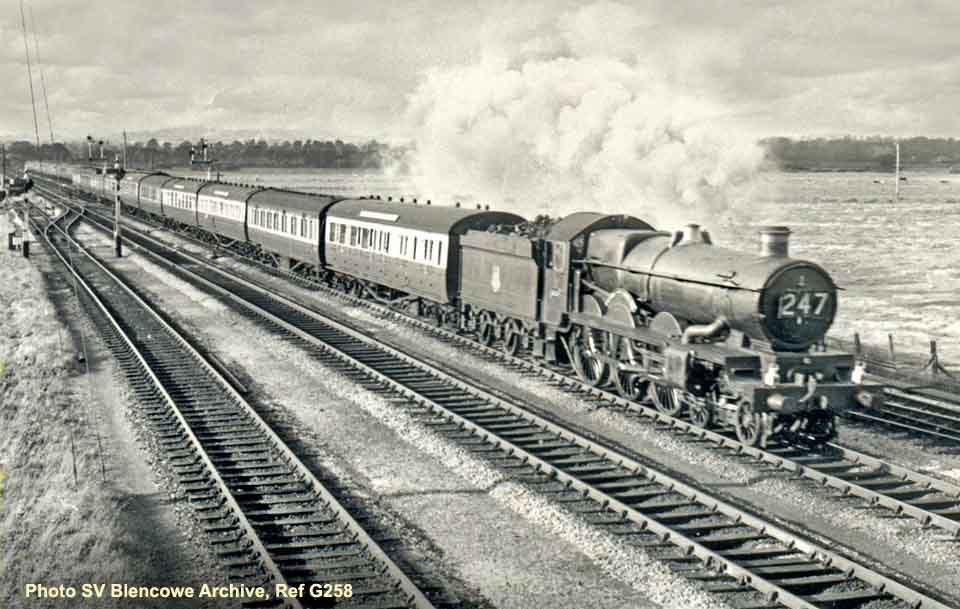
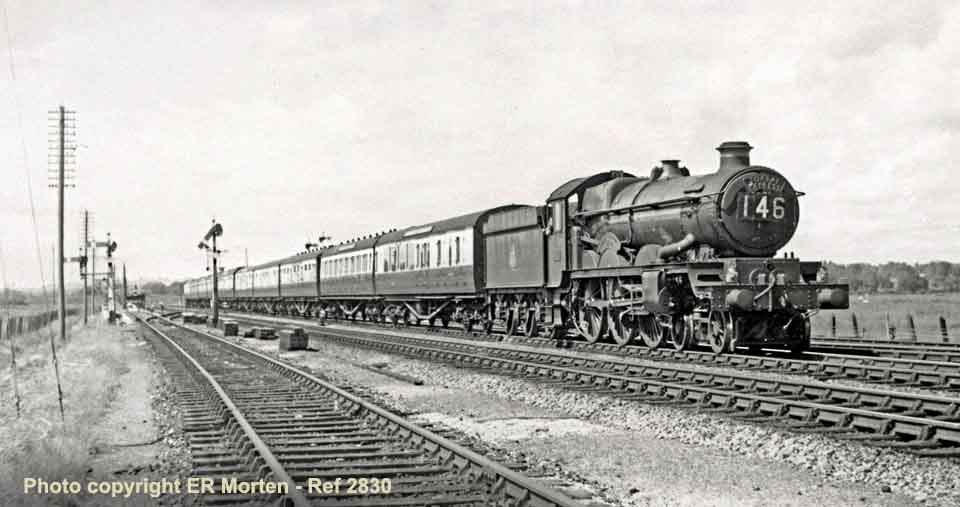
(Above) Exminster is not the most photogenic of places, but this is a fine shot of 'Castle' class No 5071 Spitfire heading the down 'Torbay Express' on Tuesday 14 July 1953. Built in June 1938, and originally named Clifford Castle, No 5071 was one of twelve 'Castles' Nos 5071-5082 to be renamed in the autumn of 1940 to commemorate the RAF and RNAS aircraft that served during WWII. Apart from a short spell at (83C) Exeter in mid-1940, No 5071 was based at Newton Abbot from new until the loco was transferred to (85A) Worcester in September 1957, and later, (85B) Gloucester. It was withdrawn in October 1963 with a mileage of 1,150,913. (Editor's note: the name 'Torbay Express' was first applied to an existing train service in 1923 and the down train usually slipped a coach at Taunton; its first scheduled stop at Exeter). Photo ER Morten, Ref 2830.
(Below) 'King' class No 6010 King Charles I of (83D) Laira skims over the 560 yard-long Exminster troughs with the 8.20am SO Penzance-Paddington in the Summer of 1956. This train ran non-stop from Plymouth North Road, departing at 11.18am and arrival at Paddington at 5.15pm. Exminster troughs was situated one mile south of Exminster station by MP200. 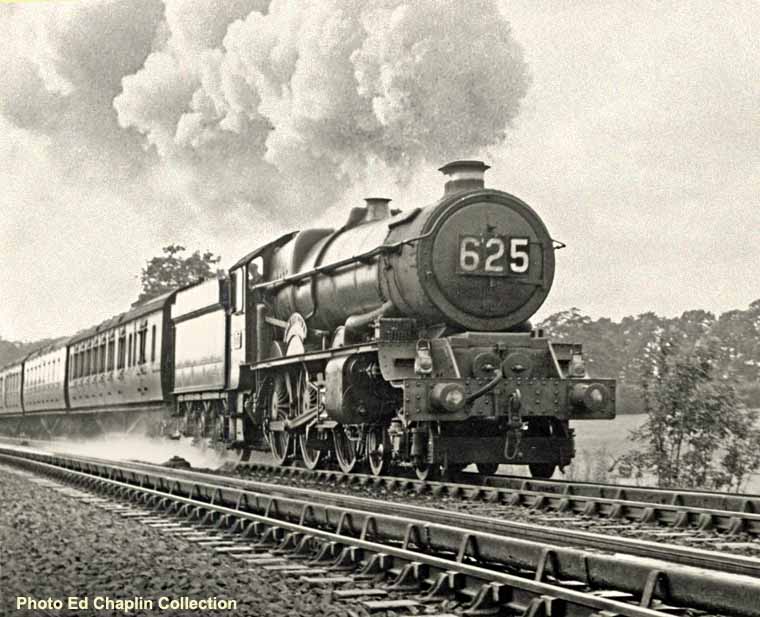
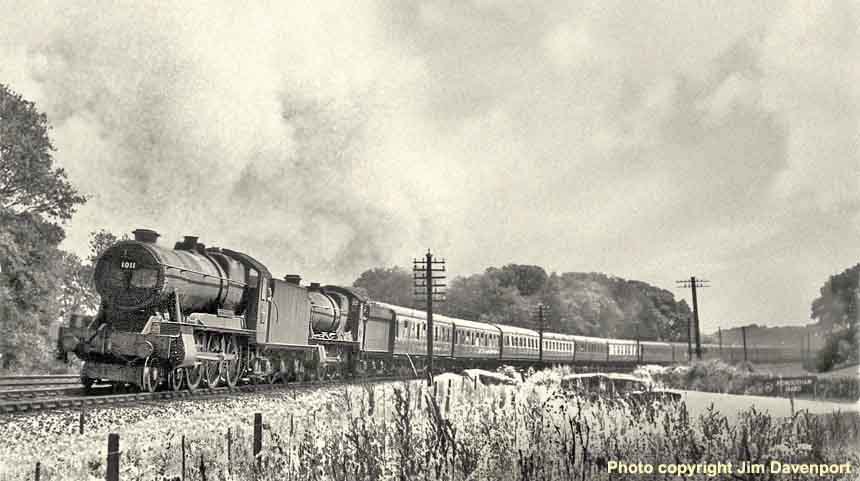
(Above) 'County' class No 1011 County of Chester and 'Hall' class No 6908 Downham Hall (both long-time Bristol Division engines) are captured by the camera passing Powderham Hard with train F50, the 10.20am SO Penzance-Swansea at on Saturday 30 July 1960. This train was often heavily loaded with 13 or even 14 carriages, and so double-heading was required from Plymouth to Exeter where the pilot loco usually came off. If on time, it should pass here about 2.45pm with an eventual 7.35pm arrival at Swansea. Photo Jim Davenport, Robert Humm & Co.
(Below) 'King' class No 6029 King Edward VIII, a long term favourite of (83D) Laira depot, but now resident at (81A) Old Oak, moves swiftly past Powderham Park en route to its next stop at Exeter St. David's. The engine is displaying the wrong code, it should be M52, which was a late-afternoon service from Paignton to Nottingham (Victoria) involving many stops along the way. The name of Powderham is derived from the word 'Polder' - originally a Dutch word for reclaimed marshes. Photo Jim Davenport , Initial Photographics Ref 1221. 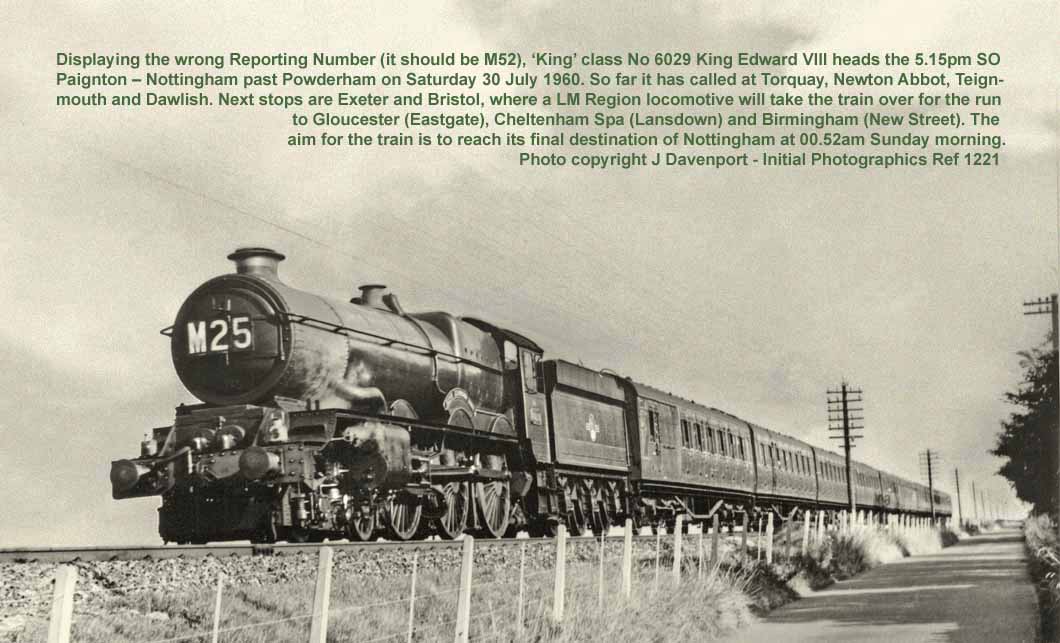

(Above) Positively gleaming in its smart blue livery, 'King' class No 6023 King Edward II of (83D) Laira heads the down 'Cornish Riviera Express' along the shore of the River Exe at Powderham near Starcross on Tuesday 20 February 1951. The resplendent blue paintwork was chosen in 1948 by British Railways as the 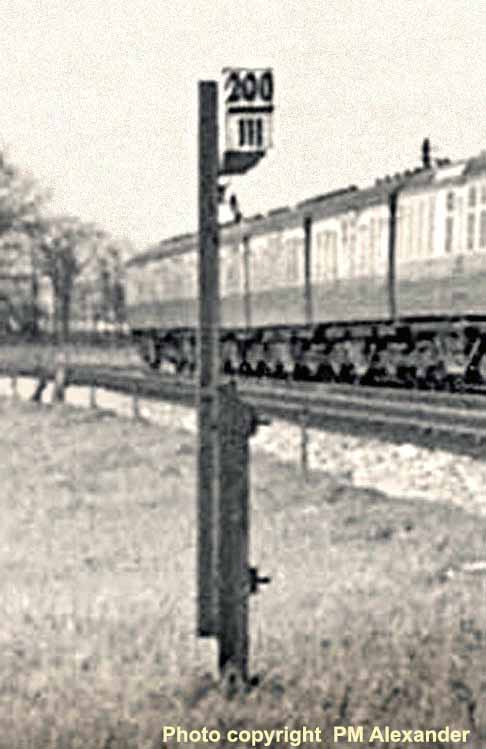 future standard livery for its Class 8P locomotives, but 12 months after this photo was taken the blue livery was replaced by BR's preferred Brunswick Green which the WR used extensively on their 4-6-0 express passenger locomotives, and even on some less important classes. The train formation is made up of a uniform rake of chocolate and cream coaching stock led by two Hawksworth-designed carriages which have flatter sides and different positions for the destination boards. Note also MP200¾ by the up line. Photo PM Alexander.
future standard livery for its Class 8P locomotives, but 12 months after this photo was taken the blue livery was replaced by BR's preferred Brunswick Green which the WR used extensively on their 4-6-0 express passenger locomotives, and even on some less important classes. The train formation is made up of a uniform rake of chocolate and cream coaching stock led by two Hawksworth-designed carriages which have flatter sides and different positions for the destination boards. Note also MP200¾ by the up line. Photo PM Alexander.
(Below) In complete contrast, this grubby 'Modified' Hall No 6991 Acton Burnell Hall, a long-time favourite of (81C) Southall, looks in a disreputable state as it heads the 07.30am SO Newcastle to Paignton near Starcross on July 30 1960. If the marathon 388-mile journey from Tyneside goes according to schedule, the expected time of arrival in Torbay is around 5.30pm; indeed as the train approaches Starcross the splendid views of the Exe Estuary may lull holidaymakers into thinking that they will very soon be at Paignton, but there is still another twenty miles to go before arrival at their destination. Photo BKB Green, Initial Photographics Ref 1534. 
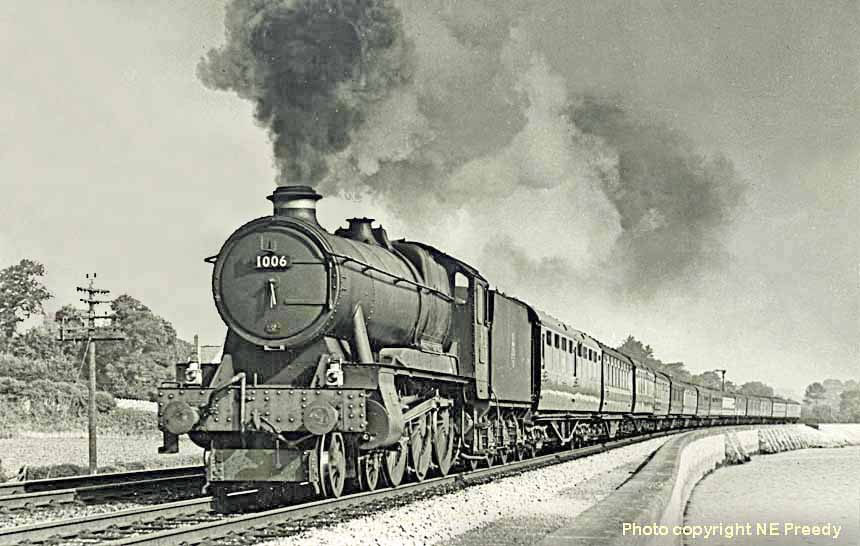
(Above) Working hard with its 14-coach load, 'County' class No 1006 County of Cornwall of (83D) Laira shed, heads west at Starcross (182 miles from London) with a down express on Wednesday 1 August 1951. Built in 1945, the engine was named three years later, but it had to wait a further 10 years before it would benefit from a double chimney; this resulted in improved steaming capabilities and increased performance which it had suffered due to the poor quality of the post-war coal available. Photo NE Preedy.
(Below) 'Hall' class No 6923 Croxteth Hall of (81D) Reading shed passes Dawlish Warren station with train 1H44, the 3.10pm SO Paignton-Wolverhampton, due at Wolverhampton (Low Level) at 9.41pm. Photo RK Blencowe, Ref 12527. 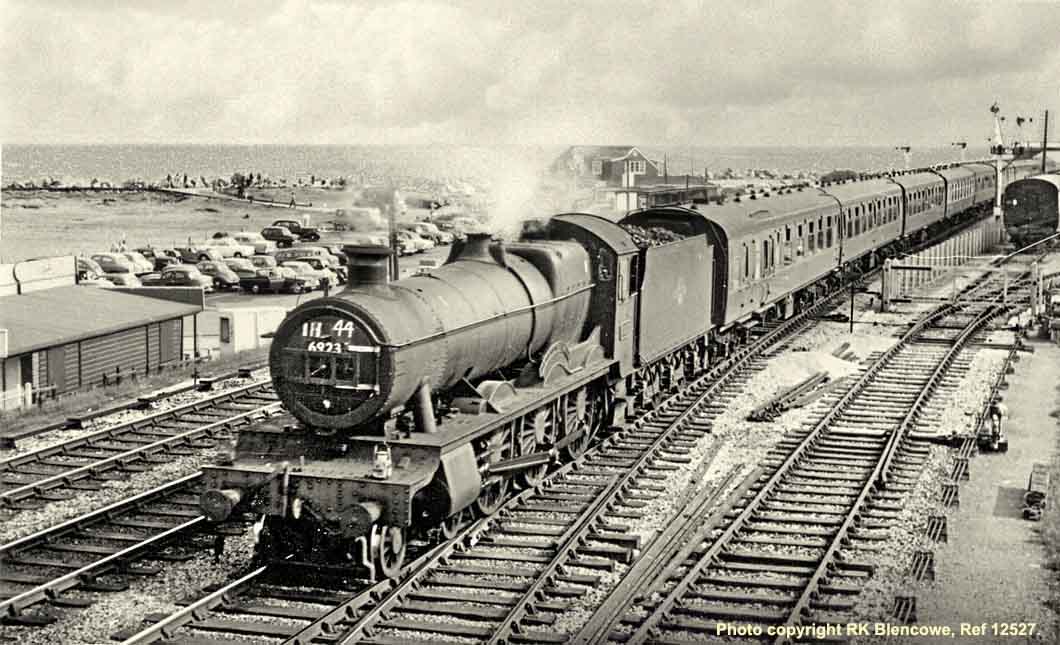
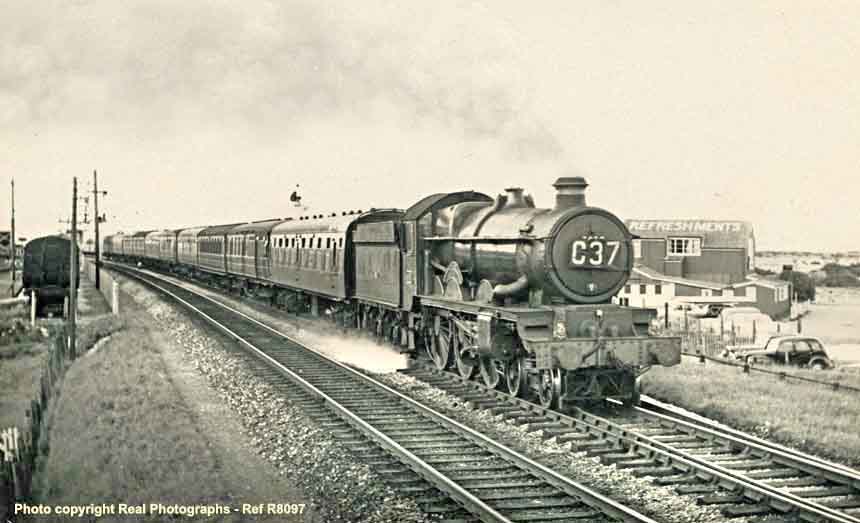
(Above) On Saturday 3 September 1960, 'Castle' class No 5058 Earl of Clancarty of (83D) Laira speeds through Dawlish Warren station with train C37, the 12.21pm SO Cardiff-Newquay, a journey of some 245 miles with a scheduled arrival at Newquay by 6.30pm. The train formation is made up of a mixed set of elderly LMR, ER and Great Western coaching stock, and is due to pass here about 4.15pm. Photo REAL photographs, Ref R8097.
(Below) The splendidly named 'Castle' class No 7017 GJ Churchward of (81A) Old Oak Common depot passes Dawlish Warren at speed with the Down 'Torbay Express' on Wednesday 15 September 1954. Departing Paddington at 12 noon, its first stop was Exeter at 2.52pm and so it should be passing here about 3.15pm. The train was normally made up of ten coaches with a scheduled arrival time of 4.10pm at Kingswear. The Up and Down duties were shared by Old Oak and Newton Abbot depots. Photo SV Blencowe Collection, Ref G2590.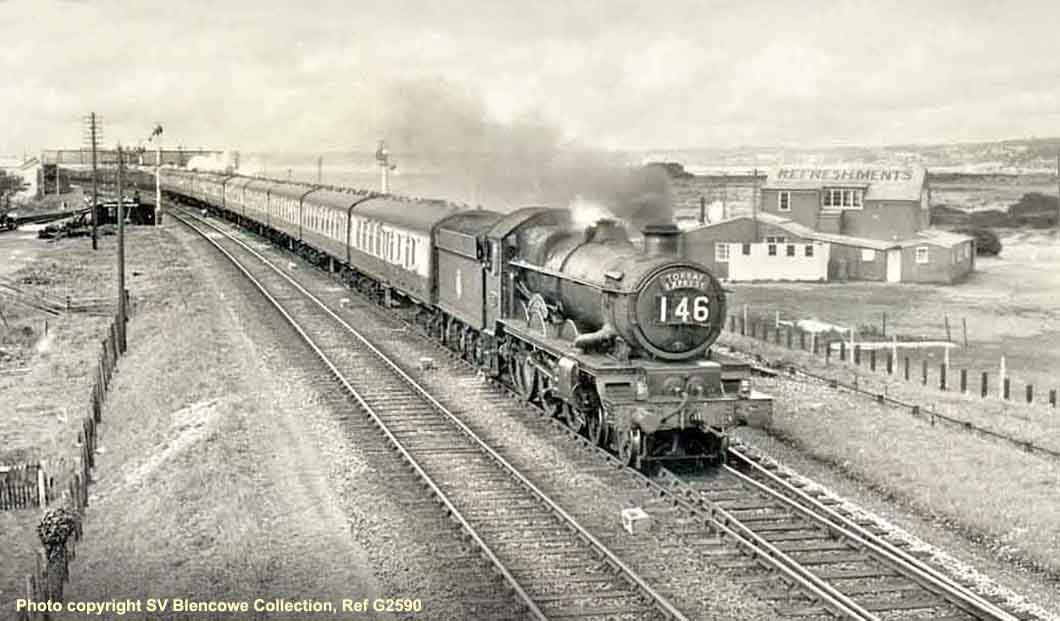

(Above) The distinctive red sandstone outcrop of Langstone Rock is visible in the background, as 'Hall' class No 6944 Fledborough Hall of Cardiff Canton approaches Dawlish Warren with train 1T44 on Saturday 24 June 1961. I don't know which service this is, but judging by the load of ten carriages my thought is the 3.20pm SO Kingswear-Cardiff, due to arrive there at 8.30pm. During the course of its life, No 6944's home sheds from 1948 included (SPM) St. Philips Marsh followed by spells at Old Oak Common, Shrewsbury, Cardiff Canton and finally 81F Oxford from where it was withdrawn in December 1965. Photo Jim Davenport, Initial Photographics.
(Below) This photo has a certain rarity value since it was very unusual to see a 'King' class working the 'Cornishman'; the haulage for this service was a Laira 83D duty by a Class 7P 'Castle', a Class 5MT 'Hall' or a Class 6MT 'County', so the use of a Class 8P 'King' was out of the ordinary. Here No 6025 King Henry III forges through the residual sea mist by Langstone Rock, near MP205, a mile east of Dawlish. The 10.30am SX Penzance-Wolverhampton (Low Level) Cornishman was nominated a reporting number 849 from 14 June 1959 to 12 June 1960. 
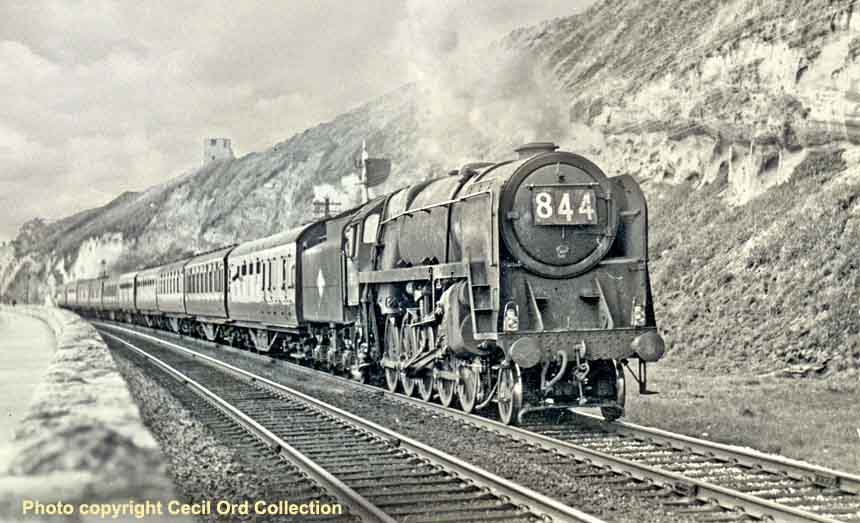
(Above) Class 9F No 92223 of (83D) Laira shed heads train 844, the 10.58am SO Paignton-Nottingham along the sea wall towards Langstone Rock on Saturday 15 August 1959. Completed in June 1958, the engine was exclusively assigned to the Western Region, starting out at (84C) Banbury before joining six other class members at Laira from July 1959. As a consequence every holiday Saturday in the 1959 and 1960 summer timetable one or more Class 9F 2-10-0s were spotted on holiday extras in the West Country. Powerful and popular with crews, they were a most useful addition to the WR fleet, with a total of seventy seven seeing service for the Western Region, mainly on express freight.
(Below) Another freight class commonly seen working passenger trains on a Saturday during the holiday season was the Churchward Class 7F 2-8-0s. Here No 4704 of (81A) Old Oak Common passes MP205 on the sea wall between Langstone Rock and Dawlish with the 1.20pm SO Paddington-Kingswear on Saturday 15 July 1961. In Richard Woodley's fine article in 'Steam Days' magazine (July 2013 issue) he describes in great detail the use of these engines on the WR's passenger trains, and informs us that this particular working is train C87 (number not carried) due at Kingswear at 6.15pm. Photo TW Nicholls, Bristol.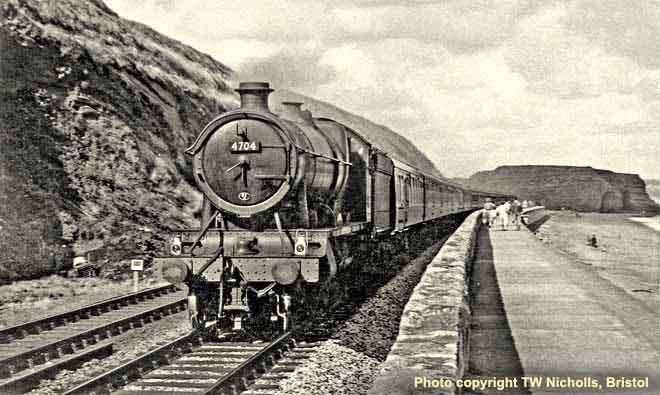
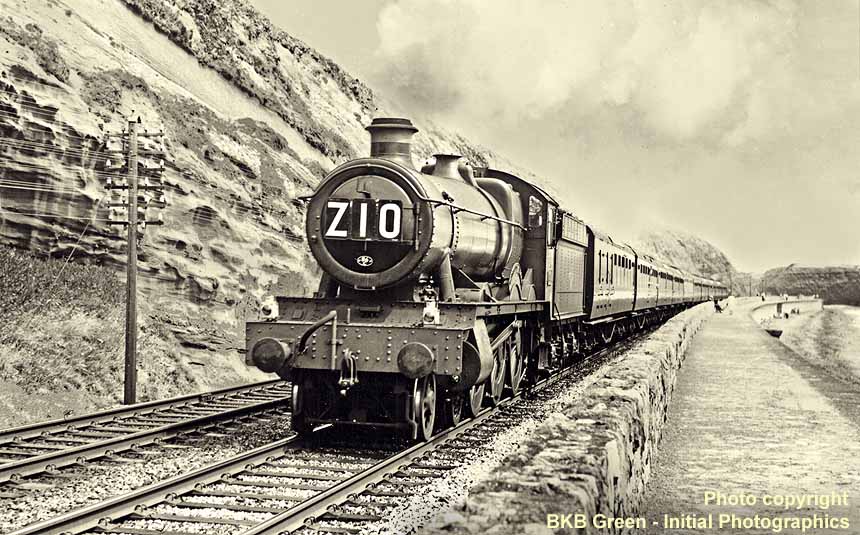
(Above) The resplendent condition of 86C Cardiff Canton's 'Hall' class No 6939 Calveley Hall of (86C) was typical of the cleanliness associated with the Cardiff depot; the locomotive is heading train Z10, the 'Cardiff & Newport Holiday Express' along the sea wall just south of Langstone Rock on Friday 29 July 1960. The 'Holiday Express' service operated Monday to Friday inclusively, with a choice of five different places of interest, one for each day of the week; today the holiday destination being Paignton. The day excursions were ideal for spotters (of all ages) and the same well-prepared engine was normally used for the duration of the week. (Editor's note: the engine was one of 55 class members that came into service without nameplates, as happened with the newly-built 'County' class locomotives. This was due to a severe shortage of brass following WWII and Nos 6916 to 6970 had to run with only 'Hall Class' stencilled on the wheel splasher). Photo Initial Photographics.
(Below) CB Collett's 'King' class No 6018 King Henry VI of Old Oak Common shed approaches Dawlish station with the down 'Cornish Riviera Express' on Saturday 15 August 1959. There is no need to write more, just enjoy this photo from the Cecil Ord collection. 
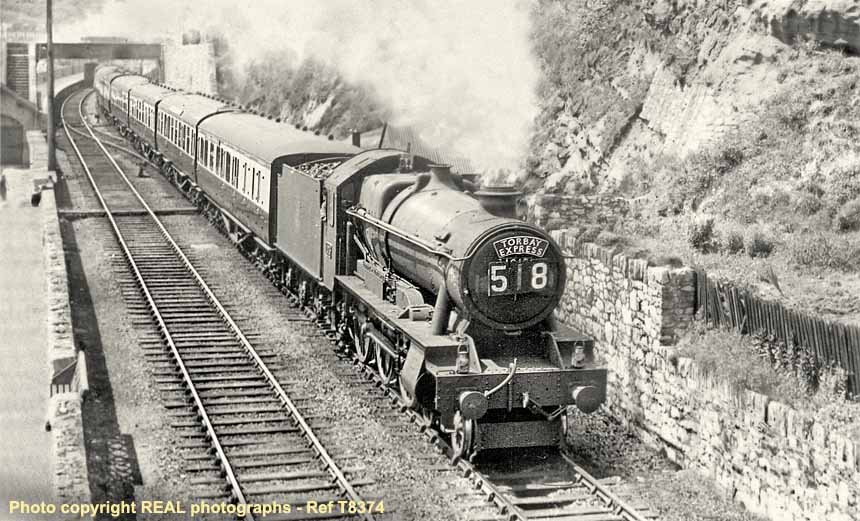
(Above) As seen from Sea Lawn Footbridge, 'County' class No 1015 County of Gloucester heads the up 'Torbay Express' through Dawlish station en route to Exeter St David's and then onwards for the non-stop to Paddington. No date is given but the up 'Torbay Express' was train number 518 from 23 May 1949 to 29 June 1952, and 1015 was an 81A engine up to its transfer to Laira in December 1950 and so my belief is the photo was taken in 1950. The train is at the spot where the latest collapse of the sea wall defences occurred in February 2014, (Editor's note: the engine is also sporting a lined black livery which it retained for a number of years to come). Photo REAL photographs, Ref T8374.
(Below) 'Hall' class No 5959 Mawley Hall of 83C Exeter leaves Dawlish station on Saturday 26 July 1958 with train 527, the 9.10am SO Kingswear-Birmingham (Moor St.). In his splendid book 'Operation Torbay', WS Becket mentions the equivalent train of previous years (train 527, 9.43am ex-Paignton, 10am ex-Torquay). He writes - 'The route taken by the train was strange, it ran up the London line as far as Westbury where it branched off to run through Trowbridge, joining the Bristol main line at Thingley Junction; a call was made at Swindon before running on to Didcot to join the northern main line…' Photographer Ben Brooksbank noted the train was running some 20 minutes late; the time at Dawlish was 10.45am and so it will be 4.30pm at best before Moor Street is reached. 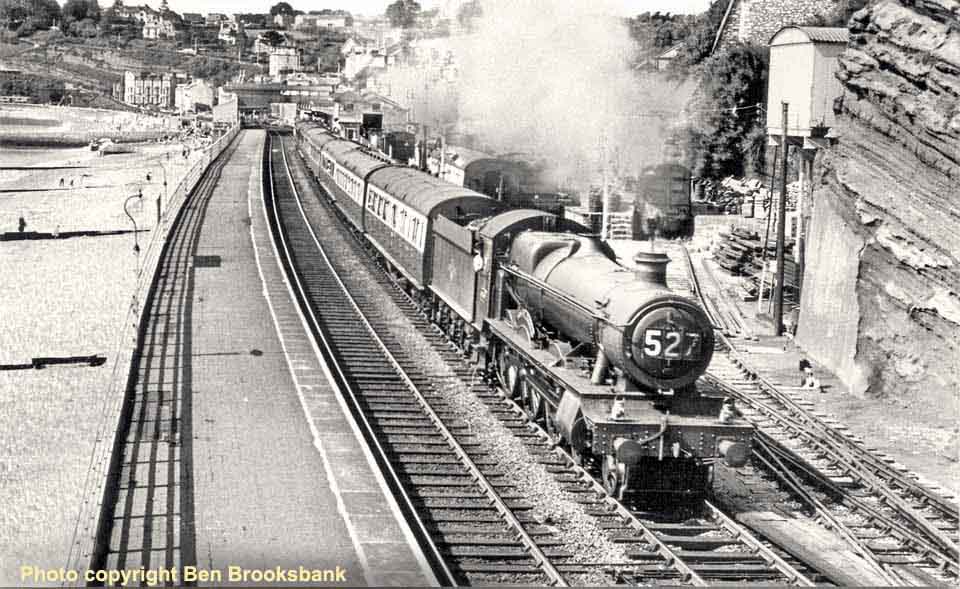
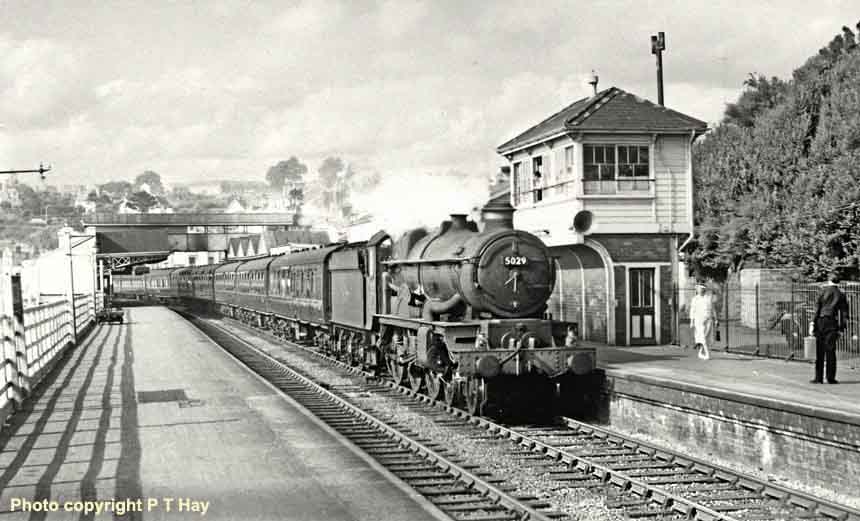
(Above) Renowned 'Castle' class No 5029 Nunney Castle eases to a stop at Dawlish station with an unidentified up express in August 1959. Built in 1934, No 5029 spent much of its working life based at Old Oak Common; it was transferred to Worcester in 1958 followed by a six-month spell at Newton Abbot in 1959, then a move to Laira beckoned before a final move to Cardiff East Dock, from where it was withdrawn in December 1963 and sold to Woodham's scrapyard at Barry in South Wales. No 5029 languished in the yard for twelve years before being rescued for preservation in May 1976 by a private consortium and the Great Western Society. Following a major effort the restored locomotive has become a favourite for steam specials pending its main line running certificate. (Editor's note: The images of raging storms at Dawlish clearly show just how exposed the down platform is to the elements. Over the years the station has been battered by extreme weather conditions on a number of occasions. Photo PT Hay.
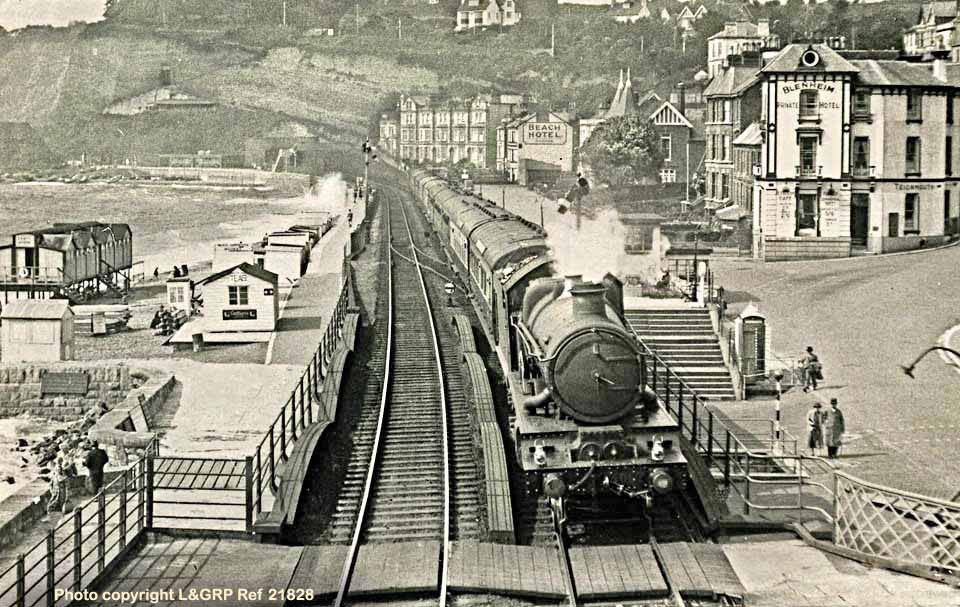
(Above) Viewed in typical post-war condition, 'Castle' class No 4087 Cardigan Castle shuts off steam ready for its scheduled stop at Dawlish station with an up express. No 4087 was constructed in June 1925 and withdrawn in October 1963, having served its time almost exclusively at Laira and Penzance depots, before completing its work at (82B) Bristol St. Philips Marsh. It was a Plymouth Laira engine at the time of this 1940's photo; note the unusual position of the signals, presumably to assist sighting by crews, and particularly noticeable is the distinct lack of any other mode of transport . Photo L&GRP Ref 21828.
(Below) In complete contrast to the photo above is the number of road vehicles parked on Marine Parade in this shot of 1949-built 'Modified' Hall class No 7901 Dodington Hall of 82A Bristol Bath Road appropriately heading the 'City of Bristol Holiday Express' through Dawlish on Monday 30 July 1956. As we were reminded during the severe storms of February 2014, Brunel's line kept very close to the sea here. This panoramic view shows Langstone Rock a mile away above the second coach and on the horizon beyond the Exe estuary is the eastern bank where the terminus station at the holiday resort of Exmouth is served by SR. [Editor's note: as mentioned earlier, the concept of the 'Holiday Express' was five destinations on five consecutive days to places of interest, however the destination was not always a seaside resort, although sand and sea were the main attractions). 
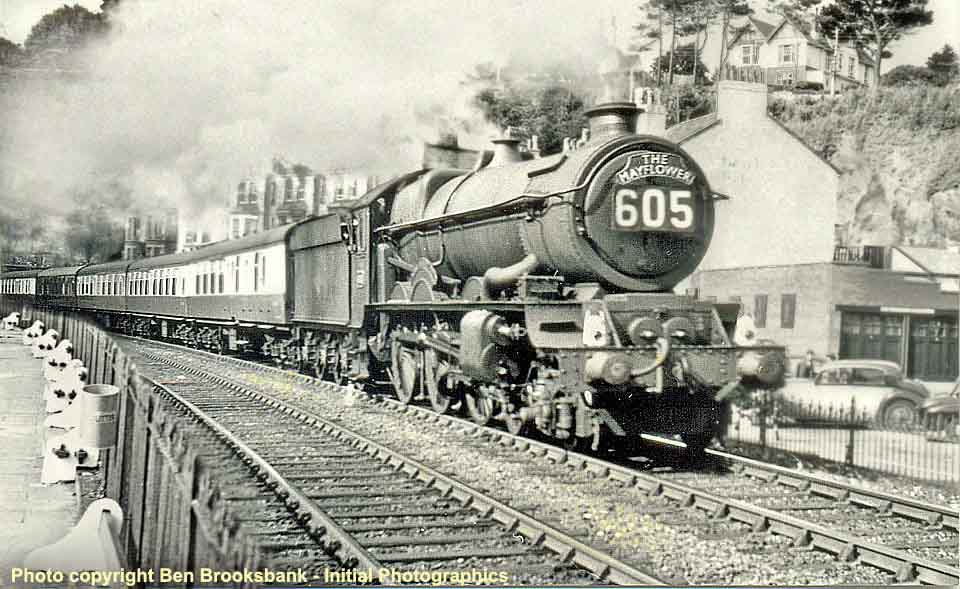
(Above) 'King' class No 6018 King Henry VI of (81A) Old Oak Common approaches Dawlish station with the up 'Mayflower', the 8.30am Mon-Sat, Plymouth-Paddington express on Saturday 26 July 1958. It was due to leave Newton Abbot at 9.26am and its next station stop is Exeter St David's at 9.56am. From then on it will have to take its chances as on this holiday Saturday, since it was necessary to squeeze in every train that could be managed. The public timetable quoted planned stops at Taunton (10.40am) and Westbury (11.40am) with the train aiming for a 1.25pm arrival at Paddington. Today Ben reports it is was passing here about 10 minutes late and so the driver will be trying to make up for lost time, but with the extra carriages from Kingswear added at Newton Abbot, the engine now has a full load to contend with. Also in the offing was a possible stop at Reading General station to take on a pilot engine which Paddington required for another Holiday train to the West Country. After a service stop at Ranelagh Bridge, No 6018 will most likely return to Plymouth on the 3.30pm down. (Editor's note: the early alloy headboard should be noticed, being replaced the following year with a more evocative effort, inset with a copy of the famous merchant ship). Photo Ben Brooksbank, Initial Photographics.
(Below) 'King' class No 6029 King Edward VIII of (83D) Laira depot, approaches Dawlish station with the up 'Mayflower' on Saturday 10 August 1957. It was timed to depart Newton Abbot at 9.26am, having picked up five extra carriages off the Kingswear branch and so the remainder of the journey to Paddington will be an arduous one, but still within the capabilities of a single-chimneyed Class 8P 'King'; the engine crew will be hoping for a clear path up to London in order to keep to its 1.25pm arrival time. The rear of the 13-coach train has just cleared the 209 yard-long Kennaway Tunnel, the first of the five tunnels heading west through the Parson and Clerk rock formations. Photo ER Morten. 
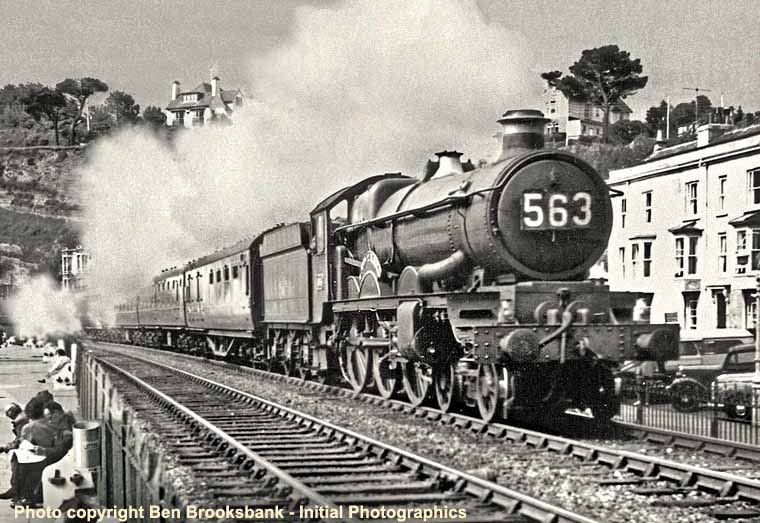
(Above) Although the inter-Regional 'Devonian' did not run as a titled train on Saturdays, train 563, the 8.45am SO Kingswear-Bradford (Forster Square) was dubbed the 'Saturday Devonian'. Here 'Castle' class No 5055 Earl of Eldon of (83A) Newton Abbot shed is pulling in to stop at Dawlish's sea-front station on Saturday 26 July 1958. On Mondays to Fridays, the northbound 'Devonian' began at Paignton at 9.15am but this Saturday service began from Kingswear, aiming to reach Bradford by 7.09pm. Today photographer Ben Brooksbank noted the time as 10.23am, therefore the train was running 30 minutes or so late, but I reckon it may reach Bristol by 1.00pm if allowed a good path. Ben logged this engine later in the day at Exeter St David's on train 440, the 1.45pm Bristol-Falmouth and Newquay. That train was due at Exeter at 3.27pm, but Ben noted its arrival there at 5.03pm. As separate information, the weekday down 'Devonian' service left Bradford at 10.15am, and the 'Saturday Devonian' at 9.50am, thus allowing for some disruption to its normal timings. (Editor's note: the locomotive was allocated to Old Oak Common (PDN and 81A) from new in 1936 until moving to Newton Abbot in 1958. The engine reached the magic one million miles in 1953, but thereafter its usage fell by 40%, completing its service with 1,439,900 to its credit). Photo Ben Brooksbank, Initial Photographics. 
(Above) Looking clean and tidy in its GWR livery, 'Hall' class No 4909 Blakesley Hall of Banbury shed enters Dawlish with, I think, the 9.40am SO Paignton-Cardiff in June 1948. Of course, the British Railways livery would not be applied until the locomotive's next overhaul. (Editor' note: constructed in 1929, No 4909 was among the initial batch of eighty 'Hall' class locomotives Nos 4901-4980 (Lot No 254); the engine spent much of its life as a Bristol Division engine). Photo RK Blencowe, Ref 11641.
(Below) Having recently moved from (84G) Shrewsbury to (81A) Old Oak Common depot, 'Castle' class No 5001 Llandovery Castle emerges from the 60 yard-long Clerk Tunnel with train C74, the 10.22am SO Paddington-Paignton service on Saturday 20 August 1960. This long-time Cardiff Canton engine was painted in black livery (along with classmate No 5018) during the war years, but this was soon rectified when the engine was given the usual dark green finish. Shell Cove had its own breakwater and was a popular area for swimmers; the distinctive Horse Rocks marked the outer limit of the cove. Photo CHS Owen.

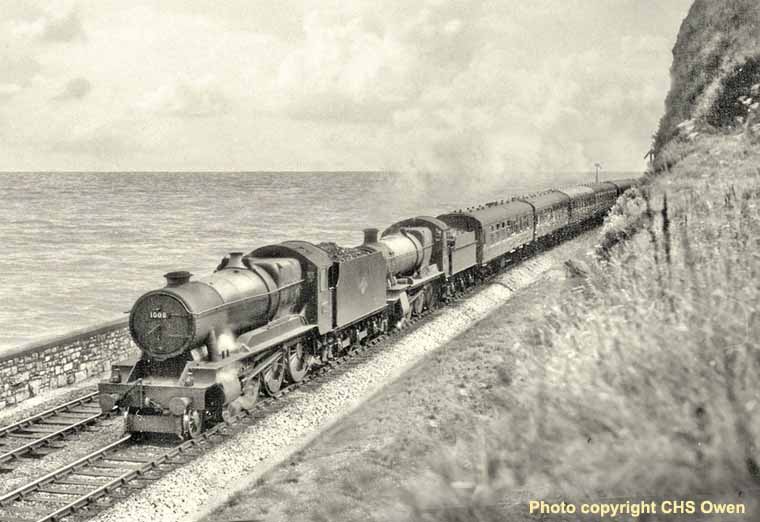
(Above-Below) 'County' class No 1008 County of Cardigan and 'Grange' class No 6849 Walton Grange, both (83D) Laira engines, approach Parson's tunnel just after MP207½ with the 10.20am SO Penzance-Swansea on Saturday 20 August 1960. Since this train was often loaded to 14 coaches it required double-heading over the steep South Devon banks of Dainton, Hemmerdon and Rattery between Plymouth and Exeter. (Below) Later that day, having uncoupled from the 10.20am SO Penzance-Swansea at Exeter St David's, 'County' class No 1008 County of Cardigan has again been nominated a lead engine, this time with 'Hall' class No 5941 Campion Hall at the head of the 12.05pm SO Paddington-Plymouth express. The two engines have just emerged from the 512 yard-long Parson's Tunnel and are crossing the three-arched viaduct, situated at the bottom of Smugglers Lane Holcombe. (Editor's note: the small signal box here was only operational on Summer Saturdays to help out on this very busy section). Both photos CHS Owen. 

(Above) A classic image and a classic location; 'Castle' class No 5050 Earl of St. Germans, currently a (84G) Shrewsbury engine and quite obviously 'pride of the fleet' at this time, heads train 263, the 8.00am Plymouth-Crewe express along the sea wall between Parson's Tunnel and Teignmouth. No 5050's paintwork is fairly gleaming, the brass and copper highly polished, yet the engine is not recorded as entering Works in 1956. Quite remarkable! An excess of steam escaping from the blow-off valves shows that a twelve-coach load is not troubling the locomotive or crew, although there will be much stiffer tests ahead that need to be overcome. Photo N E Preedy.
(Below) BR Class 7MT 'Britannia' Pacific No 70024 Vulcan of (83D) Laira, runs along the sea wall from Parson's Tunnel to Teignmouth with the 5.30am SX Paddington-Penzance via Bristol on Thursday 19 July 1956. This was the last summer before the ten Western Region 'Britannias' Nos 70015-70024 were allocated to (86C) Cardiff Canton and their visits to the West Country became less frequent. Although showing Class A lamps, this was not an express in the true sense of the word; this train was due to stop at many stations en route to Penzance. After Bristol, it was scheduled to call at Bridgwater, Durston, Taunton, Wellington, Tiverton Junction, Exeter and Dawlish; then Teignmouth, Newton Abbot, Totnes, Brent, Plymouth and other principal stations to Penzance; the service even included a stop at Scorrier station, which was very seldom used. Arrival time at Penzance was 3.40pm. Photo Jim Davenport. 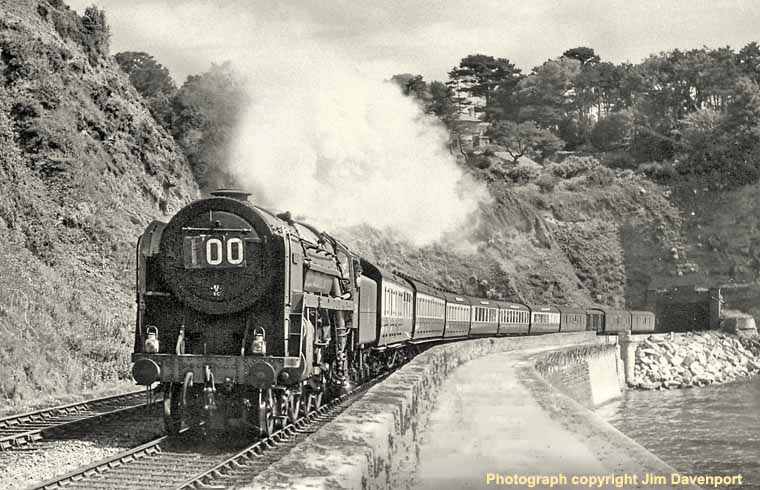
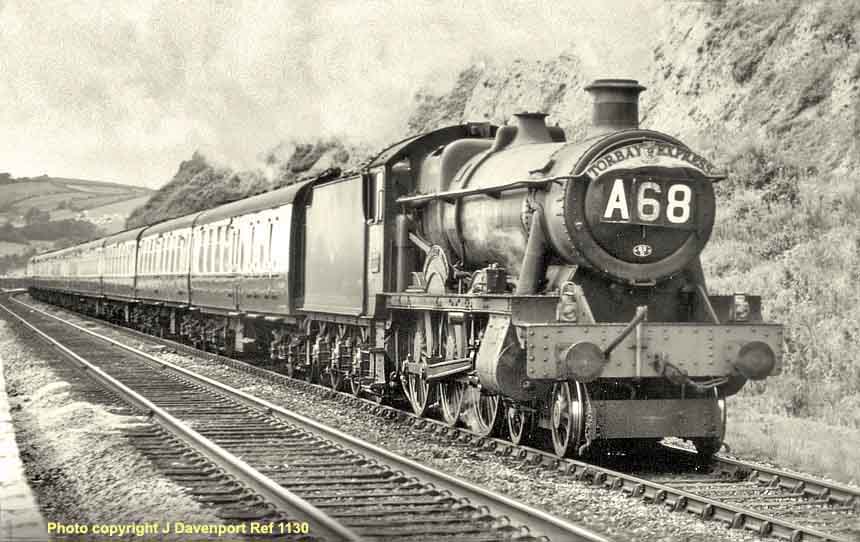
(Above) BR-built 'Modified' Hall No 7916 Mobberley Hall heads a uniform rake of BR Mk1 coaching stock in the WR's chocolate and cream livery along the sea wall between Teignmouth and Dawlish in July 1960. The 'Torbay Express' was very well patronized throughout the 1950s-1960s and was due to pass here around 12.30pm. The down track was modernised the previous year, while the new system of train reporting numbers introduced in 1960 is now in full swing. Photo Jim Davenport, Initial Photographics, Ref 1130.
(Below) The now-preserved 'Hall' class No 4930 Hagley Hall seems to be applying more effort than classmate No 6907 Davenham Hall as the pair head the 7.50am SO Newquay-Manchester (London Road) on the sea wall between Teignmouth and Parson's Tunnel on Saturday 7 July 1958. Both locos came on at Plymouth, with No 4930 operating from (83B) Taunton shed and No 6907 a member of Wolverhampton Oxley (84B) for many years. As the 13-coach train passes Spey Point there are few people about on the sea wall, but all day long there will be a succession of long trains passing on both lines; wonderful! Photo RC Riley, Transport Treasury, Ref 12320. 

(Above) With Sprey Point visible in the distance, Robert Riddles WD Austerity 2-8-0 No 90148 of (83A) Newton Abbot depot trundles past with an 'E' class freight for Hackney Yard (Newton Abbot). Built in 1943, 90148 came into BR stock six years later working initially from (83D) Laira, and later allocated to (86C) 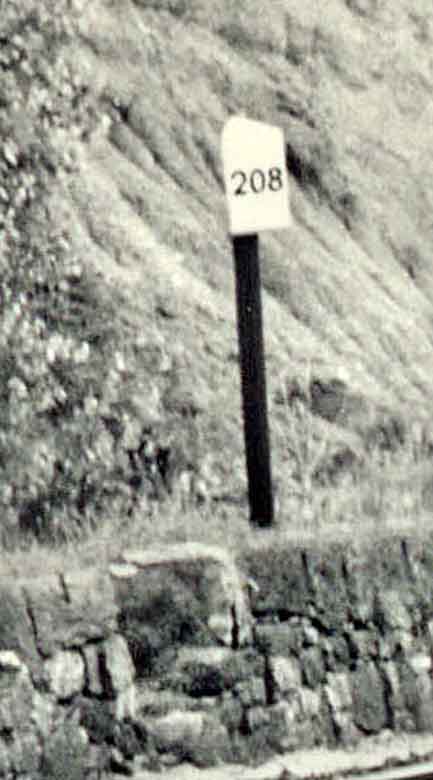 Cardiff Canton and (84G) Shrewsbury. Judging by the well clad couple walking arm in arm along the footpath, the prevalent weather looks mostly wet and cool: a massive disappointment for those sun-seekers who flock to this area year on year. Photo J Davenport, Initial Photographics Ref 779.
Cardiff Canton and (84G) Shrewsbury. Judging by the well clad couple walking arm in arm along the footpath, the prevalent weather looks mostly wet and cool: a massive disappointment for those sun-seekers who flock to this area year on year. Photo J Davenport, Initial Photographics Ref 779.
(Below) Saturday 30 July 1960 must also have been a very disappointing day for sun seekers, as only two souls can be seen on the seawall path. Passing milepost 208 (inset right) is the 07.00 Birmingham-Paignton hauled by a down-at-heel 'Hall' class No 4992 Crosby Hall, an (83C) Exeter engine that probably came on at Bristol. The predominate reporting number of this train was '1C61', the '1' represented by the express headlamps and the 'C50-99' indicated the service was heading for the Exeter district (ie South Devon and Minehead); this ensemble has around thirteen miles to travel before reaching Paignton. The figures on the milepost represent the distance to London on the original route, before the Berks and Hants line and Frome and Westbury cut-off lines were completed. Photo BKB Green, Initial Photographics. 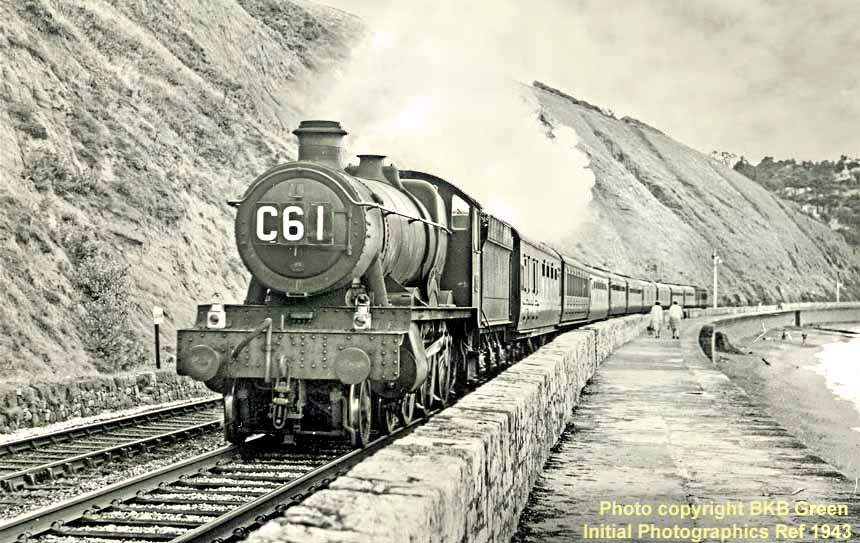
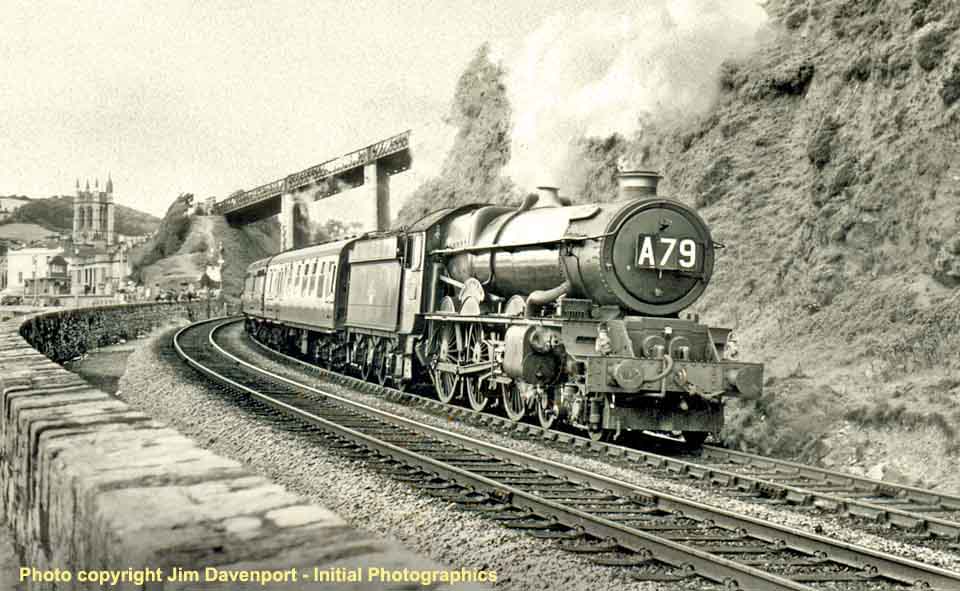
(Above) 'King' class No 6002 King William IV of Laira shed leans to the curve at Teignmouth on train A79, the 8.20am SO Penzance-Paddington, hoping for a fast run to London, however with so many Saturday Holiday extras running on Saturday 30 July 1960, its scheduled arrival time in the capital is highly unlikely. Built in July 1927, No 6002 has barely another two years of reliable service remaining, being withdrawn in September 1962. Shortly after this photo was taken, the 'Warship' and 'Western' class diesel-hydraulics had taken over all the West of England express duties and No 6002 was given useful employment mainly on the Paddington-Wolverhampton expresses. The quite severe camber on the curve is very pronounced in this wonderful image by Jim Davenport, Initial Photographics.
(Below) This view from the footpath at Teignmouth's East Cliff shows 'Castle' class No 5078 Beaufort of (83A) Newton Abbot heading the 8am Plymouth-Crewe on Wednesday 8 August 1956. With the possible exception of London Paddington, this seawall location is quite possibly the most photographed anywhere on the Western Region, and with good reason; steeped in history and with fond memories of summer holidays by the sea, the added bonus of watching express passenger trains rounding the curve is hard to resist. This is a fine shot with holidaymakers in shirtsleeves, a beautifully kept engine, a tidy track, and an attractive sea front; all items contributing to a wonderful image. In the middle distance is Slocums Bridge and the cutting leading inland to Teignmouth station; originally a tunnel in Broad Gauge days.

(Below) Taken from the bridge at East Cliff, this panoramic view looking towards Dawlish shows 'Hall' class No 5933 Kingsway Hall of 81D Reading approaching Teignmouth station with train 827, the 10.35 SO Wolverhampton-Paignton express on Saturday 14 September 1957. The train is due at Paignton at 4.50pm but the passengers will be lucky if it reaches there on time. A journey of well over six hours from the Midlands seems excessive, but with so many people travelling by train to holiday destinations in Devon and Cornwall, long delays were inevitable. No 5933 served Reading depot for over 10 years, but on a busy holiday Saturday the WR ruthlessly deployed engines from far and wide over every part of the system when the timetable went awry. 81D Reading was one such shed; likewise 86G Pontypool Road, where engines were seized upon, even on the Paignton to Paddington services. Photo T Wright. 
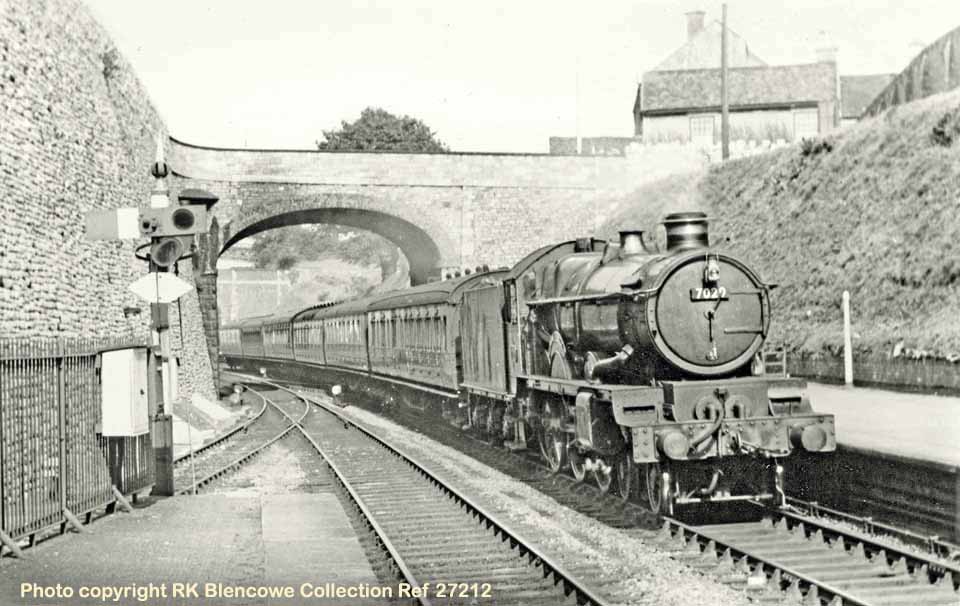
(Above) A down semi-fast formed of six non-corridor carriage stock enters Teignmouth station behind 'Castle' class No 7029 Clun Castle of (83A) Newton Abbot. The date is reckoned to be 1956, the same year that the locomotive moved for a short stint to Plymouth Laira (83D); it later returned in the summer to 83A where the engine was based for 80% of its BR service life. No 7029 is seen coupled to a Hawksworth straight-sided tender at this time, but little else has changed since it was built in May 1950. The locomotive remained at 83A until it was assigned to Old Oak Common in May 1962. It was withdrawn in December 1965, having achieved more than 650,000 miles and a future candidate for preservation. At the end of the up platform is a central-pivoting siding signal, complete with colour-coded finial; finished off with a metal ladder topped by a wide-band safety ring. Photo RK Blencowe collection, Ref 27212. 
(Below) The gang of permanent way workers pause for a moment as 'Castle' class No 5071 Spitfire of (83A) Newton Abbot passes Teignmouth sports ground with the down 'Cornishman' on Friday 22 July 1955. Completed in June 1938 as Clifford Castle it was later renamed Spitfire in September 1940 to commemorate perhaps the most famous fighter aircraft from 'The Battle of Britain'. The locomotive was based at Newton Abbot from new until its transfer to (85A) Worcester in September 1957, and later (85B) Gloucester; it ended its days in October 1963 based at (82B) Bristol St. Philips Marsh having clocked up 1,150,913 miles. The renaming of the twelve 'Castles' (Nos 5071-5082) after famous RAF and RNAS aircraft was a sound move by the GWR since it gave the engines more affinity with the paying public and enthusiasts alike. Photo Les Elsey.
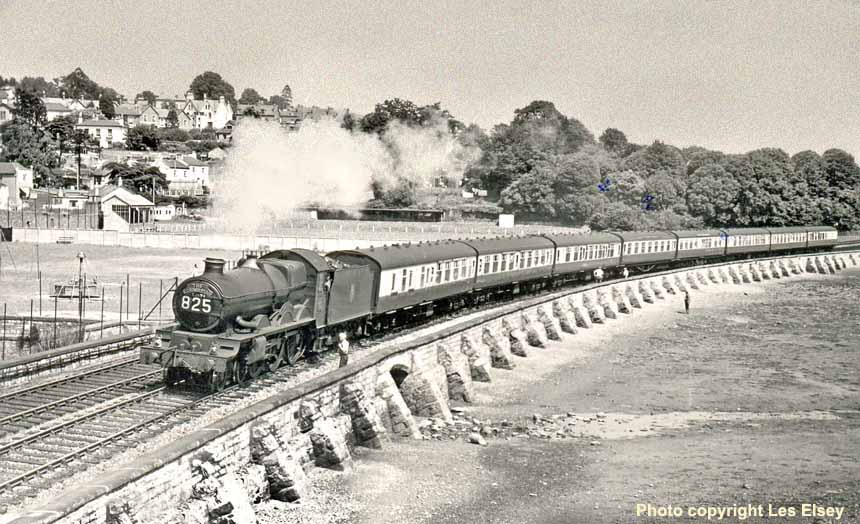
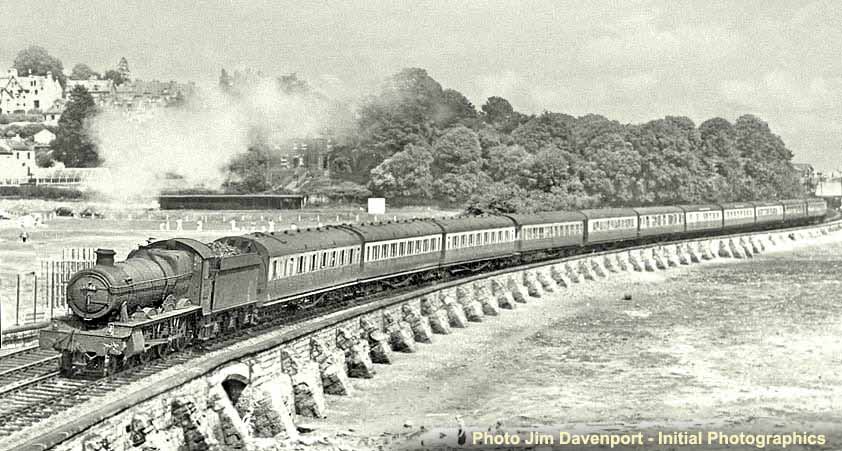
(Above) 'Hall' class No 4944 Middleton Hall heads the 6.55am SO Paddington-Penzance past Teignmouth sports ground on Saturday 25 July 1953 This is the view from Shaldon Bridge carrying the B3199 road from Teignmouth to Torquay across the estuary; it provided photographers with a great vantage point of trains skirting the River Teign in both directions. No 4944 came from 81C Southall, having reversed light engine the nine miles to Paddington, where a tank engine had already assembled the passenger stock in platform 3. It was recorded as a 'dated train', meaning it ran only between certain dates in the timetable. In 1953, it operated only the Saturdays from 4 July to 22 August inclusive. Photo J Davenport, Initial Photographics.
(Below) This is the view from Shaldon Bridge in the opposite direction, where Castle' class No 4087 Cardigan Castle of (83D) Laira is captured by the camera heading train A83, the 1.28pm Paignton-Paddington on Saturday 7 July 1962. No 4087 is showing some modifications from our previous picture of the engine at Dawlish; including the fitting of a double chimney, a 4-row superheater and new front frames, giving an all round improved performance. But despite these modifications (plus the fitting of a lubrication container just above steam pipe in February 1958) No 4087 was no longer required in October 1963 and withdrawn from service. For the record, the B3199 Teignmouth to Torquay road became the A379 in 2015. Photo CHS Owen. 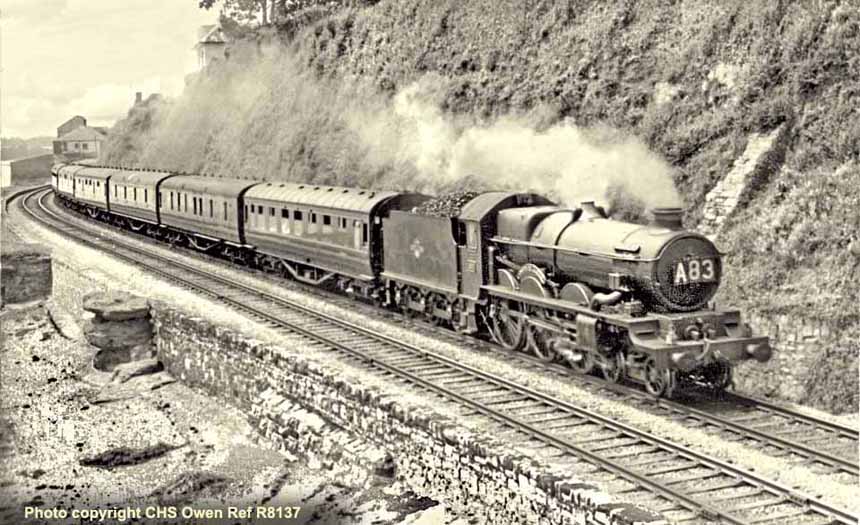
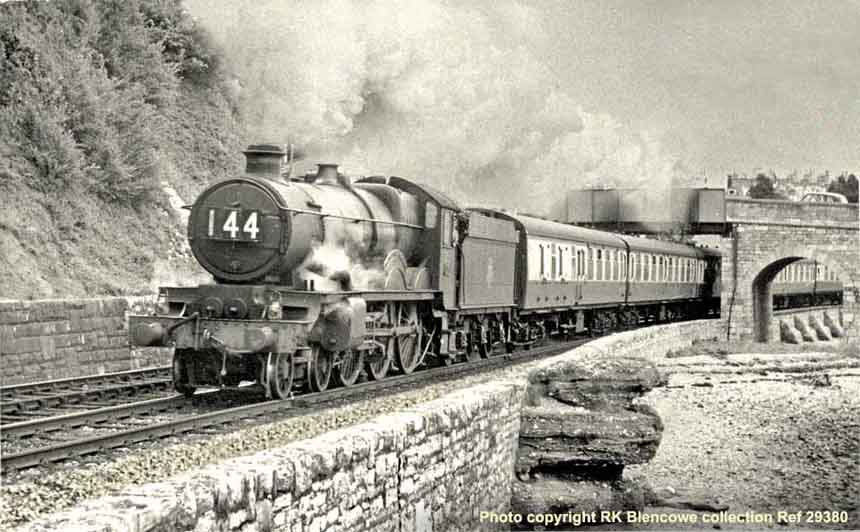
(Above) On Wednesday 14 August 1957, 'Castle' class No 5006 Tregenna Castle of Old Oak Common brings train 144, the 11.30 SX Paddington-Penzance under Shaldon Bridge on its way to Newton Abbot, 4½ miles ahead. No 5006 was built in June 1927, going first to Old Oak Common, then Bath Road, Weymouth, Landore, Canton and back to Old Oak for a four-year stint in June 1954. The engine made a record breaking run on the 'Cheltenham Flyer' in 1932, covering the final stretch from Swindon to Paddington at an average speed of 81.6mph, a speed record that led to the re-timing of the service and the accolade of 'The World's Fastest Scheduled Train Service'. No 5006 was withdrawn from Gloucester shed in September 1962 with 1.8m miles to its credit. The image was captured from the grass-covered rock formation as seen in the previous picture. Photo RK Blencowe collection, Ref 29380.
(Below) Slowing for its obligatory 2.43pm stop at Teignmouth, 'King' class No 6016 King Edward V of Laira is about to pass beneath Shaldon Bridge with the 11am Penzance-London Paddington 'Royal Duchy' on Friday 29 July 1960. No 6016 took charge of the train at Plymouth North Road, departing at 2pm and hoping to reach Paddington at 7.15pm, but with no fewer than nineteen station stops en route the journey was more of a leisurely stroll, and yet the train continued to be granted express passenger status. Photo Jim Davenport, Initial Photographics. 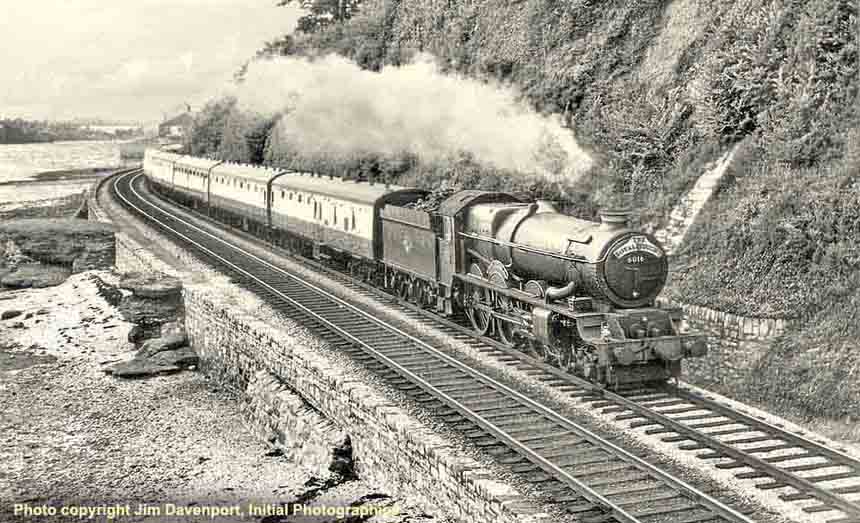

(Above) Hawksworth-designed 'County' class No 1025 County of Radnor, a longtime Shrewsbury depot favourite, was coupled on at Exeter to pilot Churchward-designed 47xx class No 4700 of Old Oak Common on the 12.05pm SO Paddington-Plymouth express on Saturday 6 August 1960. Richard Woodley informs us in the July 2013 edition of 'Steam Days' magazine - 'the load of this train was twelve to Newton Abbot then reduced to nine thereafter; also this was the last 47xx class to run on the 12.05pm'. The next day, Sunday 7 August, No 1025 headed the 10.20am Plymouth-Paddington, so the engine was working at some distance from its home base. The two engines are passing MP212¾ miles from London alongside the River Teign estuary. (Editor's note: it is worth noting that the Churchward 2-8-0 was constructed 27 years before the 4-6-0, yet it managed to outlast it by more than 12 months). Photo is by CHS Owen.
(Below) 'Hall' class No 6940 Didlington Hall of (83D) Laira and 28XX class No 2871 of (84J) Croes Newydd (Wrexham) depart Newton Abbot with the 4.25pm Plymouth Millbay-Paddington parcels on Sunday 12 August 1951. This pair will proceed to Exeter, or probably Taunton where a change of engines will take place in order to take this heavy train further to London via Bristol. It was not common to see much of this type of traffic during the daytime. Photo CHS Owen. 
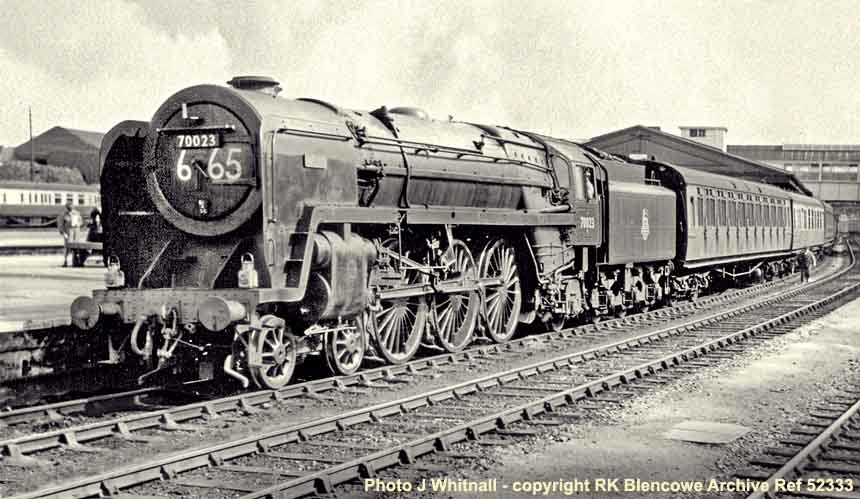
(Above) Less than one year-old, BR Class 7MT 'Britannia' Pacific No 70023 Venus of (81A) Old Oak Common awaits departure from Newton Abbot with train 665, the 12 noon Penzance-Crewe West to North Mail on Whit Monday 2 June 1952. No 70023 replaced the loco from Penzance at Plymouth North Road. The neat 665 is testimony to the care of the railwayman at Laira who always handwrote the Reporting Number so carefully. The date is Whit Monday 2 June 1952, which explains why today the first carriage is not a TPO coach, did you notice that? The coach is a Churchward 70 ft 'Concertina' named so because of the recessed doors. Photo J Whitnall, RK Blencowe Archive, Ref 52333.
(Below) 'Modified Hall' class No 7929 Wyke Hall of 82B Bristol St. Philips Marsh shed and a third series Mogul (2-6-0) class No 6330, of 85B Gloucester since 1952, are about to depart Newton Abbot with the southbound 'Devonian' for Paignton on Friday 27 June 1958. Derek Frost tells me it is believed that the next duty for 6330 was the following morning's 8.30am SO Paignton-Macclesfield, one of the dated trains that ran from Devon to a different destination on the London Midland Region each Saturday as train 546. No 7929 was the last 'Hall' constructed in December 1950, fully 26 years after the prototype No 4900 Saint Martin appeared. Photo Jim Davenport, Initial Photographics. 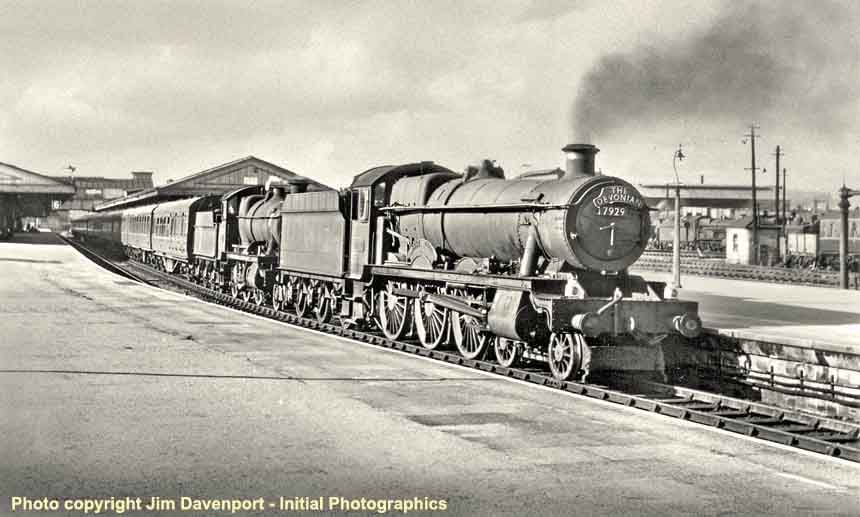
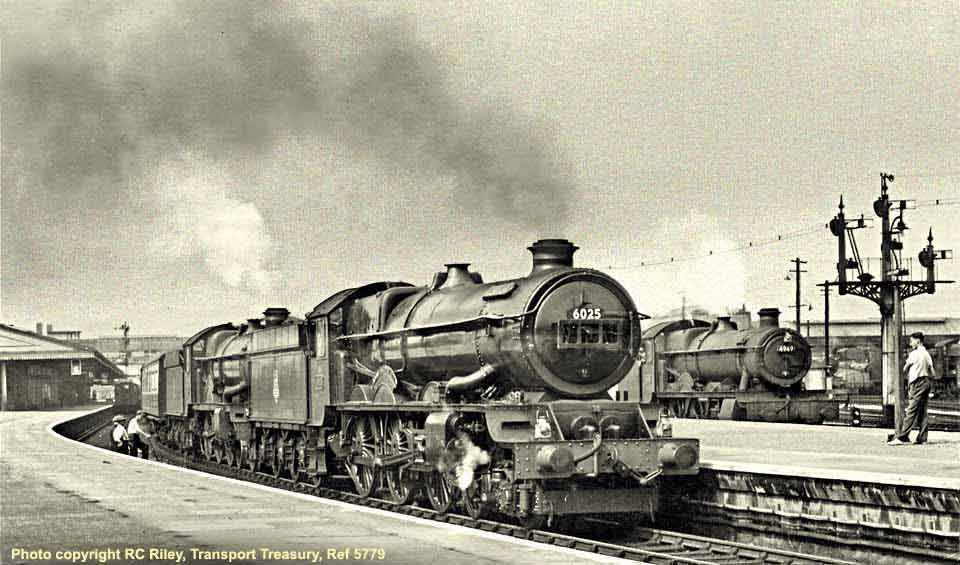
(Above) This expansive scene is at the west end of Newton Abbot station as Laira's resplendent 'King' class No 6025 King Henry III and 'Castle' class No 5058 Earl of Clancarty are ready to leave on the heavily-loaded 11.30am SX Paddington to Penzance on Thursday 14 July 1955. On arrival at Plymouth both locomotives will be uncoupled and a rear portion ot the train detached, leaving the remaining part of the journey to Penzance in the hands of a fresh 4-6-0 engine. Nearby a 'Hall' class No 4949 Packwood Hall of Taunton shed appears on a down semi-fast, while several workmen are checking the nearside track. The roof of the large shed building is visible on the right, along with another five engines. Photo RC Riley, Transport Treasury, Ref 5779
(Below) Quite amazingly, WD 'Austerity' class No 90544 emanates from (86A) Newport Ebbw Junction, where the 2-8-0 was usually to be found working long coal trains. I am not sure how far and wide these engines travelled, but here it is at Newton Abbot in May 1953, just moving away from the coaling stage. Built in 1943 for the War effort, the 2-8-0 worked from Hull Springhead (HLS) and at Colwick (CLK) under its initial number 77075 from 1947; it gained its BR number in May 1951 and found work in South Wales soon afterwards, The class of 733 engines saw service all over BR, with a total of 76 engines at WR depots being used exclusively on freight, until being transferred away at the end of 1962. Photo J Whitnall, RK Blencowe Collection Ref 52402 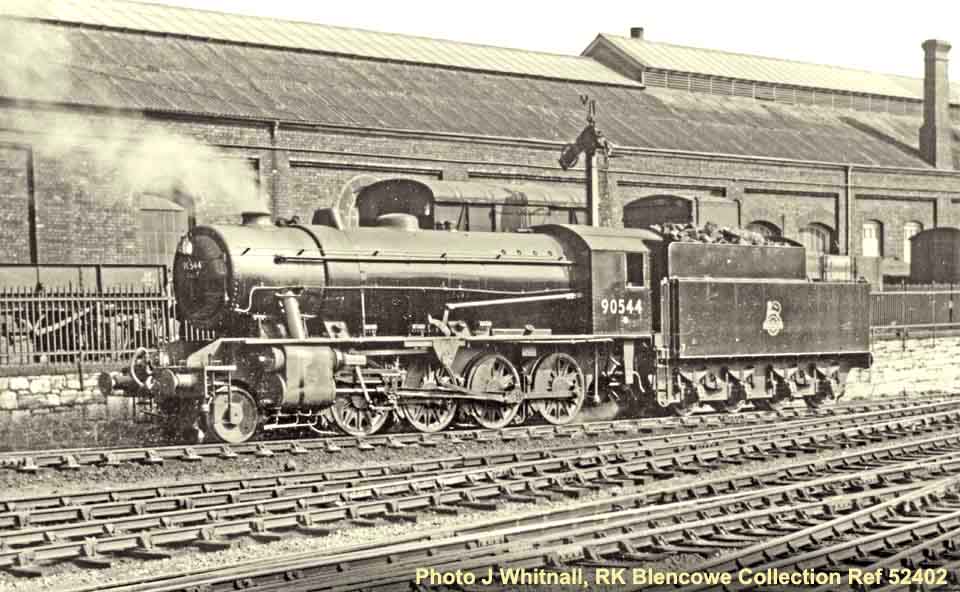
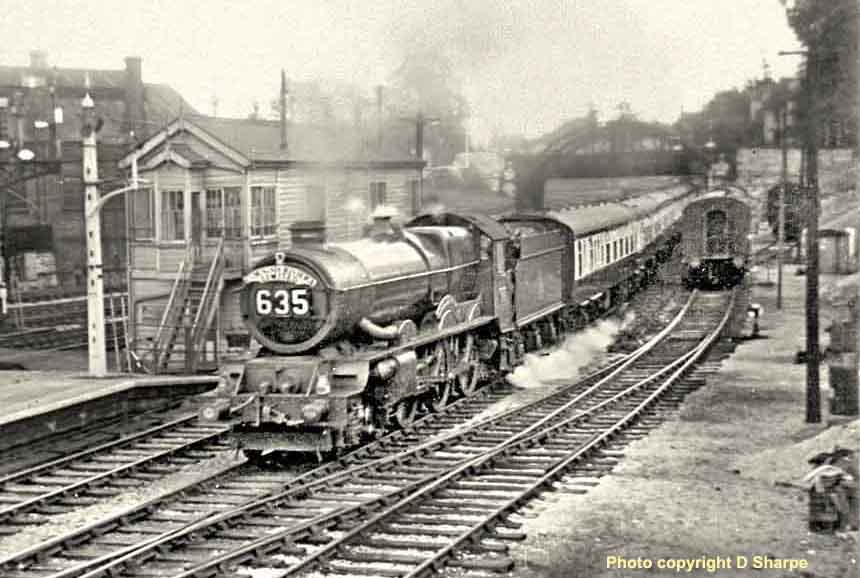
(Above) 'King' class No 6015 King Richard III, a veteran of (81A) Old Oak Common, heads the up 'Cornish Riviera Limited' (during the short time it was so called) through Newton Abbot station on Wednesday 18 July 1956. No pilot engine is used today, nor is there a stop for passengers made here or at Exeter, so it is hoped to reach Paddington, 193¾ miles away, by the due time of 4.40pm. (Editor's note: 1956 was a very bad year for the indomitable 'King' class, as each member was taken out of service in January for essential leading bogie repairs). Photo D Sharpe. (Editor's note: more pictures of Newton Abbot will be featured on the next GWW-4 page of the journey to Plymouth North Road, to be announced shortly....).
PLEASE NOTE - WE DO NOT SELL PICTURES OFF THE PAGE
THE SOURCE OF PHOTOS CAN BE FOUND BELOW
RK BLENCOWE
My thanks to Rod Blencowe for his generous help in filling the gaps of my own collection. Over the years, Rod's negative archive has swelled to become one the most important collections in the country; not only is the archive regarded a valuable resource for publishers, railway enthusiasts and historians, his high quality images are readily available to all collectors. If anyone requires traditional photographic prints or any other photographic services. Rod Blencowe's email address is: r.blencowe@ntlworld.com Please note this is not a 'clickable' link via Outlook Express. You will have to email manually.
SV BLENCOWE
This page also features photographs supplied by Stewart Blencowe, who has a superb archive of black & white postcard-sized photographs of locomotives from both the pre-Grouping and 'Big Four' eras. Many pictures are from his own negative collection and can only be purchased direct from him, either by visiting his website HERE or via selected railway book fairs, auctions and Open Days…the venues are listed on his website. Stewart has more than forty years of successful trading in all manner of railway items from secondhand books, photos and timetables to ephemera and railway minutia, relics, tape recordings models and miscellania. Postcard size prints can be ordered at £1.50 each including packing and postage. Stewart's email address is stewart.blencowe@btopenworld.com Please note this is not a 'clickable' link via Outlook Express...you will have to email manually.
TRANSPORT TREASURY
The Transport Treasury collection supply rail, bus, and tram photographs to publishers and enthusiasts. Many well known railway photographers have chosen Transport Treasury to care for their collections, familiar names such as: R C Riley, Dr Ian C Allen, Richard HN Hardy, Roy Vincent, John Robertson, David Idle, Alan Lathey, Mike Mitchell, Eric Sawford and W (Bill) A C Smith to name but a few. You can contact the Transport Treasury using any of the following: Telephone 01464 820717 - Mobile 07867 645410 Email info@transporttreasury.co.uk or by post to: The Transport Treasury, Logie Shannoch, Drumossie, Insch, Aberdeenshire AB52 6LJ...or visit the Transport Treasury website HERE
GREAT WESTERN TRUST
The Great Western Trust (GWT) (Registered Charity 289008) was established by the Great Western Society (GWS) in 1984 to conserve and display artefacts and memorabilia of the GWR collection at Didcot Railway Centre. The vast majority of the collection has been donated by visitors or by GWS members and spans the period from 1833 (the First GWR Share Prospectus) to 1977 (withdrawal of the BR Western Region's Diesel Hydraulic locomotives). The Trust's photographic collection is vast and comprises images in both black and white and colour covering the Great Western and other British railway companies. Full details can be obtained from the Hon Photo Archivist c/o Didcot Railway Centre, DIDCOT, Oxfordshire England OX11 7NJ. Please enclose a stamped addressed envelope.
STEPHENSON LOCOMOTIVE SOCIETY
The Stephenson Locomotive Society (SLS) photograph collection is a marvellous archive of over 50,000 historic railway photographs along with more contemporary images. The SLS list was previously only available to SLS members, but from January 2016 the archive became accessible to everyone. Full contact details and price lists can be found via the links provided on the excellent SLS website HERE
LOCOMOTIVE CLUB OF GREAT BRITAIN
The Locomotive Club of Great Britain's (LCGB's) Ken Nunn Collection has been transferred to the NRM, which will make pictures available to historians and enthusiasts in due course. The Ken Nunn collection of 35mm black and white and colour copy transparencies covers British railway history from the earliest years of the LSWR, GWR, South Eastern, NER, Midland, Southern and LNWR, with views of locomotives, carriages, wagons, road vehicles, workshops, stations, bridges, people, shipping and events. Click HERE to visit the National Railway Museum's photographic collection.
LOCOMOTIVE & GENERAL RAILWAY PHOTOGRAPHS
Charles Clinker, a historian of the Great Western Railway, was so deeply disturbed by the destruction of collections of early railway photographs by FE Mackay and E Pouteau, that he set up the Locomotive and General Railway Photograph (LGRP) with the aim of preventing future collections being destroyed. In June 1939 he went into business with V Stewart Haram, who ran the sales section, and W Vaughan-Jenkins who managed the photographic side. Charles Clinker's role was to persuade early railway photographers to pass over their negatives to the care of the LGRP, which would provide prints for sale to enthusiasts. The original partnership came to an end in 1951 when Vaughan-Jenkins sold his share of the business. The archive then passed from owner to owner, including the publishers David & Charles, Real Photographs, Ian Allan Ltd, before finally taking up residence at the NRM which purchased the collection and its associated rights with the aid of the National Heritage Memorial Fund in 1992. Click HERE to visit a Guide to NRM's Photographic Collections. Details of the L&GRP can be found on page 117.
LENS OF SUTTON ASSOCIATION
As mentioned earlier, Ed Chaplin was a frequent visitor to Lens of Sutton on Westmead Road, then a Mecca for serious students of British transport. Ed purchased many wonderful old photographs from John Smith, proprietor of this specialist transport book shop. As a teenager some years earlier, Ed had bought many second-hand 00 gauge items from John Smith's previous shop at 50 Carshalton Road in Sutton. Sadly John Smith passed away in 1999, and the Lens of Sutton Association was established in 2001 to help maintain the collection and keep the name of 'Lens of Sutton' alive. The objective the Association is to make available a number of photographs from their extensive collection at very competitive rates. Lists are available at this contact address postal only: The Lens of Sutton Association, 46 Edenhurst Road, Longbridge, Birmingham B31 4PQ, or click HERE to visit the excellent Warwickshire Railways website for further details.
NATIONAL RAILWAY MUSEUM
The NRM's photos come from two main sources, the railway operating concerns and private enthusiasts. The official photographs produced by the railway companies passed into public ownership under British Railways in 1948. These images, together with those of BR's own photographers, were acquired by the Museum under the terms of the 1968 Transport Act, which made provision for the retention of historic objects of national importance HERE.
Polite notice: All text and photographs are protected by copyright and reproduction is prohibited without the prior consent of the © owners. If you wish to discuss using the contents of this page the email address is below. Please note - this is not a 'clickable' mail-to link via Outlook Express. You will have to email manually. dheycollection@ntlworld.com
TRAINS, TRAIN SPOTTING AND THE MEANING OF LIFE
There's nothing I enjoy better than a few pints with new-found friends, the odd bawdy joke thrown in, but if I happen to mention that I have a website about old train spotting days (and why not? I'm proud of it!) they take a step back and regard me as if I'm stark-bollock naked! There's no eye contact anymore...
Now I wouldn't call myself a deeply sensitive person, but I do wonder what is going on here. So let me think...are they questioning my intelligence, my manhood or perhaps I've carelessly left my flies open?
No, of course not...their sharp intake of breath is a very common knee-jerk reaction brought on by the public's perception of train spotters who are by definition dull, boring and stupid.
Now I am not going to be overly philosophical here but it strikes me that since this happens frequently nowadays I need to ask a few important questions of myself.
Indeed there comes a time when we all need to reassess our lives and reflect on our inherent quirks and fancies; perhaps take stock of our place in the world and unscramble the negative thoughts lurking inside our heads.
However, let's not get carried away by this. Life is too short to worry about what other people think; the trick is to raise the bar a notch. Adjust your personal default setting to zero tolerance levels (to match the public's perception of us) and tell 'em to sod off! After all, you only get one chance at this life so make the most of it.
Alas this is not like some men I know who mercilessly (senselessly) beat themselves up over some calamitous mistake that happened way back; perhaps they made a bad decision that ultimately altered the  rest of his life but since he can't turn back the clock, what's the point in lamenting the past? It will only grind him down...
rest of his life but since he can't turn back the clock, what's the point in lamenting the past? It will only grind him down...
Instead he should think positively about his likes, dislikes and assess the meaning of his existence; only then can he decide what he'd like to do with his future.
But then everyone has a meditative moment like this at some point in their lives. This is especially the case when you get older because one thing for certain - once you get past the big 'Six-0' you'll end up morphing into a homogenous lump and unable to tie your shoe laces.
Even worse, by the time you reach old age your head is brimful with wonderful stories that you desperately want to pass on, only there is so little time left in this world to do it...
Well, for crying out loud - all this fannying around in the twilight of life is an utter waste of time...the days, weeks and months are flying by quickly enough as it is without counting them down...before you know it you'll be forgetting what it is you're supposed to be remembering and end up being being spoon-fed in an old folks home!
(Below) Each time I look at this photo of Saltaire station in 1984, I hold my hands up in reluctant surrender - this could well be me in a few years time! Contrary to appearances, however, not all Yorkshire folk are grim 'up-north' stereotypes who wear cloth caps, shove ferrets down trousers, clog dance in streets, breed whippets or race pigeons, and live on a diet of pork scratchings. These gentlemen could well be ex-train spotters reminiscing about old times when the old--MR Anglo-Scottish expresses plied the Aire Valley route between Leeds and Skipton and local passenger services were hauled by Midland 1P 0-4-4Ts. How times have changed! The station at Saltaire was demolished soon after closure on 20th March 1965, but the service was resumed on 9th April 1984 when the enterprising West Yorkshire Passenger Transport Executive (WYPTE) financed a new station, built generously in local stone in keeping with the famous Sir Titus Salt's mill complex; the village of Saltaire is one of the finest examples of an intact Victorian industrial villages in England.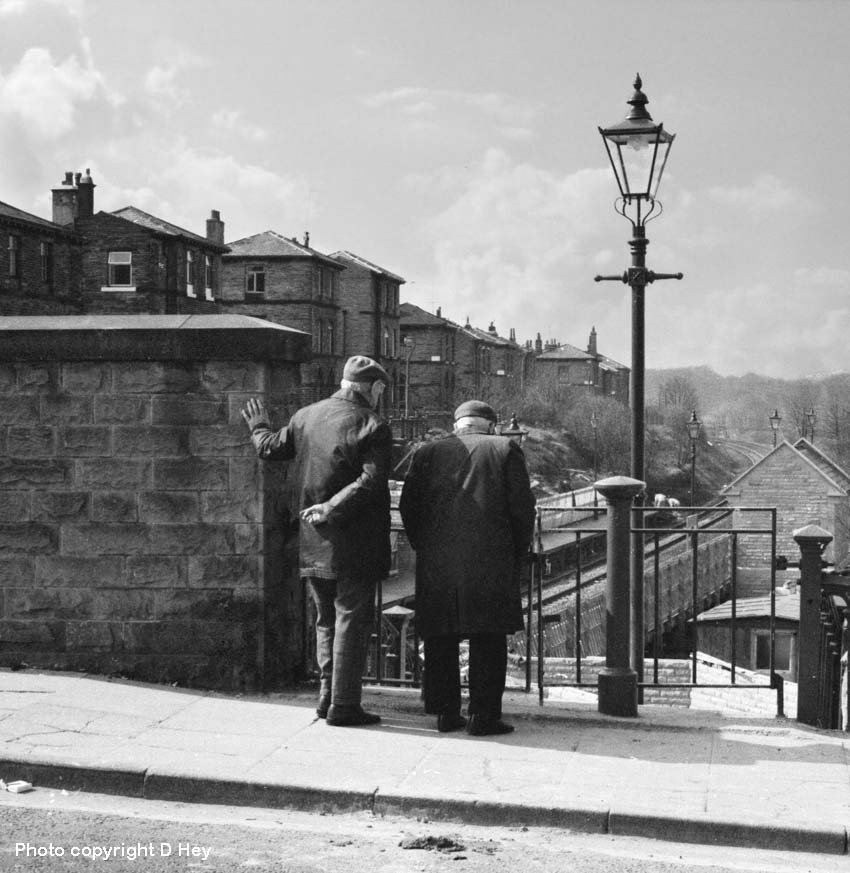
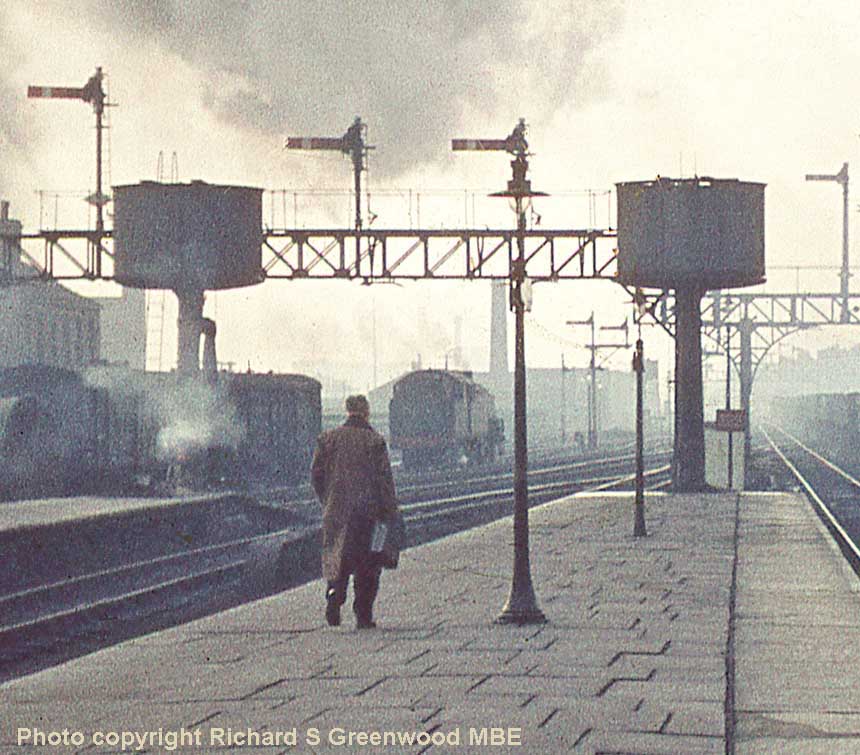
(Above) Richard S Greenwood's photo of Rochdale Station would not look out of place at the Lowry Art Gallery, Salford Quays in Manchester. LS Lowry, of course, is famous for painting scenes of life in the industrial districts of North West England in the mid-20th century. He developed a distinctive style of painting and is best known for urban landscapes milling with human figures often referred to as 'matchstick men'. In wintry weather, signalman Cyril 'Tater' Jones is seen walking home after arriving by  train at Rochdale from his place of work at Smithy Bridge Level Crossing. Out of picture on the right, an empty wagon train rumbles through the station bound for Healey Mills in Yorkshire…the full image can be seen on Richard's 'Rail Cameraman' page 53, which now contains over 120 colour shots of steam days up north. Watch this space! There are more to come!
train at Rochdale from his place of work at Smithy Bridge Level Crossing. Out of picture on the right, an empty wagon train rumbles through the station bound for Healey Mills in Yorkshire…the full image can be seen on Richard's 'Rail Cameraman' page 53, which now contains over 120 colour shots of steam days up north. Watch this space! There are more to come!
So rather than lament the passing of years I came up with a solution to the problem. Why not create a website and upload a shedful of personal anecdotes from bygone days? The site will be a thought-provoking exercise - a healthy tweaking of the last few remaining grey cells I have before the meter runs out. I could start the site with the goody-gum-drops of childhood innocence followed by the cocky optimism of adolescence. Then I'll skimp over all that cynical stuff that came with adulthood - boring! - and finish it with the grumpy foibles of old age.
And so I went ahead...and, boy oh boy - have I bumped into some larger-than-life characters along the way!
First there's Fred Wagstaff - aka Fireman Fred - a quintessentially eccentric northern bloke, with a wicked sense of humour and a serious lack of airs and graces, all of which makes a refreshing change from the risible PC culture we have today.
Just two weeks after starting his stories, Freddy contacted me via email - 'D'ya know what, Davey?' he said, somewhat surprised - 'I've got to thank you for getting me involved in this writing lark, I didn't think I 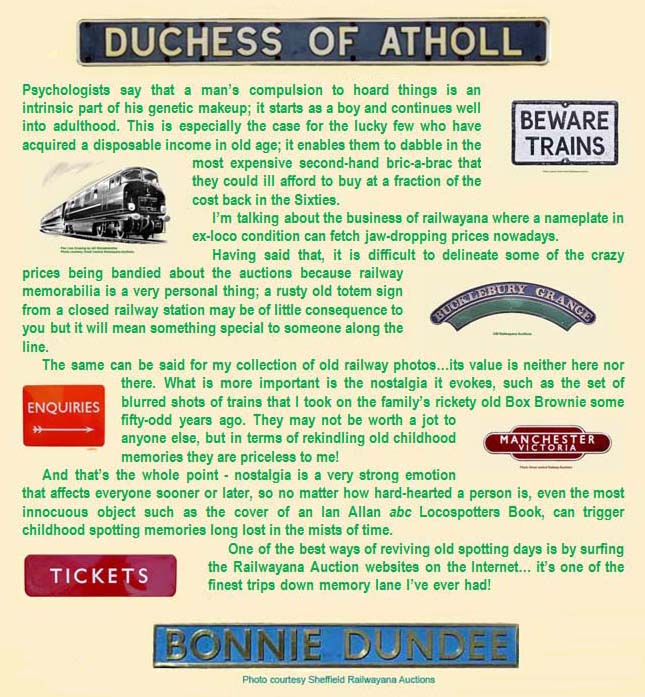 would enjoy it so much, but I am! I feel that I've been very lucky all my life and have just about achieved everything that I've set out to do. The only thing that I didn't accomplish involved Pans People and the Three Degrees and some of the most depraved and unspeakable activities it is possible to imagine!'
would enjoy it so much, but I am! I feel that I've been very lucky all my life and have just about achieved everything that I've set out to do. The only thing that I didn't accomplish involved Pans People and the Three Degrees and some of the most depraved and unspeakable activities it is possible to imagine!'
See what I mean? Compared to today's risible PC lobby telling us what we can or can't say, Freddy's outspokenness is oddly reassuring. He simply tells it as it is...
Then there's ex-BR fitter, Chris Boylan, whose ups and downs on repairing the old steam workhorse are now recorded for posterity. Chris wrote - 'David, when you first put forward the idea of a page on the Internet I was dubious at first, but I soon get the hang of it and couldn't stop scribbling!
And I mustn't forget John Stoddart, who, in discussing the outline for his 'Rail Cameraman' page, admitted to being totally buoyed-up going through old negatives and making some exciting discoveries, including a memorable 1960's ScR bash. John's 'Steam Heaven, Scotland 1964' and 'Lines Through A Life' are the best webpages of spotting anecdotes on the Internet.
Then there is the superb 'Cowpen & Blyth' page by Phil Hodgetts, whose enthusiasm for his hometown in Northumberland is infectious. Even though Phil was born long after the Port of Blyth's heydays his research into the subject is exceptional. It is encouraging to find a relative youngster investigating his 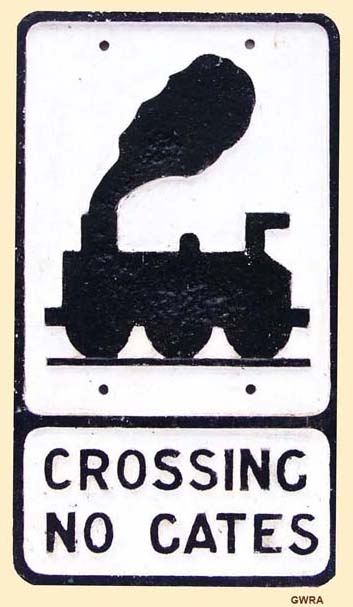 home town's place in history in such depth and sharing it with others. Phil wrote - 'At first I didn't think I'd have much to say that hasn't already been posted on the web about Blyth, but having started the page I am now at a loss for words, in the sense that I have too much to say!
home town's place in history in such depth and sharing it with others. Phil wrote - 'At first I didn't think I'd have much to say that hasn't already been posted on the web about Blyth, but having started the page I am now at a loss for words, in the sense that I have too much to say!
This brings me to Chris Carter, whose two dedication pages to his late father, 'Footplate Cameraman, Jim Carter' have been truly inspirational. What started out as a tiny seed of an idea ended up becoming an emotional journey for the both of us and we learned a great many things along the way.
Then there's Andy Sparks's observations of Britain's railways in the North-west of England during the 1970s; a fantastic trip down memory lane...so too is Roy Lambeth's page of steam days at Durham; pure nostalgia!
And then there's ex-Guildford engineman, Geoff Burch, whose love of the Southern Region shines through. After launching his first page of 'SR Enginemen's Memories', Geoff was joined by his enginemen colleagues Messrs Pat Kinsella, Dave Salmon and Alex (Mac) McClymont and between them produced a further four pages of enginemen's memories.
The fact is I'm full of admiration for everyone on this site, because they are ordinary people who have become involved in this project for it's own sake with no prospect of financial or other gain, just the satisfaction of creation...rare qualities indeed in a world obsessed with money and cheap fame...
...which brings me to the nub of the matter; over the years the site has just grown and grown and the name 'David Hey's Collection' is now a misnomer, at worst misleading. Let me be quite honest about this, there is  no way on this earth that the full contents of this site came from my own collection, it belongs to every single contributor.
no way on this earth that the full contents of this site came from my own collection, it belongs to every single contributor.
Indeed I was so concerned that I began to evaluate the sequence of events that caused the site to become so convoluted in the first place. Quite simply, growth has been 'organic' rather than planned; the site has now reached a stage where it's virtually unmanageable and in desperate need of a shake-up...
But where do I start? A site map? Yes, that's it! I'll devise a site map to show what's available...it will make the task of navigating the site a whole lot easier.
Then I'll build up a profile of the visitors to the site.
Okay, that won't take long! Visitors can be broken down into three main categories: the person doing research for a particular project, the person looking for a good old fashioned nostalgic wallow and the hardcore railway buff interested in every minute detail of every permutation of every aspect of railways, the kind who would surf the site for days on end and probably not care where they end up.
Right, now that's done - what next? I haven't a clue!...and really, what's the point? After all, this is a hobby, pure and simple, the site is too far gone to start making wholseale changes.
So I'll leave things just the way they are....which is a relief, especially at my age. I may be able to remember vividly what I did fifty-odd years ago, but I instantly forget what I did just a few minutes back. Just the other day I found myself standing in the kitchen forgetting why I was there... oh, come on - we've all done it! You  haven't? I don't believe you. Forgetfulness is par for the course for senior citizens.
haven't? I don't believe you. Forgetfulness is par for the course for senior citizens.
But on a more serious note, when it comes to dipping your toe into this murky whirlpool of nostalgia be prepared for all manner of things bobbing to the surface...the good, bad and the ugly - the sort of things you've shoved purposely, or unconsciously, furthermost to the back of your mind.
However, the main reason for this website is to unravel the mysteries of train spotting to the hoi-polloi; not only will it reveal the complexity of the hobby in its truest form, by adding some great photographs it will showcase old spotting days in the brightest perspective. After all, train spotting was the closest I ever came to understanding the meaning of life.
At least it'll give the legion of po-faced anorak-bashers something to grind their teeth on...




